Najma's Travel Blog - Welcome. This blog began when I enrolled in the course "Being and Becoming - Pediatrics in the field of Craniosacral Biodynamics and prenatal and perinatal Therapy" held in Spain 2012 to 2014, travelling to numerous countries during that time. The journey has continued since then. I am a travelling craniosacral practitioner, now living in Ravenshoe in northern Australia!
Don't wanna be here? Send us removal request.
Text
Winter 2021 - The Laura Quinkan Indigenous Dance Festival
May 2021 to September 2021
When I sold my home in Mullumbimby and moved north, all my craniosacral clients were devastated. I told them: “Don’t worry - I shall return every May and September and give sessions and visit my grandchildren. I will email you when I know I am coming!” This was my first trip back since moving to Ravenshoe, and I was pretty much fully booked before I my arrival! I worked from Living Yoga Sanga, in Mullumbimby for 2.5 days a week for 4 weeks, and I was busy!

Notice regarding Covid-19 Vaccine at Living Yoga Sanga
All the practitioners met to discuss recent issues arising from the Covid Vaccine, and this notice was put up for all users of the space. It became a point of contention amongst the general public at the time, but a year on as I write this it has been proven to be true. I think we acted in a prudent and timely way.
The first few days I stayed with my son Jay and his little family, and first thing on my agenda was to purchase a new car. I had kept a modest sum aside when I sold my house, and now was the time. With Jay’s help I found a 2013 model RAV4 with low kilometres on the clock. As much as I loved driving the Purgeot, she was a 2004 model and her days were numbered.
The second week I stayed with my ex-neighbour Kumari. Not much had changed in the compound (as we used to call it) and I was relieved to see my favourite trees were still standing. Kumari tells me the new owners are lovely people, however we missed our close friendship, the many cups of tea, our hand holding through the inevitable trials and tribulations of family life. It is hard when friends move away.
The next week I moved up to Kittani to my friend Anne’s home - you remember her from the previous blog when she helped me settle into my new home in Ravenshoe. Friends like that are gold! We have such fun together - long chats, fine food, sharing and caring. While I was there Anne made a killer batch of Hot Chilli Sauce, harvested from her garden. And yes, I got to bring a bottle home to Ravenshoe! Thanks Anne.

A killer batch of Hot Chilli Sauce
During my final week I am the honoured guest of my long time friend Susanna in her rather gorgeous AirBnB apartment with the to-die-for view of the stunning sweep of Byron Bay from the Cape all the way north to the Tweed. I was pinching myself! On the 26th of that month Anne came over to watch the Full Moon Lunar eclipse from my little apartment. Grant and Susanna joined us for champagne and nibbles.
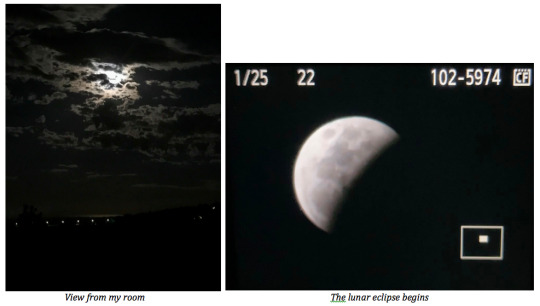
What a surprise! On the same day my granddaughter Emily was featured on the front page of the Cairns Post, showcasing apprentices and debunking the men only image! She is a star (mind you I am a bit biased)!
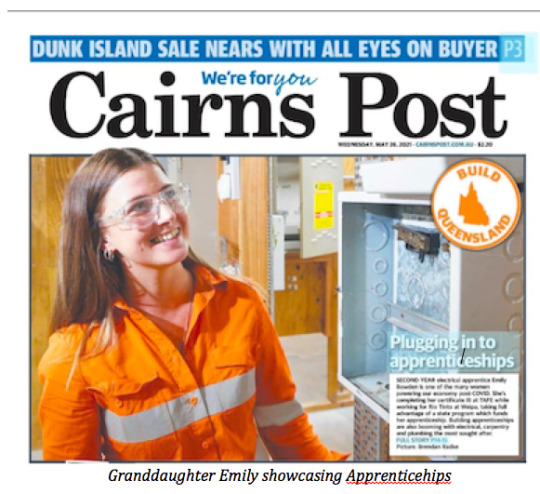

After finishing my work at Living Yoga Sanga I stayed in Byron Bay for one more week, treating myself to some sessions and some ME time.

The last weekend I spent with Jay and Holly and the kiddies, and proceeded to finish a gardening job I had started when I arrived - turning their front garden into a welcoming space for the kids to play, cutting back bamboo grass, weeding and mulching. It was a satisfying project because I was imagining my grandchildren playing in that space.
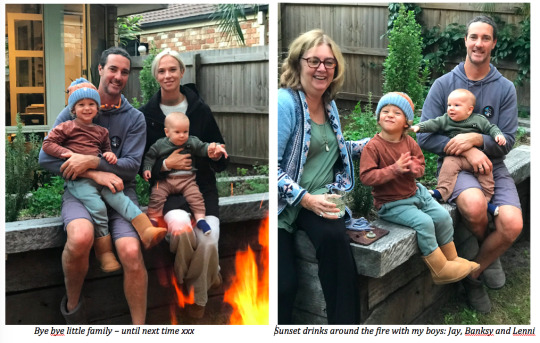
I left Byron on the 7th of June, loaded up with my favourite foods from 2Die4 Live Foods, jars of Mullumbimby Honey, Aldi buys (there are no Aldi stores north of Rockhampton), Source Bulk Foods whole foods, BrookFarm products and more - all things I cannot purchase in Ravenshoe. Byron Shire is the home to many awesome businesses leading the way in the alternate “slow food” scene. It’s a happening place, but it was time for me to leave. The new car travelled like a dream.
Memories to take with me:
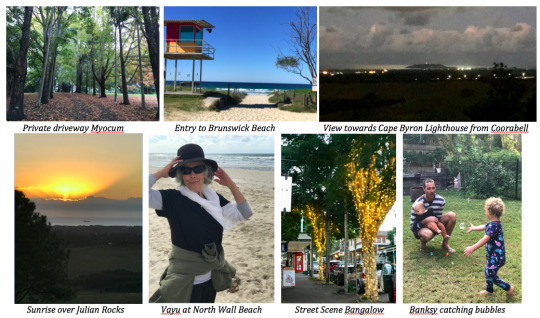
It was a slow trip back up the coast, stopping off to see family and friends on the Gold and Sunshine Coasts, and giving cranio sessions! I more or less retraced my steps, stopping overnight in Rockhampton and Bowen.
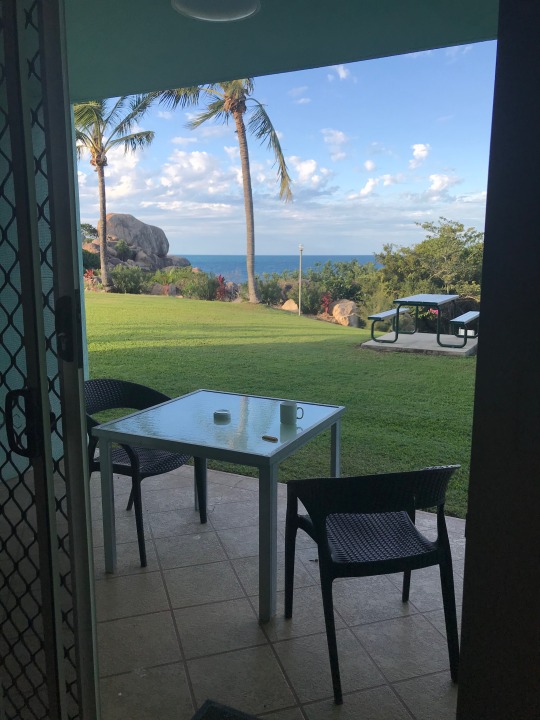
The view from my room at Whitsunday Sands Resort, Bowen
Bowen is one of the very few places along the entire Queensland coastline where you can simply walk off the beach and plunge into a magical marine wonderland on the fringe reef. At Horseshoe Bay I discovered a novel art installation: underwater sculptures! Just 2.5 metres down, snorkelers can explore Bywa, a 3.2 metre high underwater sculpture of concrete and steel that forms part of the Whitsundays Ngaro Underwater Marine sculpture trail.
Indigenous artist Brian Robinson's Bywa sculpture tells the story of Bywa or Waterspout in Kala Lagaw Ya language from the western Islands in the Torres Strait. According to mythology waterspouts are the vessels that carry marine animals up into the heavens for the spirits and ancestors to feed on. Waterspouts are a rare natural phenomenon. A closer look at Bywa reveals it is rich with marine animals common to Bowen waters - Turtle, Coral trout, Mangrove jack, Trevally, Parrotfish, Surgeonfish, Butterflyfish, Sergeant major, Tropical rock lobster, Stingray, Epaulette shark and Wobbegong shark.

The team at Reef Ecologic monitor the interactions of marine life with the artwork, and reef life is beginning to encrust the sculpture. Juvenile cardinal fish were seen using the artwork as a refuge.
Late afternoon light show by Mother Nature:


I arrived home in Ravenshoe on the 13th of June, just in time for the rapid arrival earth side of Jack Michael Bowden on the 17th, my second great grandchild and second child to Brad and Ash, sister to Evie!
Brad and Ash live in Weipa, but because it is a remote community, the Health Department do not allow the mothers to birth their babies there. They are flown down to Cairns to wait out the last few weeks. Having family relatively close is good for them and great for us! It allows for lots of bonding time.
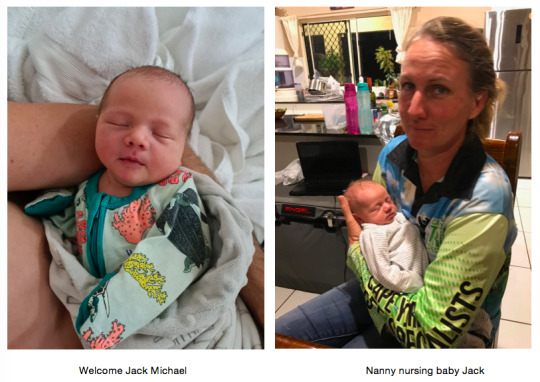
Rachael and Scott’s family have been sponsors of the Malanda Agricultural Show for ever and it is a must attend event in their calendar. Held the last weekend of June, little Evie loved the baby animal enclosure.
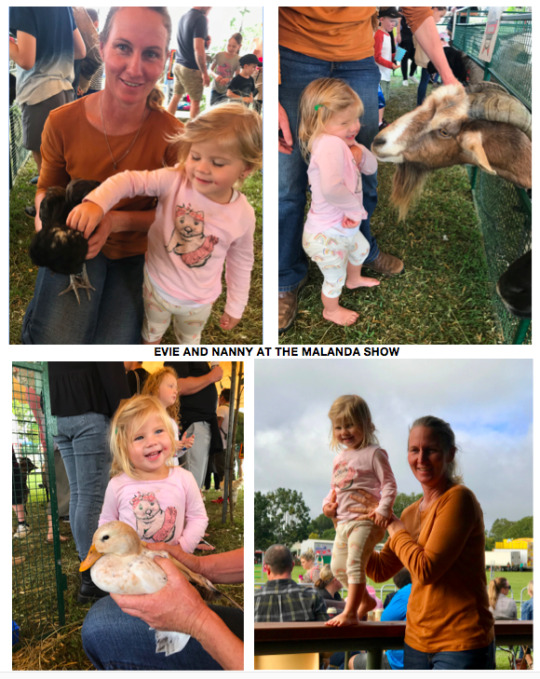
Sadly, just a few days later, Scott’s grandmother, Nana McVicar, died on the 29th June after a long illness. She had said her good byes and she died peacefully surrounded by her family. She was one of the last of the early pioneers who carved out a life for themselves in the Far North, nearly a century ago.
The Laura Quinkan Indigenous Dance Festival 2-4 July, 2021
The Laura Quinkan Indigenous Dance Festival is a 3 day camping festival, Celebrating Culture and Recognizing History
Dance troupes from across the Cape York and the Torres Strait will gather in the small community of Laura to showcase stories through dance routines, sharing history and uniting as one.
The township of Laura is the central meeting place for people from the Cape York, as well as being home to Australia’s most significant collection of rock art, it hosts another internationally recognised celebration of Aboriginal culture, the Laura Quinkan Indigenous Dance Festival.
The dance festival grounds at Laura occupy the site of a very old, traditional Bora ground. It’s a respected and sacred site. Here, people from different communities located across the Cape York Peninsula come together to celebrate with music, dance, singing and cultural performances.
The Laura Quinkan Indigenous Dance Festival is the time where families old and new meet, exchange, rejuvenate and pass on knowledge and history.
https://lauraquinkanfestival.com.au
I received a surprise phone call from my daughter-in-law on Friday morning, inviting me to the Laura Dance Festival, saying they had a free ticket and accommodation for me there. Rio Tinto are a major sponsor of the festival, and due to Covid restrictions a number of staff from interstate were unable to attend. I just had to get myself there! My three grandsons were there while mum and dad were busy on the Rio Tinto stall. I think it helped to have the extra pair of hands!!! Yay! I am the lucky one! Laura is a 4 hour drive north east of Ravenshoe, so I set off early Saturday morning, to witness an incredible spectacle. Let the pictures tell the story.
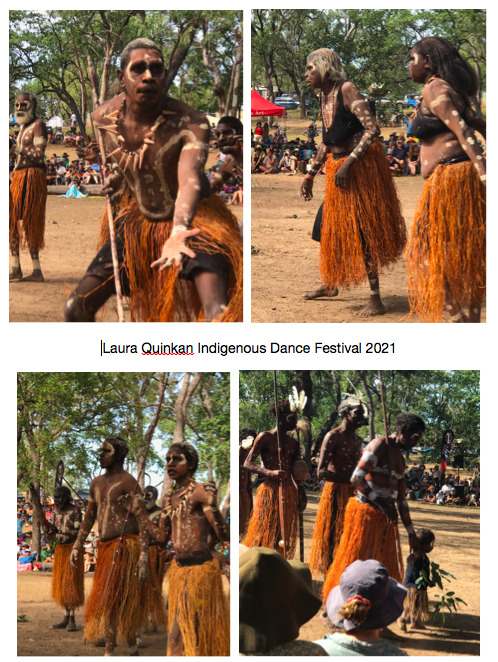
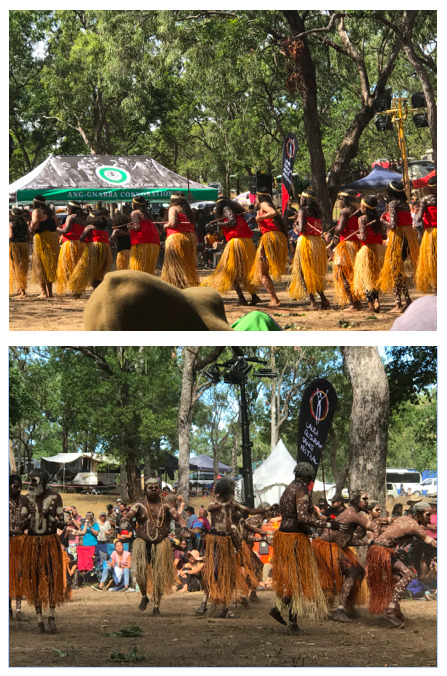
After a busy (20 cranio clients as well as my quarterly BAS clients) and social July (Laura Dance Festival, family gathering for Nana McVicar’s wake, Aaron, Janine and the kids calling through on their way home to Weipa, water divining to sink a bore, the Freedom Marches in Cairns and Kuranda), I headed back to Weipa to celebrate Aaron’s birthday, and maybe have a well earned rest.


Weipa: 29/7/21 to 19/8/21
“A rest” you think!!! Very funny! First there was the relocation of Beau’s nursery, and the repotting of numerous palms. Beau just turned 9 a few weeks earlier and he seems to have an entrepreneurial bent, so I was keen to support him making a go of this idea. I enjoyed the challenge, and I think Aaron and Janine were relieved to get some back-up.
And of course the boys are back at school so I am doing the school drop off and pick-up. It creates a certain routine for the day and week - footy practice on Tuesdays and game on Thursdays, Evie’s playgroup Wednesdays, coffee at the Community Centre with Ash on Friday mornings, school lunches, what’s for dinner? Oh no, Zeus has got out again!!! But I love it!
The day I arrived Janine asks me: Do you know how to make a Nappy Cake?
Me: No! What is a Nappy Cake? (I must be showing my age!)
Granddaughter-in-law Denica is about to fly out to Cairns to await the birth of her first baby, and Janine has realised no-one has organised a baby shower for her. So tonight is the night! A quick trip to the shopping centre while Aaron whips up a few salads - these guys are a team!

The Nappy Cake! Well done Janine!
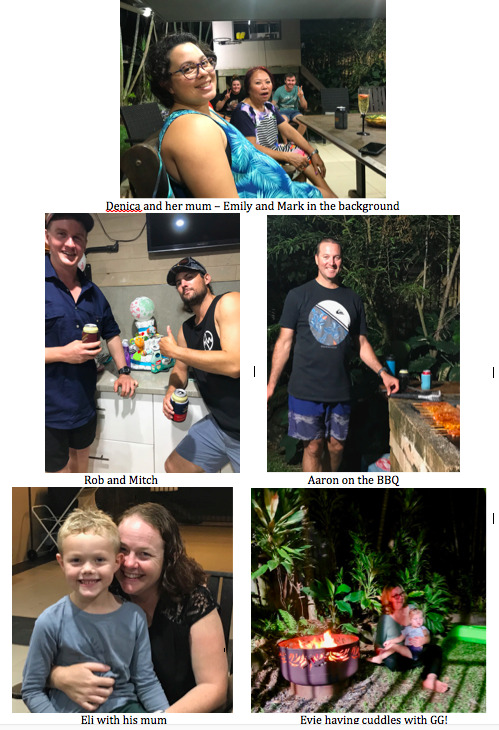
There is no rest for the wicked around here! Aaron is the President of the Weipa Fishing Classic and all year the committee have been having meetings to ensure this signature event goes ahead smoothly. The Weipa Fishing Classic is Cape York’s premier and most exciting fishing competition, with local and interstate anglers competing for a record prize pool of more than $200,000. So tonight is very important - the committee is coming over to taste test an array of wines to choose for the event! Jeez - lucky they have me here! (ha ha ha)
Of course the evening started with Aaron’s signature dish:
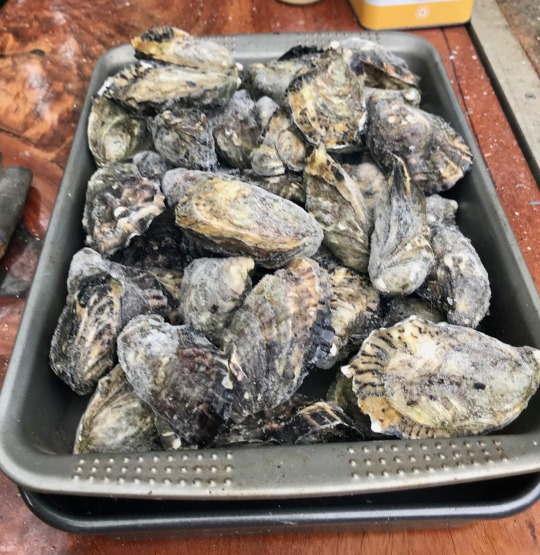
Yep - they are ginormous rock oysters from Tasmania! Aaron shows me how it is done - easy!

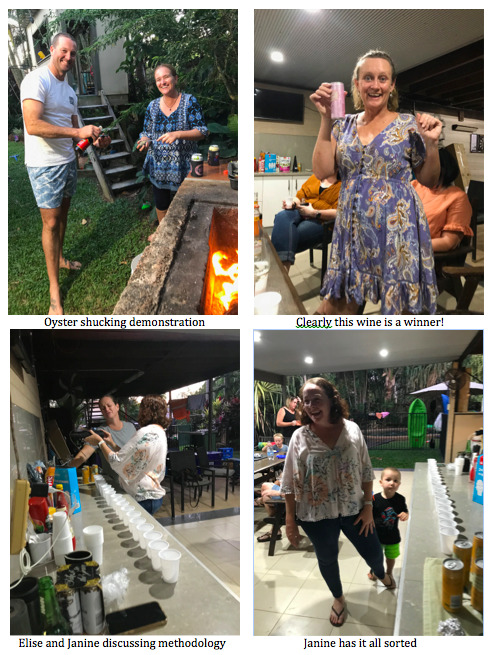
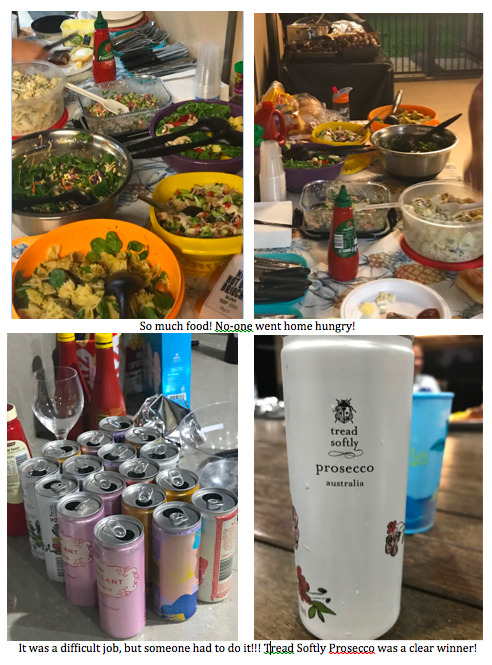
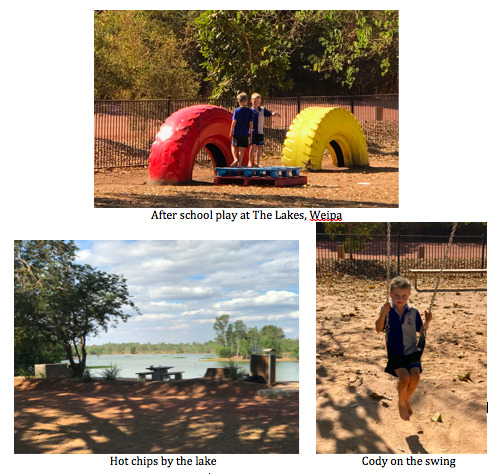

Happy Birthday Aaron!

16/8/21 Declan Bowden born
19/8/21: Visit Mark & Denica in CNS - meet Declan
23-27 Sept: Micky Memorial Ride - next blog post
0 notes
Text
January to April 2021 - Update
Goodness! My last entry was the year 2020! How remiss of me. And I have not yet written up last years Memorial Ride, while plans are well in hand for the 2022 ride. I have some catching up to do.
I left off in my previous post with leaving Mullumbimby, so this post will cover January to April 2021, covering the following:
Settling into the little town of Ravenshoe;
Micky’s court case;
Lorena coming to visit the Far North;
The road trip back to Byron;
Birthday celebrations on North Stradbroke Island

Leaving leafy, sub-tropical, Botanic Court Mullumbimby

Arrival in tropical Ravenshoe, the highest town in Queensland at close to 1,000 metres above sea level - daughter Rachael and her father-in-law Ron on hand to help unload.

My dear friend Anne standing in the front entry of my new home. She journeyed the 2,000 km northwards with me and supervised the unpacking. Friends are golden!

The stunning Millstream Falls, located just outside Ravenshoe, are the widest falls in Australia

And this is the Little Millstream Falls - a wee bit upstream of the big falls and just 5 minutes from home - a great place to recharge!

Celebrating the property settlement with dinner at the highest hotel in QLD - the Ravenshoe Hotel, with Rachael and Scott and Anne.

Dessert decadence - and why not?

The iconic Ravenshoe Hotel - Queensland’s Highest Pub!

Anne and Rachael at the Bromfield Swamp lookout - a day of sight-seeing for Anne who had never ventured this far north (in Australia).


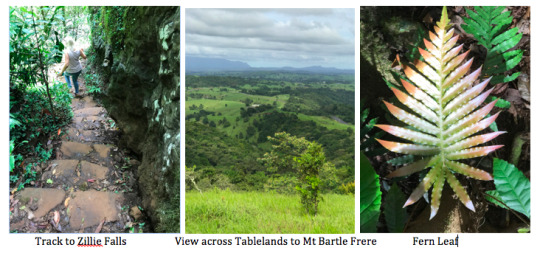
My new home - an 80 year old workers cottage in town with surrounding food forest:

The front entry ...

Back verandah ....

View of the living room through to the kitchen - natural Queensland Maple walls and Silver Ash floors.

Quarter-cut silky oak curved panelling and Art Deco features in the kitchen.

View through bi-fold windows from the back deck through to the front of the house

Farewell dinner at Nu Nu Restaurant in Palm Cove - till we meet again. Thank you Anne - you made it all fun!

Nu Nu Menu - eat your heart out!!! (www.nunu.com.au)

Cairns Esplanade - Wet Season Sunset over the inlet.

Grandsons Cody, Eli and Beau ready for the new school year in Weipa - this is Cody’s first day at school, and he is READY!!!

Meanwhile, in Geneva, Switzerland, we welcomed Baby Louie into the family on 02.02.21, - 4th child to my son Robin and his beautiful wife Stella - my 13th grandchild!
But on another note . . .
It was wonderful having Anne stay during this time - she was a true gift to my family, especially to Scott and Rachael who were preparing for the court case around the tragic hit-and-run death of their youngest son Michael in 2018. Her sage advice to Scott I think really helped him through this difficult time. Where would we be without our friends?
On the 10th of February, 2021 the family attended at the Cairns Court House for the televised hearing from the Weipa Court House where other family members were in attendance. The Magistrate said that Vincent Edwards (who attended at the Cairns Court House) showed callous disregard for Michael when he failed to stop and assist, yet she only sentenced him to just three months behind bars for this heinous act. At the time he did not come forward despite a police appeal, twice he denied involvement when questioned, and only made admission more than a week later when police found DNA evidence on his vehicle. The Crown Prosecutor said: “That someone would be left alone on a roadway to die is horrific to the general community.” The punishment does not fit the crime! The family is devastated.

Our legal and IN-Justice system is in great need of overhaul. Rachael and other mothers of sons killed in recent hit-and-run tragedies in the Far North have been lobbying politicians campaigning for tougher penalties for offenders. I believe the courts also show callous disregard to the families of victims. This was NOT a terrible accident. Vincent Edwards KNEW there was someone on the road and at the last minute he swerved to run over Michael. This was an eye witness account by the passenger in the car at the time, but it was not stated in court. That the magistrate called it a “terrible accident” is a joke - a bad one at that.

Justice for Michael!

Me with Michael’s immediate family gathering at “Muddies” on the Cairns Esplanade, awaiting the Court Case in relation to the death of their son and brother.
Back in Ravenshoe, I have been putting my stamp on my new home - out with the old fluorescent lights and in with the new!

New lights for the living room!

Spotlights in my “writing room” - aka the office!
I resumed my craniosacral practice in late February in Ravenshoe. People are finding me simply through word of mouth - which is the best advertising! I have given myself a year to settle in, and have promised my Mullumbimby clients that I would return regularly to work there as well.
Lorena’s visit:
Lorena worked with me at Hemp Foods Australia and was soon to be returning home to Mexico, so I suggested: why not come and see the north before leaving Australia and you can drive back with me in April - so she did!!!

Work mates, Lorena and Tai, from Hemp Foods Australia - Lorena met up with Tai in Cairns.
We took in some Tableland sights on the way up the range to Ravenshoe. I was not sure if Lorena would have culture shock coming to this isolated rural hamlet, but she loved the change of pace.
I introduced her to our resident artist, Sue Ryan, whose art studio was just down the road. Here she has been working on a commission for Expo Arts and Cultural Department of Dubai - a giant Hammour fish! She makes art from rubbish!
Check out this YouTube video of the project: https://youtu.be/NsHzWii8YLA

Sue Ryan and myself in her studio in Tumoulin

Before heading south I thought it was time to celebrate my arrival in Ravenshoe with a house-warming gathering of friends. She helped me prepare a Mexican themed feast with some new and old friends in attendance.

Here we are each wearing our Mexican tops!

New and old friends: L-R - Sue Ryan, Gary Burgess, my daughter Rachael, Jane Burgess, Michelle Bell-Turner, Rita Gillespie, me, Debbie Eales, Gary Eales, Greg Wilson. Lorena took the photo! Tai was a late arrival and missed the photo op!

An early morning departure for Tai, with me still in my nightie!!!
So in late April I once again headed south in my old Peugeot wagon - what was to be her last journey. She too has been retired! I timed my journey to celebrate my sister’s significant birthday, meeting up with her at the Stradbroke Ferry terminal! More on that later!
We are used to heavy rain in the tropics, but 2022 has been the wettest year on record in Australia, so needless to say our first day on the road was a doozy! The rain was so heavy I could barely see out of the windscreen. As we turned off the highway at El Arish and drove through Bingal Bay to North Mission Beach the rain eased and we found a cute lunch spot at North Mission Beach. Lorena declared it her most favourite spot in all of Queensland!

View from the verandah beachside Cardwell - rain pouring still
It was still raining hard when we arrived at Deb and Gary’s home in Cardwell - the scene above is generally one of blue seas and Hinchinbrook Island in the distance. We were so grateful to have been offered this luxurious refuge.

More like this! Hinchinbrook is still clouded in mist.
Hinchinbrook Island is one of Australia's largest island national parks, situated within the Great Barrier Reef World Heritage Area. It is separated from the mainland by the Hinchinbrook Channel whose seagrass beds are home to some vulnerable species, including dugong and green turtles. Hinchinbrook is a haven for bush walkers and for people who enjoy the quietness of virgin rainforest and pristine beaches.

The next morning I headed out to get us some coffees, only to find that we were stranded. On the main street of Cardwell there were two kilometres of parked semi-trailers and caravans, waiting it out. At least we were high and dry. We prepared to stay an extra night, but fortunately the highway opened around midday and we were able to continue our journey.

Here we are driving through flood waters just north of Ingham

Blue skies awaited us as we journeyed south. The Burdekin River Bridge spans the mighty Burdekin River between the towns of Home Hill to the south, and Ayr to the north. The source of this river is some 200 kilometres away on the Valley of Lagoons Station, a pastoral lease situated about 100 kilometres south of Mt Garnet, just west of Ravenshoe.

We were heading for Bowen for our next night - staying at my favourite place - Whitsinday Sands at Horseshoe Bay. After a leisurely breakfast at Bowen’s famous cafe, our next stop was Yeppoon, a coastal village east of Rockhampton.
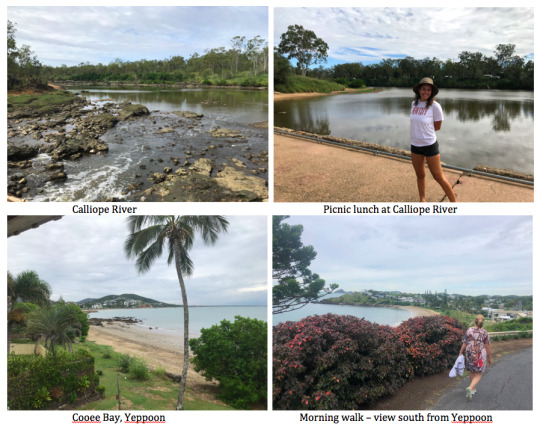
The Calliope is a favourite stopping off point for many travellers, to break the long journey between Mackay and Rockhampton. Years back when my children were little, we would camp here and swim. Now there are signs warning people not to swim here due to the presence of crocodiles!!!
We turned off the highway at Miriam Vale towards the beachside hamlet of Agnes Waters and the Town of 1770. Famously known as the birthplace of Queensland, the Town of 1770 was named after Lieutenant James Cook and his crew from the ‘Endeavour’ who came ashore on 24 May 1770. Lorena had heard of Agnes Waters and really wanted to stop here to explore the beach vibe.
This is from a tourist brochure: “Here the climate is best described as perfect, with more than 280 days of sunshine each year. Imagine swimming in crystal clear waters, unwinding on your own deserted beach, kayaking or kite surfing beside dolphins playing, sailing and bushwalking. This is the essence of Agnes Water and Town of 1770 – untouched, exclusive and pure!”

We overnighted in a little apartment in Agnes Waters, close to the beach, and the next morning enjoyed breakfast in the picturesque Town of 1770. Afterwards we did the Butterfly Walk through windswept tussock grasslands, vine thicket and coastal woodlands to the headland enjoying the spectacular views overlooking Bustard Bay. Each year between March and May hundreds of thousands of Blue tiger butterflies migrate through Agnes Water. Lorena was surrounded by butterflies but the photos don’t do it justice.
On the road once more we stopped for lunch at my all time favourite cafe - Insane Caffeine in Childers.

They have the best array of cakes - the Persian Love Cake would have to be my favourite!!! I bought some to share with Byenae who was hosting us that night at Chevallum on the Sunshine Coast. Byenae and I go back a long way, and whenever we see each other we talk and talk, usually over a glass of wine or two!!! But my date with a ferry was set, so the next day it was time to say goodbye to Lorena. I dropped her off with friends over the border in Byron Bay, before heading northwards to meet up with my sister at the Stradbroke ferry.
What a treat - three days of luscious accommodation at Point Lookout with Margie and long time family friend Jo, sister-in-law to Susie who you met in earlier blog posts.

It was so relaxing having these few days, strolling the beach and exploring the island.

This was the view from our apartment, which is part of the Point Lookout Hotel. Very grand!

Happy birthday Margie!
We dined at the hotel restaurant that evening, and afterwards Jo introduced us to the Korean drama “Crash Landing On You” on Netflix, which we binged watched until the early hours!!! It is a bitter sweet love story. Once back home I binge watched the rest of the series!
Thank you Margie for including me in your birthday celebration. It was such a treat to be with you and Jo for those days. Banking memories!
0 notes
Text
I am a Covid Refugee! (Part 3)
30.09.20 to 20.11.20
Well, family celebrations are over and soon I too will be on my way south. Life is about to change, and I had no idea it would be so fast!
My friend Jenny has said she will give me first option on purchasing her beautifully restored timber cottage in Ravenshoe, but first I will have to sell my house in Mullumbimby. It is all a bit daunting, and exciting at the same time.

Subtropical lusciousness - vegetation surrounding my home in Mullumbimby
Crossing the border into NSW on the 11th of October was no drama, and the very next day I was back at my desk at Hemp Foods Australia in Bangalow. Four days later I signed a real estate contract to market my home, with the first open house to be on Saturday the 31st of October. Yikes! You can imagine the frantic energy that ensued those two weeks to get it ready for the photographer. But we did it, with a lot of support from my son Jay of Jay Schleich Constructions. In the middle of all this frantic energy, baby Lenni landed Earth-side (second son to Jay and Holly) with not as much drama as his big brother caused. Can you believe it? He is installing my new front door then races off to become a new dad!

Jay and Lenni enjoying a well earned rest! It even looks like Lenni is smiling!
I must say I am so happy to be a part of this little family’s everyday life. Although my work keeps me busy 6 days a week, I generally manage Friday nights and Sundays with them as well I am often cooking up little treats for the little family..... just another one of my many hats!

Banksy cooling off in his play corner while Holly looks on

Jay with new born Lenni - Jay has just come off the massage table (in the background) so he looks slightly dishevelled!

Toasting the new arrival - welcome baby Lenni - my 12th grandchild!
My beautiful house is going to auction on the 15th of November, a new moon, which happens to be Diwali, the Festival of Light in India. This festival, dedicated to the goddess Lakshmi, is considered by Hindus to be one of the most important and joyous festivals of the year. It is the celebration of the victory of light over darkness, good over evil and knowledge over ignorance. It is said any business transacted on this day will be auspicious. Diwali also marks a major shopping period, since Lakshmi connotes auspiciousness, wealth and prosperity.
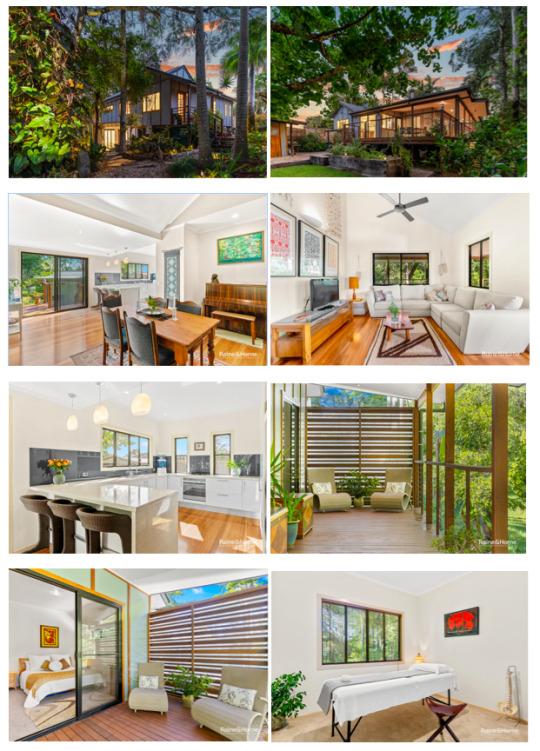
These photos represent twenty years of loving inspiration, designing and building my dream home (given the usual financial constraints) on the banks of the Brunswick River in Mullumbimby in the beautiful Byron Shire. I created (with help of course) a two bedroom, one office home with a self contained studio underneath, bespoke garden shed and landscaped gardens on a 930 sq mt block adjacent to a park and river reserve. Private, quiet, five minutes drive from the centre of town, fifteen minutes drive to the beach, forty-five minutes drive to an international airport. What is not to love?
I moved in on 01.11.2000 and sold on 15.01.2021.

Well, the goddess did her magic, and settlement is the 15th of January. So I have two months to pack up my life, retire from Hemp Foods Australia and relocate to Ravenshoe in Far North Queensland. I will be leaving my son and his family in Byron Bay but I will be moving closer to my daughter and her family in Ravenshoe. My intention is to become the travelling Nanny and the travelling craniosacral practitioner. I am sure you will hear more about this in future posts.
Goodbye Mullumbimby! Hello Ravenshoe!
0 notes
Text
Micky’s Memorial Ride 2020
Ravenshoe, Koombooloomba Dam, Goshan Station, Blencoe Falls, Herbert River Gorge
24th September to 28th September 2020
Day 1:
Family and friends gathered at the Bowden family farm outside Ravenshoe in preparation for the five day camping holiday exploring the diverse highland forest country to the east, west and south of Ravenshoe.
Bikes:
Bowden Farm to Telecom Hill via bush tracks
Met at Ravenshoe Cemetery for group photo
Tumoulin State Forest to McKenzie Falls, lunch at Ravenshoe Bakery
Wooroora Road to Bally Knob, Tully Falls, then Koombooloomba Dam

Family gathering preparing for departure from the Bowden’s farm

Riders depart from the Bowden Farm, Millstream
They travelled from Townsville, Tully, the Atherton Tablelands, Charters Towers, Weipa, the Sunshine Coast and Mullumbimby, to be here for the second Memorial Ride to celebrate the life of Michael Bowden, who was tragically taken from us, his family and friends, way too soon.

“How can the light that burned so brightly Suddenly burn so pale? Bright eyes”
The riders departed to trail bike around the hills surrounding the highest town in Queensland, and met up with everyone at the Ravenshoe cemetery.
Telecom Hill is right beside the cemetery and we could hear the bikes coming long before they appeared. The first riders in, Michael’s brothers Mark and Brad, rode standing into the cemetery as a salute to their little brother. Michael’s father Scott was riding Mick’s bike. It was a touching and emotional time for all the family.

Lead riders arrive in salute at the Ravenshoe Cemetery

On arrival the riders lined up behind Micky’s grave in his honour

Paying respect - Scott and siblings Brad, Mark and Emily

Scott and Rachael with granddaughter Evie Uncle Aaron Schleich

Michael’s brother Brad with daughter Evie

Cousin Hayley with Mick

All of us at Micky’s grave. We like to think he was hovering somewhere above us!
The riders then departed to explore the Tumoulin State Forest and the stunning McKenzie Falls. The multi-tiered McKenzie Falls lie deep within the Millstream Valley near the centre of the Tumoulin State Forest. The Millstream meanders through the forest, tumbling gently over the granite walls of the falls.

McKenzie Falls, Tumoulin State Forest
The trails in both Ravenshoe State Forest, and Tumoulin Forest Reserve are easily amongst the best in far north Queensland, and are a relatively well kept secret. The tracks are fairly remote and quiet and chances of encountering other riders is rare. But town was not far away and it was a long time since breakfast, so the riders then called into the famous Ravenshoe Bakery (”best bread on the Tablelands”) for a lunch of pies, sausage rolls and iced coffees. The riders also ensured their tanks were full before heading east as this was the last fuel stop for the trip into remote wilderness.

It was hard to miss the Bowden clan as they made their way up the street!

Riders, with bellys full, prepare to leave from Ravenshoe Central Servo for the next leg of the journey

Bally Knob rises 426 metres east of Ravenshoe with views of Ravenshoe and surrounds
They rode up Bally Knob behind the pony club, and enjoyed the view overlooking Ravenshoe township, then continued on to Koombooloomba Dam, stopping at the Tully Falls Gorge along the way.

Tully Falls Gorge lookout - The falls only run in a big wet season, but the walls of raw rock and rainforest which plunge 300 metres (984 feet) down to the Tully River are still an awe-inspiring sight.
Riders and support people met up at the Koombooloomba Conservation Park camping area where we camped the night.

Fellow grandparents to Beau, Eli and Cody, Gwen and Lionel Brady from the Sunshine Coast set up camp at Koombooloomba Dam, eagerly awaiting the arrival of the riders.

Exploring Koombooloomba Dam with Nick “Brooksie” Brooks

Cody and Ashton from Weipa in the canoe

Bonding time for Josh and Kayla on the edge of the dam
The kids enjoyed exploring their new surrounds and swimming in the dam. It was a big first day! Everyone was happy to have an early night.
Day 2:
Bikes:
Koombooloomba Dam to Goshen Camp via Wall Creek Road, the Red Road, Ben Avon Station, Yorka Reserve and Kirrama Range road to Goshen Station.
Support vehicles:
Koombooloomba to Mt Garnet
Gunnawarra Road to Goshen Station
What a glorious day! What luck!
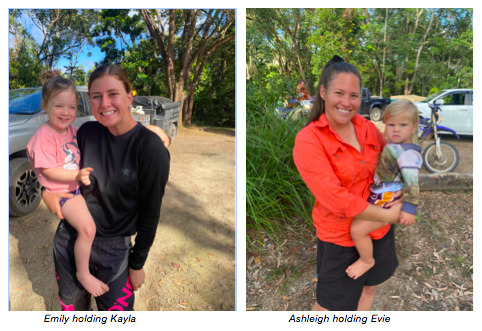

Emily and Rob at Koombooloomba camp site

Practicing the log jump

Hayley GoPro ready and set to go!

The Charters Towers crew! Jamie and Corinne Hetherington, Joshua Venning, Josh Jones, Kym Venning, Hayley Bowden, Josh with young William

Riders setting off from Koombooloomba Dam
The riders departed at 8am. Family friend Gary Haines (Hainsey) and his partner Tracey followed the bikes through in his trusty old Hilux and pulled up on the Blenco Creek crossing and prepared a BBQ lunch for the riders, with Hainsey supplying the beef. The ride was not without incident though.
11 year old Kaleb from Charters Towers hit a tree on a bend! The tough little fellow brushed himself off, jumped on his bike and kept riding! Later we found out that he had fractured his wrist and was in a cast for six weeks!
Also, Kaleb’s auntie Hayley Bowden, nearly rode off a bridge! Details are hazy but the photos tell the story!

Hayley! What happened? She is still standing - so it is OK!
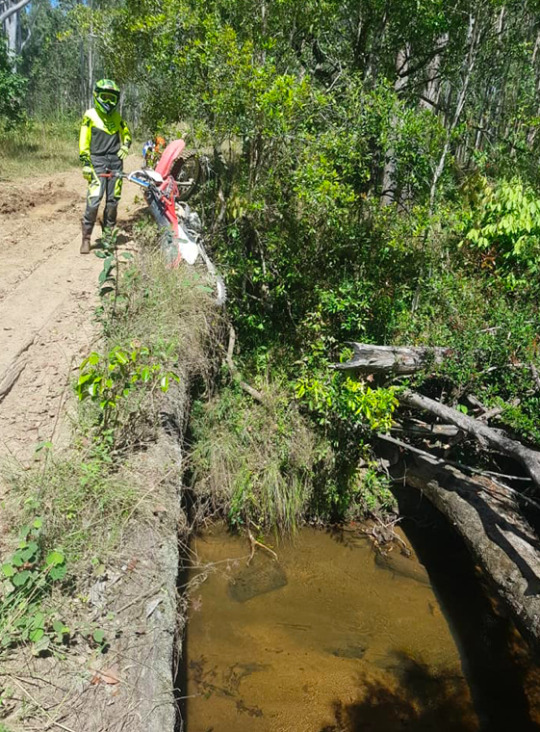
OMG that is quite a drop! Lucky!!
Scott says, she was lucky: “She nearly took the creek crossing instead of taking the bridge!”
Meanwhile, the support vehicles travelled west to Mt Garnet, fuelling up and getting ice (most important when going bush), before turning south onto the Gunnawarra Road.

The Gunnawarra Road
Perhaps the most outstanding feature of Mount Garnet is the cattle stations surrounding the town: Gunnawarra, Glen Eagle, Glen Ruth, Goshan, Kirrama, Minamoolka, Weona, Wairuna, and Princess Hills to name but a few. Scott and Rachael have mustered cattle on a number of these stations, as well Scott cut hardwood timber fence posts here for many years. We were regaled by many bush yarns about their working in them there parts. More about that later!

The Kirrama Range Road, from Cardwell on the coast to Mt Garnet, is an alternate route to the Tablelands that few people travel due to the rugged terrain. It forms part of the southern region of the Wet Tropics World Heritage Area.
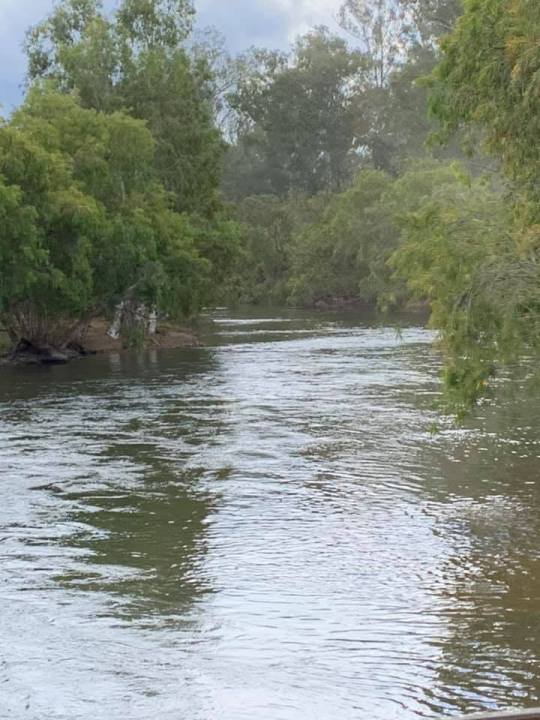
View downstream from Cashmere Crossing on the Herbert River
Some Herbert River history:
Just a bit about the Herbert River flood at Glen Eagle:
Glen Eagle is situated on the bank of the Herbert River a few miles above the Herbert Falls. In 1927 a flood in the river rose to a height of 52 feet and was lapping at the steps of the homestead. This was the highest flood ever recorded until 14th March 1967 when a large rain depression swept in from the Coral Sea.
At 11 a.m. the river had reached the 1927 level and the Blakeneys decided to vacate the homestead. The rain gauge showed that 12 inches had fallen in the past 24 hours but as it was still raining heavily no accurate measurement was ever possible. The family loaded their Land Rover and set off for higher ground to the west of the river.
They had travelled only a few yards when the vehicle became hopelessly bogged. They quickly attached a tractor and so two vehicles were saved. Shortly afterwards the water in the river rose to over 75 feet and the homestead and outbuildings, including a good deal of machinery, a car and a 6 ton truck, were completely swept away. All that remained at the site were the concrete floors.
Tableland Tin on Return Creek near Mount Garnet sent a telegram to Mr Blakeney advising that their big dam had been swept away and to expect a large flood. Due to the weather, the message was not received until some days after the flood. The Blakeneys then built a new homestead for Glen Eagle on higher ground well back from the river.
Article by Peta O'Connor

Entry to Goshen Station south of Cashmere Crossing
Rachael had to go to Goshen to get the key for the campsite as this was private property. Support vehicles arrived before the riders and started to set up camp. We were lucky to have the whole place to ourselves. Massive thanks to Brett and Theresa Blennerhassett of Goshen Station for their generosity.

Our swimming hole

Emily and Rachael preparing snacks

Ashleigh, Evie and Poppy Scott

Happy times - Ron and Sue Bowden (Nana and Grandad) with Tracey Crawford

Brad fetching wood for the camp fire

Good job Brad!

Gathering around the campfire - one big happy family
That night around the campfire was a funny night! Josh Venning was the comedian of the group!

Sunset drone photo of our campsite, Goshen Station on the Herbert River - miles from nowhere!
Day 3:

Bikes at camp - everyone must be down by the river!
After all the riding the previous two days, it was heaven just to stay put and enjoy our little piece of paradise. It was time for us all to simply relax and chill out. It was such a great reach of the Herbert with a conveniently placed sand bar in the middle of the river, and beautiful bottle brush lining the river providing shade. The little kids had a ball, as did the young at heart!

So much fun was had by all!

Eli and Cody in the red canoe, Mark and Beau on the right

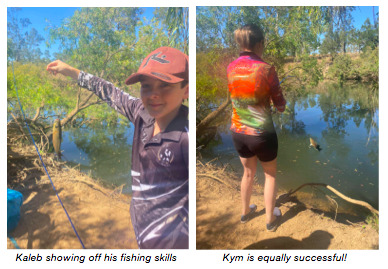
Two car loads of Micky’s friends came out from Ravenshoe to Goshen to join us for the weekend. It was so good to have the young ones with us remembering their mate. Also some more of the extended family arrived at camp - Graham (”Greenie”) and Jean Bowden from Millaa Millaa and Wayne (“Beagle”) and Colleen Bowden from Innot Hot Springs. It would have been a long drive home for them that night, but the family so appreciated them joining us. Greenie tells the best stories, and he and Scott have spent many many years camping out this way cutting fence posts together. They have a special bond, and Greenie has been a wonderful support for the family over the last few years.

Russ with son-in-law Brad, Greenie, Scott, and Micky’s sister Emily

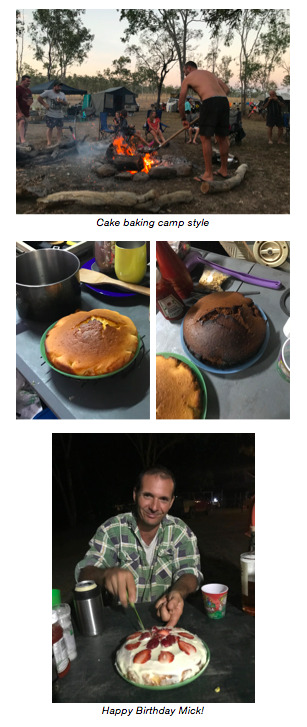
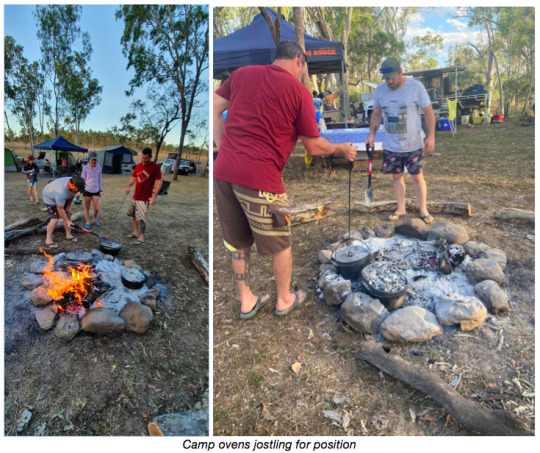

The sun sets on a mighty fine day

Bright moon - look at us with our pretty lights!
Day 4:

Dawn at camp, Goshen Station 27.09.20
Today we all donned our “Micky” shirts and travelled cross country through open savannah grasslands to the spectacular Blencoe Falls, where we gathered for our group photo.
Girringun National Park is home to Blencoe Falls and, while not widely known, the falls are rated among some of the most spectacular in the country. They cascade, seemingly in slow motion 90 metres to a pool below, where they fall another 230 metres to the base of the Herbert River gorge.

Stunning Blencoe Falls
Standing tall and regal, hoop pines Araucaria cunninghamii are a distinctive feature of the landscape around Blencoe Falls. A long time ago, when the world was warmer and wetter and dinosaurs roamed the land, hoop pines were abundant. Despite dramatic changes in the climate they live on today. Sensitive to fire, they have found refuge in protected gorges and on steep slopes and rocky outcrops.
https://parks.des.qld.gov.au/parks/blencoe-falls/about/culture

My eldest two - Rachael and Aaron
Rachael’s youngest son Micky was killed in a hit & run tragedy in Weipa two years ago. He was only 20 years old. The court case in relation to this was scheduled for February 2021. The killer was sentenced to just three months jail time for having “callous disregard”, and “leaving the scene of an accident”. This annual Memorial Ride celebrates Michael’s life.
CAPE YORK-NEWS
‘Callous disregard’: Man runs over young tradie, goes fishing
The Cairns Post
February 10, 2021 4:20pm
A WEIPA father whose car hit and killed a young man lying on a dark stretch of road, before he collected bait and went fishing, will serve just three months behind bars.
Diesel fitter Michael Bowden, 20, was likely killed “almost immediately” when he was struck by a car driven by concreter Vincent Edwards, 26 on Northern Ave in the Cape York township on June 9, 2018.
The Weipa Magistrates Court heard on Wednesday, Edwards, a father of one, was aware he had hit a person, but did not stop and drove on to go fishing, despite passing an ambulance on the way.
He pleaded guilty to failing to remain at the scene and driving outside permitted hours more than two-and-a-half years after what Magistrate Jacqui Payne described as a “terrible accident” where he “ran over a person he did not expect would be lying on a darkened road”.
But she also said Edwards showed “callous disregard” for Mr Bowden, who was believed to have been intoxicated lying on the road, when he failed to stop and try to assist him.
“Even though this happened in a split second Mr Edwards knew his car had struck a person,” she said.
“(He and his passenger) continued with their plans to get bait and go fishing.
“He saw an ambulance nearby and did not approach (it).”
The court heard he did not come forward despite a police plea for help, denied any involvement when questioned twice and only made admissions more than a week later when Mr Bowden’s DNA was found on the underside of his car after a police investigation. Crown prosecutor Nathan Crane said he told police he had also smoked ice before leaving home.
“That someone would be left alone on a roadway to die is horrific to the general community,” he said.
Defence barrister James Sheridan said Edwards was forced to leave town, such was the public vilification, and he was “lost for words” after reading the victim impact statement penned by Mr Bowden’s mother Rachael.
The statement described the “horror of horrors” Mr Bowden’s family faced.
Magistrate Payne sentenced Edwards to nine months jail with parole release after three months, in early May.
The fail to remain charge carried a 12-month maximum sentence at the time of this incident, but has since been changed to three years.

All of us at Blencoe Falls, with Micky’s bike!!! Vale Michael Bowden. Life will never be the same without you in it.
Last year his motorbike was hauled over the rocks and through the sand to the tip of Cape York Peninsula - Australia’s most northerly point. This year his bike made its way into this remote wilderness, some 300 kilometres south west of Cairns.

Schleich family photo - Aaron and Janine with Beau, Eli and Cody, and Nanny and Poppy at Blencoe Falls lookout

Brad and Ash walking Evie back up the hill from the lookout

Group photo with Micky’s bike at Blencoe Falls

Ash, Evie, ‘Nanny’ and Eli with Micky’s bike - Blencoe Falls

Micky’s mates: Josh Wallwork, Tegan Brownie, Kodi Innes, Ben Moore, Nikki Coulsen, Emily Bowden, Rob Moore, Jarrod Bowden, Jordann Forshaw, Hayden Innes.
After the hot walking at the Blencoe lookout we drove a few kilometres down the road to the Blencoe Falls camping area for a refreshing dip in the crystal clear creek water.

Refreshing Blencoe Creek fun
Then, with the Goshen Station mud map in hand, we ventured back onto Goshen Station in search of the Herbert River Gorge. This is a well kept secret, even with the locals. Truly, this place is magestically stunning!

Rainbow in the gorge - photo taken from hanging over the cliff edge - not by me!!!

Emily holding Frankie, and Hayley at the top of the gorge

Too good not to climb down for a swim!

Rob Moore fishing while Mark and Brad enjoy the cool waters of the Herbert River at the Gorge

Herbert River Falls

Scott on the rocks! (Pun intended)

Drone photo with Aaron and myself at the Gorge

Chilling out back at camp
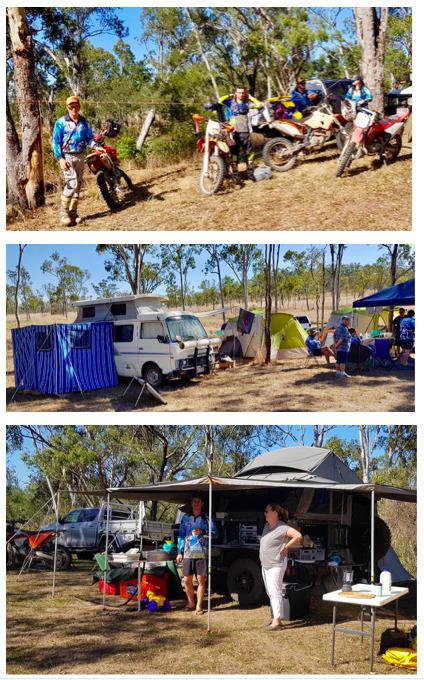
Camp vignettes

Mark Bowden looking pretty happy; in the background Poppy Pete is getting ready to return via the Kirrama Range to Hull Heads
Opened in 1941, the Kirrama Range Road was designed to facilitate the transport of timber from logging camps in the Kirrama State Forest to Cardwell. Taking three years to complete, it was considered a feat of engineering due to the steepness of the terrain and the wet climate. Today it’s a stunning drive across the ranges, with plenty to see and do, and spectacular scenery including lookouts, waterfalls, heritage-listed rainforest and swimming holes.

Last light reflections on the Herbert River
Our final evening friend and neighbours from across the river, Narelle and Brendan Lucey of Weona Station joined us for dinner. It was a brilliant last night together under the stars.
Day 5:
Goshen Station return to Ravenshoe
- Bikes via the Red Road and Koombooloomba Dam
- Support vehicles via Gunnawarra Road
All good things have to come to an end, unfortunately. Once we were all packed up, leaving the space as if we were never there, we gathered for our final briefing and farewell.
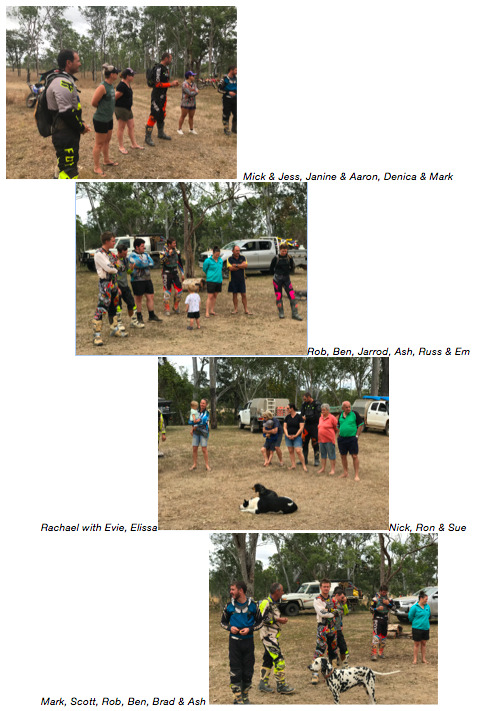
(Apologies for any names of adults, kids and dogs I missed.)

Emily, Scott, Rachael and Evie: Final briefing, thank you and farewell

Nanny and Poppy with Evie - fantastic job everyone!

Parting remarks from Mum to Mark and Emily as they line up for the final ride home

The riders setting out from camp on their last ride
The ride home was uneventful bar for one flat tyre. We all pretty much retraced our steps .....
Ben Moore’s video of the trip is here - great music! Thanks Ben.
https://www.facebook.com/ben.moore.750331/videos/3536559936366549

Three brothers: (L-R) Michael, Mark and Bradley Bowden
Michael, Your life was a blessing,
Your memory a treasure,
You are loved beyond words,
And missed beyond measure.
In loving memory of Micky - forever in our hearts
1 note
·
View note
Text
I am a Covid Refugee! (Part 2)
7th September to 22nd September 2020
Did I mention the puppies? We have four miniature dachshund puppies 🐶 here - they were four weeks old when I arrived, and now, at eight weeks, they are heading off to their new homes.

Penny with her five week old puppies
It was so funny last Friday (11/9/20), Rachael was doing the mail run and the Vet appointment to get the puppies microchipped was at 12 noon in Ravenshoe. So Rachael asked me to bring the puppies in, along with Penny, their mum, and she would meet me at the vets. Well, I was running late of course (it was a usual work day for me) and you would have laughed watching me stuff these roly poly puppies into the little carry cage. By the time I got to the fourth one there was no room and they were squirming around - I pushed the last one in and hoped for the best!! They survived! Penny was happy to sit on my lap for the drive in to town. So now they are micro chipped and vaccinated and ready for their new families!

Picture of cuteness!
They are keeping one, one goes to the family that provided the service, and two are being sold.
My daughter Rachael and her husband Scott have a Droughtmaster stud and Scott is really into his breeding. Lots of cow business goes on here on a daily basis - some of their bulls are here where he can keep a close eye on them, some are agisted next door, and they have two paddocks where they agist at Evelyn Central, a twenty minute drive away, as well they manage some cattle that are not theirs. It is a full life - hard working stewards of the land.
Wednesday nights I have been staying in town with my friend Jenny. She made up a session room in her home for me to do my craniosacral work while I am here, and also drummed up lots of clients. Too easy! So we chill out together Wednesday nights, then I have my dowsing Zoom call from 6 to 8am Thursday, after which we walk up town to have a coffee. I love it. The rest of the day is spent seeing clients. Sometimes, if it is a long day, I will stay Thursday night as well, and head home early Friday morning to continue my “work from home” job. Everyone who has received a session from me has come back for more! They all love me and want me to stay. 😍
Preparing for the Big Party
15.09.20:
The family have started to arrive - Brad & Ash and little Evie arrived yesterday and Mark & Denica (the newly weds) arrived a few hours ago. My son Aaron and his family arrive early Saturday, as will everyone else. We are expecting at least 25 will be staying on the property - most will have their own camping set-up in preparation for the Michael Bowden Memorial ride. We are expecting 36 for the ride with maybe 15 of them will be bike riders - the rest are support crew!
Saturday 19th September we are hosting a big party cum BBQ to celebrate Denica’s 30th birthday (in lieu of a wedding celebration which Covid has once again forbidden) and the Memorial Ride will be from the following Thursday 24th through to Monday the 28th of September. It is for these two events that I am a Covid Refugee!
Here is a few photos from the night before the party - we had to check the lights and sample the fire pit of course!

Brothers, Mark and Brad, around the fire 🔥

Party lights are up - thanks Mark!

Mark and Denica decided to make dinner on Friday night - Mark’s famous curried sausages - yum!
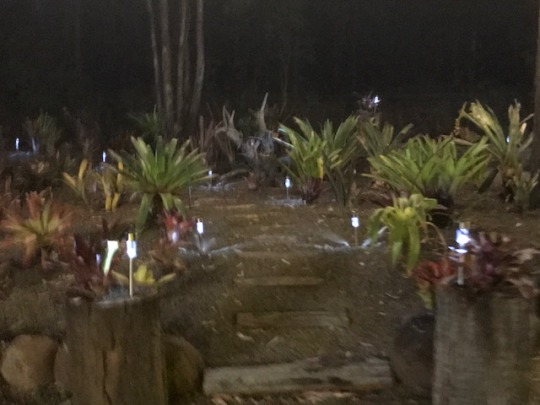
The little kids enjoyed walking this pathway! The solar lights create a pretty star pattern.

The hostess is enjoying having all her chickies home!
19th September - party day!
The grey skies dissipated after a week of drizzly weather. Emily and Rob, and Aaron & Janine and family left Weipa early afternoon and drove through the night arriving in Ravenshoe in the early hours of the morning. (It is a 12 hour drive from Weipa in the far north to Ravenshoe - approximately 850 km). Em and Rob were on the fold out bed in the living room. Brad & Ash and Evie were in one of the bedrooms, me in another, and Mark and Denica were in the caravan. Aaron had three bikes strapped on top of his camper so alternate sleeping arrangements had been made for them for that first night. I had one sleepy Eli crawl into bed with Nanny Naj (the highlight of my stay!!!). Beau elected to sleep with Auntie Rachael and Uncle Scott, but after 10 minutes he announced he wanted to sleep with mum and dad! They were in Brad and Ash’s camper but Brad had forgotten to set the bed up for them! Whoops! Sorry guys. The cool night air was a shock for the Weipa-ites!
In the morning Scott put on his chef’s hat and cooked up a hearty breakfast for the fifteen of us. All the work that we had been doing for the previous six weeks had been in preparation for this moment! It was a gloriously crazy time.
The Charters Towers crew arrived, and friends of Mark and Denica from Cairns, Denica’s mum and dad, Scott’s family, and more and more and more . . .
Tents were erected, swags set up here and there, and the day just flowed. The kids had a ball - obviously feeding the animals was a highlight. I will let the pictures tell the story.

Aaron with the kiddies off to see the bulls!

Scott with Evie off to see the bulls!

Poppy Pete discussing the finer details of horses with Cody

Cody and Beau helping Rachael feed the horses

Aaron, Rachael & Beau - all the kids got to ride Sunny

Eli is a fast runner!

Beau
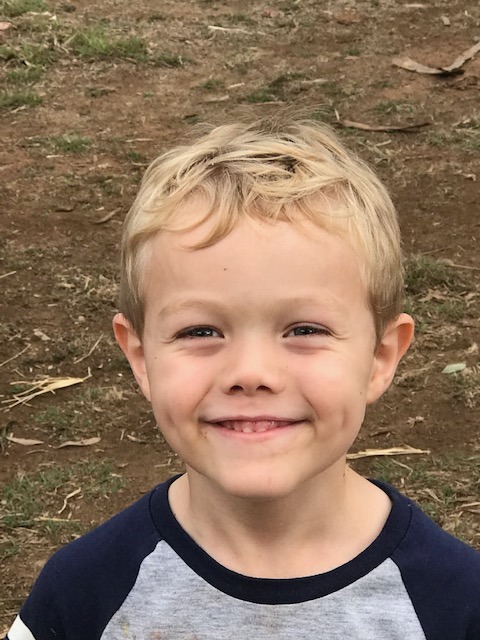
That grin!
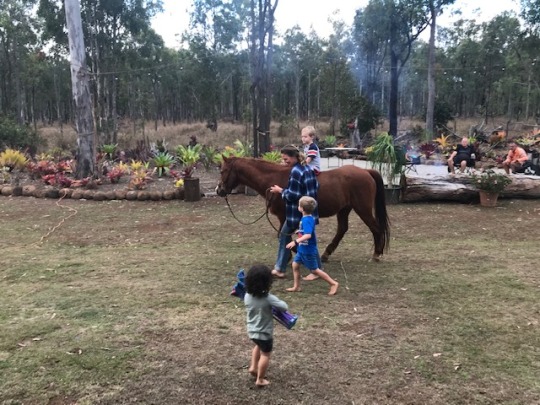
Eli on Sunny
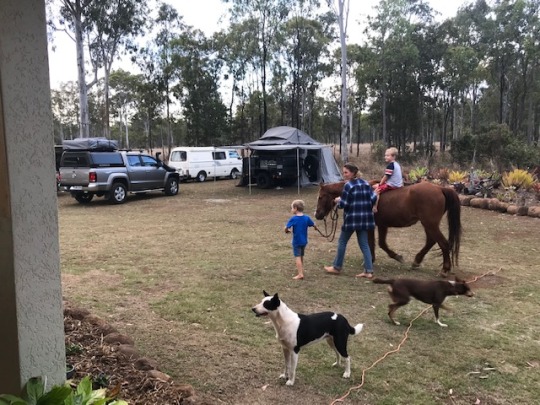
Horse rides, dogs, camps ....

Big kids playing card drinking games!

The party table ....
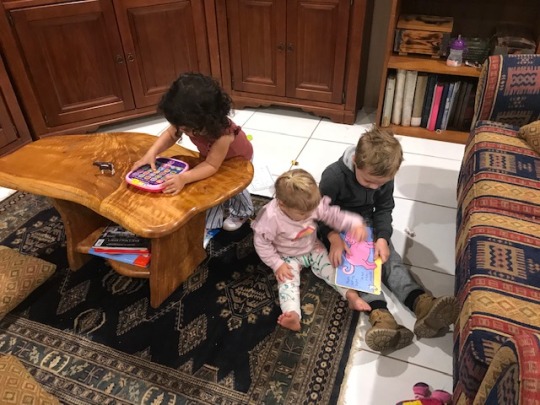
Little kids having fun
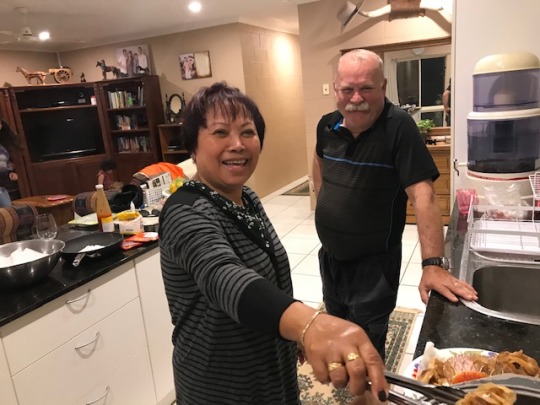
Denica’s mum & dad - Emma and Ian. Emma deep fried heaps of spring rolls and chicken wings 🍗 that she had prepared by hand.
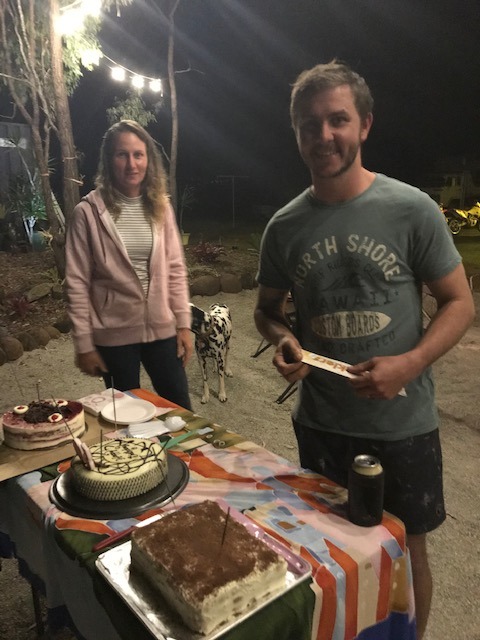
Rachael and Mark getting ready to light the birthday sparklers

Rob & Emily - it’s a blurry shot but it captures the moment!

Happy 30th Birthday Denica!

Aaron & Janine & the boys. Check out Cody blowing out the “candles”!!!

Beau showing me his new bike
It was a fabulous night with everyone enjoying themselves. At the time it was thought we may have made too much food, but by the time everyone had departed at the end of the weekend there was nothing left - and no-one left hungry!
The next day Mark and Denica had a date with a wedding photographer, so they set off to repeat their wedding vows in front of their nearest and dearest. (Because of the Covid pandemic, all their wedding plans had been scrapped, even the latest one to hold the reception at the venue they had booked. However, as they had already paid the photographer, they decided to take advantage of this time to create a keepsake of this important occasion.)
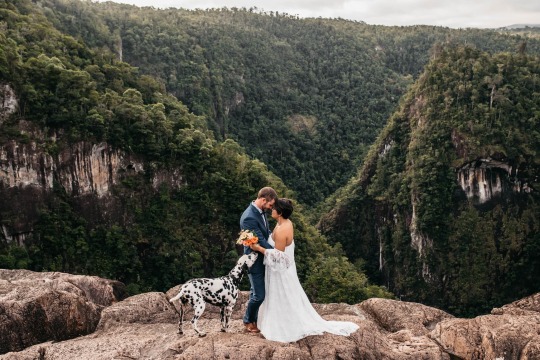
At Tully Falls lookout - with faithful Leonard

At Hardy’s Farm in Evelyn Central (refer to my previous blog about this stunning property)
And while on the topic of creating keepsakes, the next day we did a Bowden photoshoot to capture five generations all together!

L-R: Rob, Emily, Scott, Jarrod, Ron, Denica, Nana McVicker, Evie, Mark, Sue, Rachael, me, Ashleigh, Brad, dogs Leonard, Frankie and Giz, and Jarrod is holding an unnamed puppy.
Five generations in one photograph - how special! Nana McVicker is Scott’s grandmother, and now he is grandfather to baby Evie! Thank you Nana for making this day so special for all the family.
This tale will be continued in Part 3 of I am a Covid Refugee.
0 notes
Text
I am a Covid Refugee! (Part 1)
7th August 2020 to 6th September 2020
Well, 2020 has been a difficult year for everyone, the catch cry being: “We are all in this together.” March, April, May . . . surely it would not go on for much longer. I became used to working from home. I certainly did not miss the hour commute every day, and relished staying in my PJs sometimes all day!!! (Sshhhh don’t tell anyone!). Some things were strange though, like queueing on the footpath for a cup of coffee or a loaf of bread, phone consultations with the doctor (luckily I only needed a Doctor’s Certificate for work - what if I was really sick - would a phone consultation work then?), hiding away if you even had a hint of a cold, wearing a mask. So we endured another two months - the winter of discontent I called it - 5G, forced vaccinations, restricted freedoms, censorship - the Far Right were having a field day. Then suddenly, in early August, with less than 36 hours notice, I found myself on the road once again, escaping into Queensland before the Sunshine State went into lockdown!
Really??? Lockdown??? WTF?????
How do you pack up a life at a moment’s notice? Fortunately my boss was agreeable with my working from home - I mean I had been doing that for five months already. How different would it be if I am 2,000km away to being 30km away? My craniosacral clients were not so happy though, but what to do? I am booked out three weeks in advance so I had to contact so many people to cancel their appointments. That was hard as a lot of them are suffering and needing the support of craniosacral therapy. My Queensland friends and clients were delighted though. So, why the rush to escape into Queensland?

September our family were planning to celebrate the wedding of my Number One grandson to the love of his life, and soon after we were holding the second Michael Bowden Memorial Bike Ride (https://bebalanced222.tumblr.com/post/187093069102/the-michael-bowden-memorial-bike-ride-to-the-tip) - except this year it would be held around Michael’s home town of Ravenshoe, situated on the western edge of the Atherton Tablelands in the tropical Far North. I could not afford the mandatory two weeks quarantine in a hotel at my own expense. So, it was a forced (but not unwelcome) escape. Officially I am relocating to Queensland.
Warning: Political comment: How stupid! How dare they? What about people seeking urgent medical services across the border? What about families living on both sides of the border? What about farmers? What about ...... I do hope that after all this is over that the people making these decisions, that are curtailing the freedoms of so many people, splitting up families, denying people basic human rights, that they are held to account. I believe it is irrational stupidity on the grandest scale. But don’t get me started . . .
Ravenshoe is Queensland highest town, being close to 1,000 metres above sea level. Stunning country, crystal clear fresh water streams, wet tropic rainforest and dry sclerophyll forest as you travel west. (Go to the Archive to check out previous blog posts for more stories about this fascinating part of the world.) The family are gathering - from Weipa in the far far north - about as far north as you can go in this country - also from Cairns, Townsville, Charters Towers, and ME from Mullumbimby, in NSW.
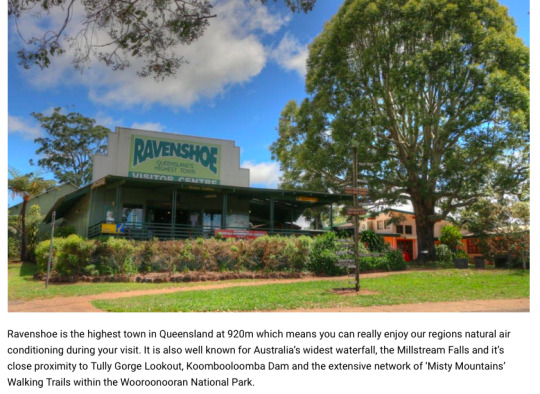
Ravenshoe is also the home of my best friend, Jenny. It is the town where my kids went to school. It is a place of many special memories for me - friendships forged, challenges met, pony club volunteering, endurance rides, solo parenting .... all so long ago now! I left, my daughter stayed. Her kids grew up here so I had the joy of returning to this special place many times during the intervening years. But I digress - this story is about my journey as a Covid refugee ..... so here we go .....
The borders closed at 1am on Saturday the 8th of August. After a one hour snail pace crawl the last two kilometres to the border, I finally crossed into Queensland around 5pm on Friday August the 7th, having left work early to make the journey north. The day before I had seen six craniosacral clients in a 9hr period, as well I participated in a two hour Zoom call at 6am with my international dowsing group. I was unable to start packing until I had finished the craniosacral treatments (my massage table had to go in first), so the rest of the night before leaving was packing for an unknown amount of time, for cold and hot weather. It was 1am before I climbed into bed, and I had a 9am meeting in Bangalow, a half an hour drive to the south. It was a herculean task just to get across the border, joining thousands of others doing the same thing.
You know we southerners have a running joke about Queenslanders, which stemmed from the fact that Queensland does not observe daylight saving (sometimes called summer time) when the clocks are turned back one hour in the summer months. We say that going to Queensland you have to tun your clocks back one hour and ten years! But in this case it was a huge relief to finally cross the border, where travel was unrestricted, so long as I did not leave the state. I was leaving a Covid free area. There had been no cases for months, yet we were being treated as if we were highly infectious.
I arrived at my girlfriend’s place on the Gold Coast just in time for Friday night sundowners, a yummy home cooked meal and a warm bed. Bliss. Saturday I drove northwards to stay with friends on the Sunshine Coast, in their stunning rural retreat in Montville. 9am Monday I had my car booked in for a service with the Purgeot dealer in nearby Nambour. I still had to work (”working from home” for my employer) and Monday is pay day, so I completed the payroll and other essential tasks while the mechanics worked their magic on my sixteen year old Purgeot wagon. Best car ever!
With confidence I was now able to begin the real journey, 1,750 kms, to my destination here in Ravenshoe. Having to put in work hours for my employer and drive 6+ hours each day was challenging. I stayed the first night in Rockhampton, the second night in Bowen, the third night in Cairns.

Beachside Holiday Units, Bowen - old but clean, with the best view in town!

View from the apartment
While in Cairns I stayed with my friend and colleague, Satyesh, and the following day I received a restorative, healing, craniosacral session at the Cairns Cranio Clinic in Freshwater, which really helped me - no more clicky jaw, and no more headaches. Thank you Satyesh for your presence and skill.

I had the dream drive up the tortuous Gillies Range (known for its 263 corners, and 800 metre elevation change in only 19 km of road) arriving in Ravenshoe in time for a whirlwind visit by my grandson and his little family - yes, I am a GG!

Four generations in one photo!

Little Evie with Nanny - she just loved the four week old puppies!
I quickly settled into a routine here, although my days are not much different to my time at home in Mullumbimby. My bookkeeping work and Cranio clients take up most of my time. And when not doing that I don my gardening clothes and am in the garden, or cooking - the freezer is loaded up with soups, garlic bread, avo dip, banana cakes, spinach pies - 3 litres of lime cordial are in the fridge ...... the grandkids all want me visit and do the same for them!!!! Ha ha. 😎
We have been doing massive gardening and landscaping work preparing for the big family gathering here on the 19th of September. My daughter and son-in-law only moved into their new home three months ago. What they have done in that time is incredible, turning their barren, unloved plot into a garden of eden.
We have planted out a huge Bromelaid garden, filled with Quincan gravel, a cactus garden, landscaped the front entry with logs and plants to disguise the Biocycle unit situated right at the front entrance! 🤨🧐🤪 I have potted up at least 100 plants - mostly left over bromeliads and various cuttings, and created a “nursery” to care for them & keep them out of the wind. Copious smaller rocks have been used for garden edging. ...... it’s looking great.
These are the “before: photos:

Close to 100 pot bound bromelaids had to be cleaned up, planted or repotted!

Quincan gravel has been laid down for the bromeliad garden. (Quincan is a highly vesicular volcanic rock from the fiery centre of the earth and is quarried at Mount Quincan in Far North Queensland.) The broms are still in pots temporarily placed as we work out the planting plan.

View from the patio looking north - dappled shade provided by a Blue Gum, dry sclerophyll forest beyond.
These are the “after”photos:

We made a walkway through the garden, and placed the broms according to colour and size to try and achieve maximum impact.

Instant cactus garden located in the north west corner - young Droughtmaster bulls can be seen lounging in the distance.
Scott exchanged bobcat work for a work mate for these magnificent cacti which were not welcome in his newly purchased property. Scott knew exactly where they would go! A couple of ute loads later and - hey presto!

Naturally occurring basalt boulders have been used as garden edging, while upturned hollow logs are transformed into planters for the entryway.
The area west of Ravenshoe is part of the longest basalt flow in the world (Ref: Volcanic Activity in Northern and Central Queensland - “The Undara lava flow is the longest recorded lava flow in Australia and one of the longest on the planet, similar in length to the Pampas Onduladas flor in Argentina.”) Boulders of all sizes are common, so finding a creative use for this abundant resource is great.
One weekend late August we were invited for afternoon tea with John and Narelle Hardy at their beautiful home and garden at Evelyn Central, where Scott has been agisting cattle for a number of years. Scott has been looking after John’s yards and paddocks and also his cattle, and a wonderful friendship has deepened over the years. John says nobody but Scott has ever left his place in better shape than when they arrived.
After regaling us with stories of survival during cyclone Yasi in 2011 (the biggest storm in Queensland’s history), Narelle gave us a tour of their garden as the sun was dipping towards the horizon. Some of the plants growing here are mind blowing. The farm was completely bare when the Hardy’s arrived some decades ago. It is hard to imagine that when you see their gardens now. It had been a hot work day when we arrived, but by the time we were leaving the sharp chill had settled - such is the weather on Australia’s highest Tableland. We were definitely under dressed for the fall in temperature!

Chalice Cup Vine
“Solandra maxima is a flowering plant in the Solanaceae family. It is also known as cup of gold vine, golden chalice vine, or Hawaiian lily, is a vigorous vine which is endemic to Mexico and Central America. It has very large yellow flowers and glossy leaves.” (https://en.wikipedia.org/wiki/Solandra_maxima)

This is the vine in situ

Rachael admiring a young Swamp Cypress, Taxodium distichum.

Delicate foliage of Swamp Cypress - a deciduous conifer with soft, fine-textured, needle-like bright green foliage changing to a rusty orange in late autumn then brown before falling.

Giant leaves of the New Guinea Fig (ficus)
“Ficus dammaropsis, kapiak (Tok Pisin), highland breadfruit, or dinner plate fig, is a tropical fig tree with huge pleated leaves 60 cm across. It is native to the highlands and highlands fringe of New Guinea. It generally grows at altitudes of between 850 and 2,750 metres. Its fruit is edible but rarely eaten except as an emergency food.”

New Guinea Fig - the tree in perspective

Doryanthes palmeri - the Giant Spear Lily - amazing - it is as tall as the house!!!
“Endemic to eastern Australia. It grows in a rosette and the leaves can reach the length of about 3 m. The flowers arise in springtime on a stalk which may reach 5 m in height. A succulent herb, its leaves are hairless and grow in the shape of a sword. The giant spear lily is listed as Vulnerable under the New South Wales Threatened Species Act (1995).”

Wisteria bower looking out to seating area under the Jacaranda Tree

Wisteria flower

Water feature
We arrived with our arms full of garden produce and bromeliads and left with our arms full of limes (remember that lime cordial I mentioned earlier?) and various plant cuttings. How wonderful! Thank you John and Narelle.
Mining in history
On Sunday the 7th Sept, Father’s Day, we were joined by Scott’s parents for a day trip exploring the old mining towns west & north west of here. We turned off the bitumen at Mt Garnet and followed Nymbool Road to Lappa Junction, Almaden, Petford, Emuford (nothing left of the township except a sign!), Montalbion, picturesque Irvinebank, Herberton then home. The history held in these hills is fascinating.

Mt Garnet streetscape
Mount Garnet is an old tin mining area, first settled at the turn of the century when copper and later tin were discovered. It is surrounded by beef cattle stations and in the 1930s about 14 tobacco farms. Today small crop farms are still found on the Herbert River flats, producing corn, sorghum and maize. Various mining operations, including lime production and zinc, are currently functioning just outside Mount Garnet.

Tabo (short for Tableland Tin) Dam just outside Mt Garnet
After 1904 the miners turned their attention to the excavation of tin. Today Mount Garnet has a reputation as a good starting place for gold prospectors and gem collectors.

Street signage in the middle of the bush! They are all dirt roads.
Following the discovery of high grade copper oxide and silver, Mt Garnet became the second largest inland town after Charter’s Towers, employing 1,800 men in 1901, at which time a provisional school was opened catering for the children of the families of the workers at Mount Garnet Freehold Copper and Silver Mining Company. At first the smelted copper was shipped out by camel to Lappa, but by 1902 a branch line connecting the town to the Mareeba Chillagoe line had been built and the copper was being railed out to Lappa Junction and then to the coast. Mount Garnet Freehold Copper and Silver Mining Company closed in 1906. However tin was discovered in 1901 and soon the mining of the rich veins of tin revived the town until 1986 when the price of tin dropped, forcing many families to move away.

Hand hewn rock cuttings made in the early 1900′s for a rail connection between Lappa and Mt Garnet.

My view from the back seat - it was a narrow windy road, and a few times we had to back up to allow for another vehicle to pass from the other direction.
We followed the disused rail corridor from Mt Garnet to Lappa Junction, travelling through elevated, rocky country where we found bridge foundations made from Chillagoe limestone. Amazing to think that these railway cuttings were hewn by hand.

Rachael examining the limestone bridge foundations still in excellent condition more than 100 years after construction. All the stones were shaped to fit - it would have taken years to put a railway through from Lappa to Mt Garnet.
When the mineral fields around Chillagoe were starting to develop, there was no railway or other infrastructure. Water at Lappa was an important resource for the camel trains and the other animal transport teams used to transport goods and supplies to the mining camps and settlements in the region.
Lappa Junction station came into being in 1900, when the first section of the Mareeba to Chillagoe railway was completed. Although developed primarily for mining, on the inaugural journey, even the mining warden recognized the line's tourism potential. The junction is where the line used to split to Chillagoe in one direction, and Mount Garnet in the other. The Lappa line was the main rail line to bring the coal back to Mt Garnet to power the lead, copper and zinc mines there. Today, the line to both places is no longer operational.
What we did find there, unexpectedly, was The Espanol Hotel. Built in 1901 by a Spaniard called Mr Barbera, it has served travellers and locals for 114 years.

You can just make out the name etched into this sign on Yappa’s Espanol Hotel
The hotel license was surrendered in December 1966. The old kitchen remains behind the hotel. The Espanol Hotel today is a BYO pub and museum, continuing its century-old tradition of bush hospitality in the stark beauty of Australia's outback. It is owned and operated by Yappa from Lappa.
Here's an article from ABC Far North about Yappa: http://www.abc.net.au/local/stories/2010/05/04/2890047.htm

This is what greeted train travellers to Yappa Junction!!! Today, a traveller is cooking his bacon and eggs on an old disused mining trolley!
Made from round bush timber and galvanised iron, the Lappa bush pub remains as the only example of a once common mining town building. You are welcome to bring your own drinks and consume them in the historic bar.

The historic bar - only one stool I am afraid. Rickerty floorboards and natural air-conditioning ;-) means watch your step!
Today, the Savannahlander departs Cairns once a week, stopping at Lappa Junction, and the trails from Irvinebank to Lappa, and Lappa to Mt Garnet are popular mountain biking trails.

Lappa Railway cottage
Just up the road is Almaden, population of 71 people in 2016 census.
This place is like something out of a Western. There is literally nothing else here other than a pub, a house and railway station. It comes to life when the Savannahlander stops by twice a week.

Almaden Railway Station
We picnicked at the Railway Station and wandered over to the Railway Hotel for a very welcome cold beer.

The Railway Hotel, Almaden

What else to do when in Almaden?
By 1910, the Cairns to Chillagoe line was connected to the Etheridge gold fields so the private rail link from Forsayth-Almaden became an important rail junction. Such a treasure trove of riches were uncovered in this mineral-rich land during those times. Gold at Etheridge and Hodgkinson, copper at Mt Garnet and Mt Molloy, tin at Irvinebank and Stannary Hills, tin and silver at Emuford, silver and wolfram at Petford and coal at Mt Mulligan fuelling the Chillagoe smelter.
We had originally decided to travel as far as Chillagoe (incredible limestone caves in that area, also marble said to be even better than the Italian marble used by Michelangelo), but we had no maps with us. We were just following our noses (so to speak). However, while in Lappa, we found this useful map on the wall.

Mt Garnet, our starting place, is right down there in the bottom right corner, behind the white sign ....
Clearly Chillagoe was too far for our day trip - it will have to be for another time. Instead we turned eastwards, and at Petford we turned right (southwards), taking the road less travelled (literally), passing the ghost town of Emuford and exploring what is left of Montalbion (and it’s sad sad cemetery) till finally arriving at pretty little Irvinebank, an historic town which has largely been untouched.
Emuford
Emuford was a small mining town, now abandoned, on Emu Creek, in the headwaters of the Mitchell River. The area is rich in minerals, producing tin, copper, silver, bismuth and wolfram. It was first prospected in 1882 by James Venture Mulligan who discovered tin, sparking a small alluvial diggings.
Lode mining followed but the ore had to be carted some distance to be treated. A crushing battery was built in Emuford in the early 1900′s and continued until the crash of the world tin price on 24 October 1985. The last crushing at Emuford, 20 tonnes of ore, was put through for local miner McEwen before the mill stopped for good on 7 January 1986.

There is no sign of any habitation any more. Nature has reclaimed its own!

Emu Creek
The story goes: “When legendary explorer and prospector James Venture Mulligan was exploring along a creek with a party of hungry prospectors, he stumbled upon an emu’s nest with four eggs in it. After devouring the eggs they named the watercourse Emu Creek. Later, when the road westward pushed beyond Herberton, it crossed Emu Creek at a rocky ford. A small community which was to become the centre of a large tin mining district developed around the crossing and it became known as Emuford.”

Cobb & Co Coach - Gold shipment with Mounted Police escort
The Cobb & Co coach route passed along the eastern side of Emu Creek connecting Emuford to the outside world. Between 1888 and 1904 Cobb & Co coaches travelled through Emuford carrying passengers and mail between Herberton and Georgetown to the west.
On entering these small communities the driver would sound his bugle to announce his approach. This would always generate a great deal of excitement, raising expectations of news from the outside world. This was Mail Service 201, which connected to other services that ran further west to the rich goldfields of Croydon. It covered a distance of 267 kilometres and initially ran once a week, but in 1901 the service was increased to twice a week. Cobb & Co coaches would average about 100 kilometres a day over flat ground.
Montalbion
Established following the discovery of silver and lead in the 1880s, Montalbion flourished until around 1890 before completely fading away soon after the turn of the 20th century. The Montalbion Pioneer Cemetery contains only five inscriptions on four surviving headstones but there are numerous unmarked graves.

The dates read: 1886 to 1922. The sign says: Total burials: 68. 32 children under 10 years. Scott’s mum informed me that many kids died of typhoid, tetanus and malaria around the turn of the century. It is so sad the hardship these pioneer families endured.

“Requiescat in pace” is latin for Rest in Peace.

What incredible craftsmanship and detail on these graves. This little gate still worked fine even after a hundred years.

It was sobering strolling through this hallowed place, reflecting on the people that once lived here.

We stopped by this pleasant dam for tea and cake
Irvinebank
First known as Gibbs Camp, the town was founded in 1884 by John Moffat, who had purchased the mining leases from the original prospectors. He built a dam, a mill, smelters and other infrastructure that attracted settlers and miners to the area. It became a thriving town with an economy based on mining, milling and smelting.
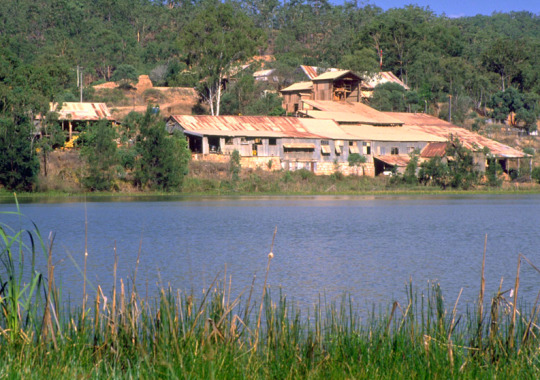
Loudon Mill built in 1884

Loudon House - the home of John Moffat, now the town's museum
We did not stop in Irvinebank as the day was getting on. We had animals to feed and chores to do. Very soon we were driving into Herberton from the west, and headed home through Evelyn Central (remember Hardy’s farm), and Ravenshoe.
Happy Fathers Day all you dads out there.
0 notes
Text
The Michael Bowden Memorial Bike Ride to The Tip of Cape York
August 2019
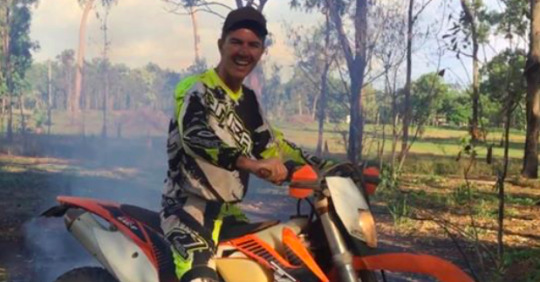
My grandson Micky
Cape York News 14 – 20 August 2019:
FRIENDS and family of Michael Bowden rode to the tip of Cape York earlier this month to pay tribute to the young man.
The 20-year-old died last year after he was struck by a vehicle on Northern Avenue on the opening night of the Weipa Fishing Classic.
With the court case against the alleged driver looming, the memorial ride provided the family and friends of Mr Bowden with an avenue to remember the joy that he brought to their lives.
“It was nice to be able to remove ourselves from the world and take the time to come together, remember the positive stuff about Mick, and turn our focus on starting to rebuild our lives,” family member Denica Russ said.
Mr Bowden and his brothers Mark and Brad loved riding motorbikes together. When the trio weren’t working as fitter and turners, they would often be on their bikes seeking out an adventure.
The Bowdens had joined the local GROWL (Geriatric Riders of Weipa Locality) club and enjoyed the camaraderie.
Riding the Old Telegraph Track to the Tip of Cape York was always a trip that Mr Bowden wanted to do. Before his sudden death, he went on what would be his last motorbike ride with GROWL up to Nolan’s Brook, seven kilometres back from the Jardine River.
Mark Coleman, the president of GROWL, was a part of the group.
“Mick loved the rides, but he particularly loved the rides that he did with his brothers,” he said.
“It wasn’t just about the riding for Mick. He always heavily involved himself with the group when they reached their destinations.
“This is the aim of our group – it is the whole deal – and Mick got that. This is what impressed me the most about Mick.”
Mr Coleman first met the Bowden brothers when working together at Rio Tinto.
“The three boys were very close, good tradesmen, and good riders,” he said.
“Mick was the last to join GROWL out of the three and he never rode outside of his capabilities.”
Mr Coleman and Mr Bowden’s brother Mark formulated the idea to do the memorial ride. When Mark Bowden contacted the rest of his family about the possibility of a memorial ride, the planning was quick and easy.
“When Mick’s family became involved it was the greatest thing ever,” Mr Coleman said.
“Mick’s parents Scotty and Rach are great people and the way they have bought their kids up is a credit to them.
“The three boys are all level-headed mature fellas for their age. They all have great work ethic, are not idiots, and everything they do is good compared to other kids that I come across.
“Mick was always smiling; a happy-go-lucky kind of bloke who loved life and his family.
“They had a unique bond.”
Mr Coleman and Mark Bowden were originally planning to ride to the east coast for the memorial ride, but chose to go to the Tip.
“Mick had been up that way not long before he passed away. The Telegraph Track is a gnarly adventure ride and is the big four- wheel drive trip on the Cape that brings adventurers up from all over the country,” Mark said.
“It was cool to bring my family up and go to the places that Mick had recently been to.
“This is an adventure that most of my family would never have imagined doing.
“It was a shame that Mick couldn’t be there with us, but nice we could do it. It was bittersweet.”
A lot of Mr Bowden’s family are from Charters Towers and Townsville. His parents Scott and Rachael live in Ravenshoe.
Together, everyone formed a convoy and road tripped to Weipa for the start of the memorial ride.
There were 44 of Mr Bowden’s family and friends on the trip.
Mark and Denica said: “Our family had a ball – my cousin Josh had hardly ridden a bike before, so this was a huge trip for him.
“Mum and dad bought the meat from the Tablelands and the GROWL club organised the rest of the food.
“I felt sad that Mark Coleman’s bike blew up before the trip and that his vehicle which transported a lot of the things we needed broke down on the way home.
“Without GROWL, this experience to help us move forward wouldn’t have been possible and we owe them so much.”
Mr Bowden’s uncle Aaron Schleich described the Cape York memorial ride as “very therapeutic”. “Since Michael’s tragic passing the family have only been able to gather for what would have been Mick’s 21st birthday, which was a big family get-together,” he said. Mr Bowden’s older sister Emily explained how she could feel her brother during the ride.
This was highlighted when Mr Bowden’s immediate family gathered to capture a photo standing at the Tip.
As everyone in the background were taking the photos, a pod of dolphins swam past.
They all agreed it was a special moment that created a memory for everyone to focus on.
However, Ms Bowden, who is already looking into the future for next year’s planned ride said: “How is Mick going to get in the next family photo when there will be no dolphins around?”
Mr Bowden’s family are looking forward to coming together each year and continue the memorial ride in different locations on the Cape in his memory.
Courtesy Melissa Diffo, Cape York News 14 – 20 August 2019
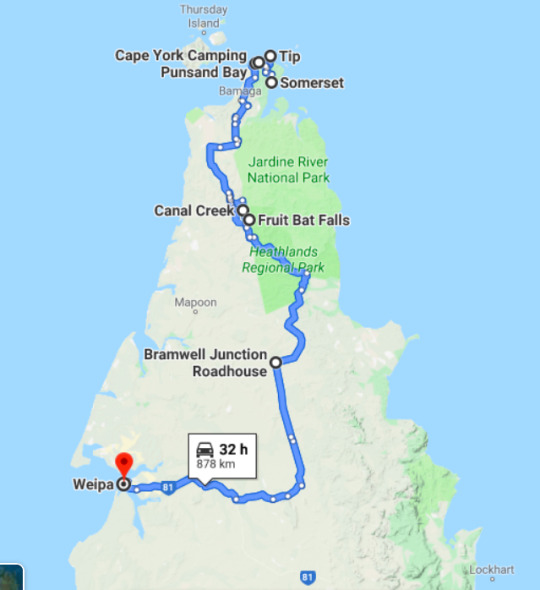
Map of the area
Travelling from Northern New South Wales, Charters Towers, Townsville and the Atherton Tablelands to join the Weipa crew, 14 riders, 18 adults, 12 children and three dogs made the epic journey (approximately 900 kilometres) across the remote, dusty, corrugated tracks of Cape York Peninsula. 4WD’s were kitted out, bikes loaded onto trailers and utes, food and eskys were already loaded up with provisions by the time I flew into Weipa late Wednesday. Many of the family had already journeyed far over dusty roads to reach Weipa.
Day 1: Thursday 1st of August
Weipa to Canal Creek
We departed Weipa early picking up a coffee-to-go at the coffee van on the way out of town and drove with all the bikes loaded east through Batavia Downs Cattle Station, past the Moreton Telegraph Station on the Wenlock River, to our meet-up point at Bramwell Junction Roadhouse.
By mid morning the bikes were unloaded and the riders kitted up for the southern section of the legendary Old Telegraph Track. Mark Coleman from the Weipa GROWL Club gave the riders a pep talk about what to watch out for and how the group would look out for each other. And off they went, bikes in one direction and we in the support vehicles continued on the Peninsula Development Road to meet up for lunch at Fruit Bat Falls situated in the Jardine River National Park.

Mark Bowden @ Bramwell, last minute preparations

Aaron Schleich set to go!

Wanna-be Cody practising for next time!
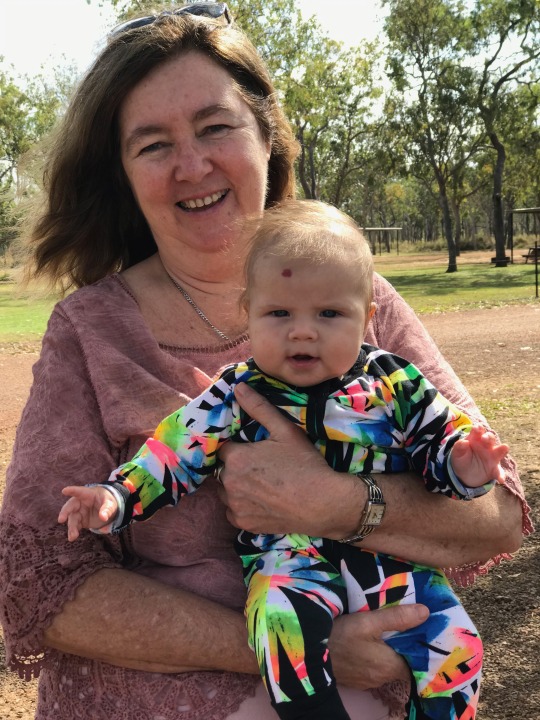
Great-Nanny Naj with baby Evie
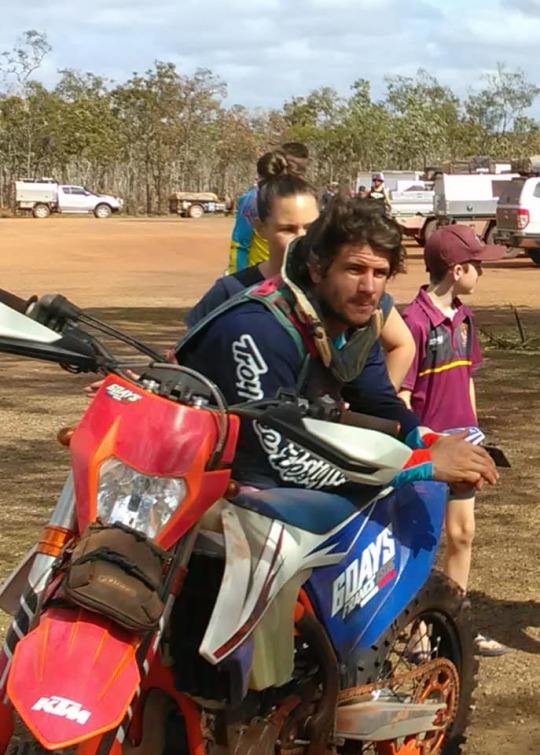
A pensive Brad Bowden
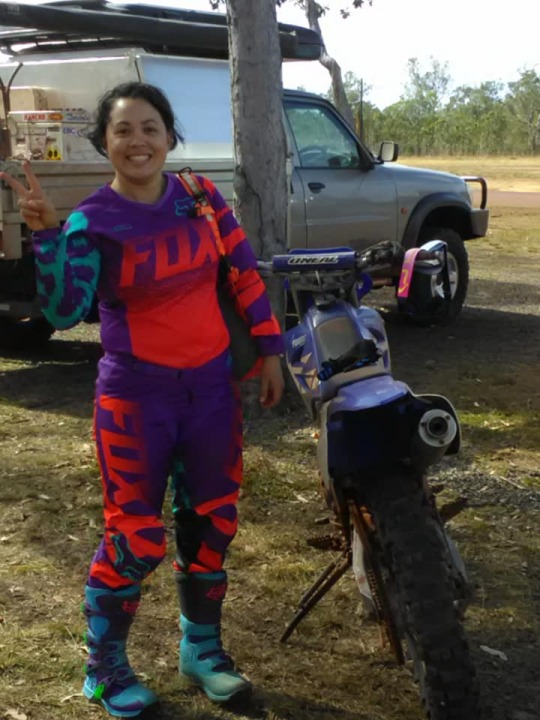
Denica Russ ready to go!
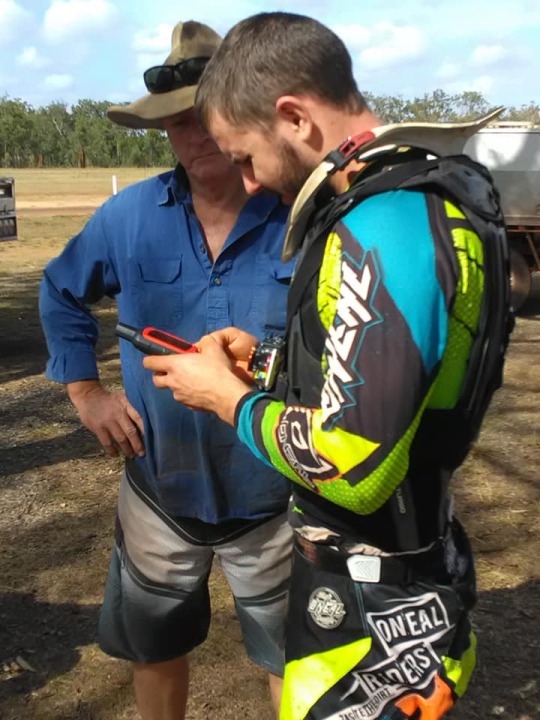
The two Marks. Mark Coleman is a veteran of these trips and his support was awesome!

Riders all kitted up for the first leg of the journey
The southern section of the Old Telegraph Track, which runs from Bramwell Junction to Bamaga Road, a distance of approximately 70Km, is an iconic drive that features eight challenging water crossings and some stunning tropical scenery as you head north towards the Tip of Australia.
Telegraph Line History
In the early 1880s the Queensland Government had JR Bradford, Inspector of Lines and Mail Route Services, survey a route along the Cape York Peninsula to Thursday Island for the construction of an electric telegraph line. Finally, after three gruelling months, the expedition reached Somerset: near the northern tip of the Cape.
Work on the Cape York Peninsula section began soon after and was completed in 1886, except for 90km between Moreton and Mein where telegrams were carried by horse and rider until the line was completed. The line consisted of galvanized cast iron ‘Oppenheimer’ poles manufactured in Germany and many are still standing today. Ceramic insulators are also sometimes found. After more than 100 years of service, the line was closed in 1987.
(Courtesy www.hemamaps.com)
The support vehicles were the first to arrive at Fruit Bat Falls picnic area and we enjoyed a picnic lunch and swimming in the crystal clear waters.


Evie greets Poppy at Fruit Bat Falls
Finally the riders arrived, and there already had been some injuries: Brad hit a small tree and went over the handlebars injuring his shoulder quite badly - no blood but internal damage - no more riding for him today, and Josh came off at one of the creek crossings injuring his foot and a finger - he kept his boot on and rode the rest of the way but he only found out a week later that both the finger and the foot were fractured.
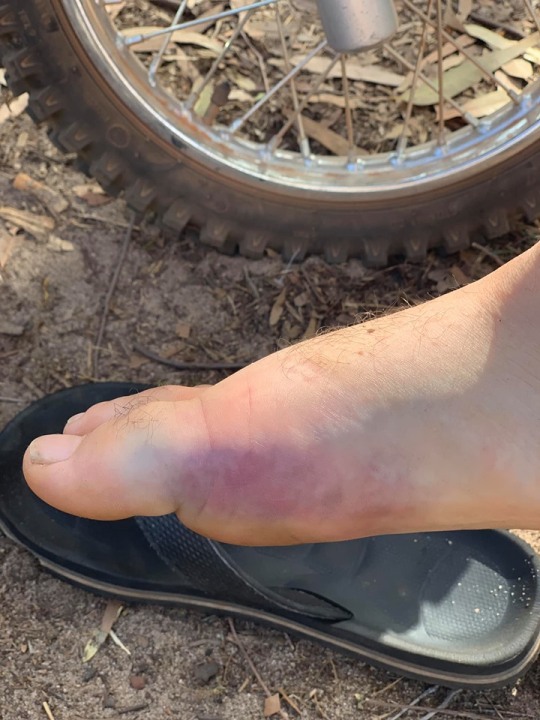
Ouch!
The injured had some hydrotherapy at Fruit Bat Falls, and with belly’s full we all then headed down the four wheel drive track to nearby Canal Creek to camp the night. It was the best spot to camp being situated just outside the national park so we were able to have an open fire and the dogs could have a bit of a run around.

Micky’s dad Scott rode Micky’s bike - he made it unscathed!

Scott with his mum Sue and “the mother-in-law��� by the edge of Canal Creek
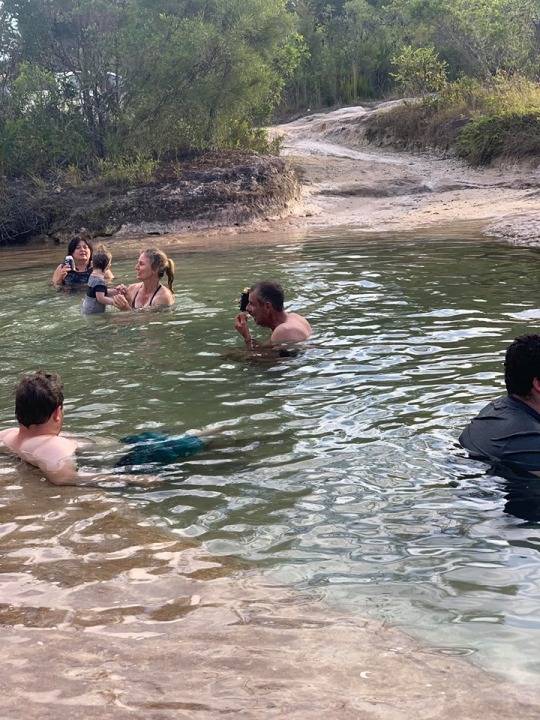
Chillin out at the end of the day!

Ron and Sue taking a dip!

Uncle Glen, Uncle Aaron, Cousin Josh & Kim enjoying the cool water
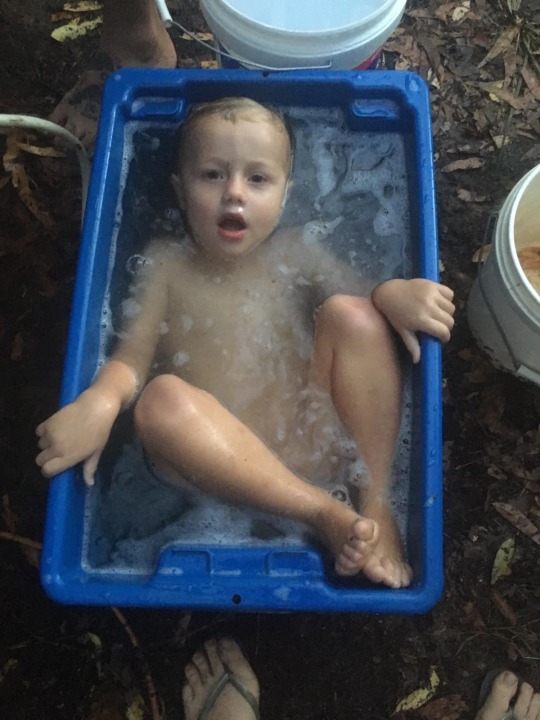
Cody enjoying his camp bath!
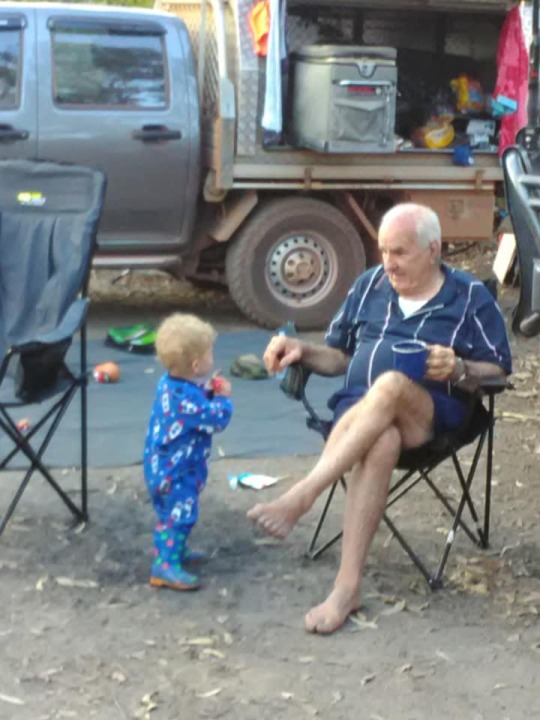
William with Great Grandad!

Canal Creek camp - Mark Coleman on the BBQ - the Growl Club provided dinner for this first night.
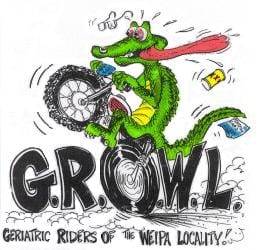
Day 2: Friday 2nd of August
Canal Creek to Punsand Bay The day started with a camp breakfast courtesy of Growl, and bikers rode more of the Telegraph Track to our next meet-up spot at the Jardine River ferry crossing, while the cars drove via the bypass road. There were a few changes - Glen took over from Scott riding Micky’s bike, and Denika handed over her riding gear to Micky’s sister Emily who regarded herself as a novice rider. However with lot’s of family looking out for her she was keen to have a go.

Aaron is keen to get going!

Beau, Eli and Cody - “Let’s go!”

Denica all prepared for the next leg of the trip to Punsand Bay
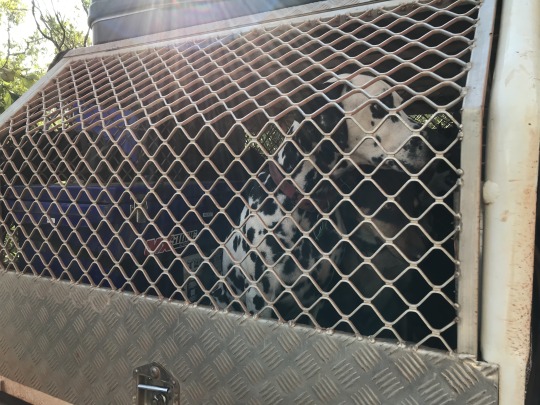
Leonard and the other dogs are ready too!

Emily ready to ride!
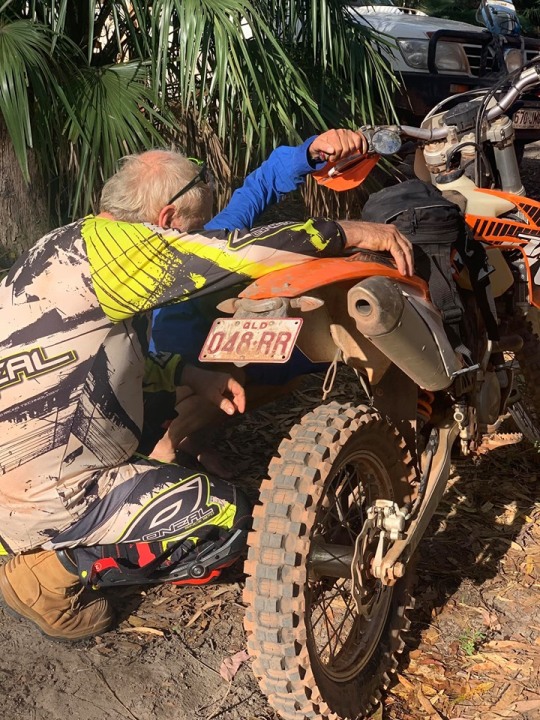
Glen and Scott - bush mechanics!
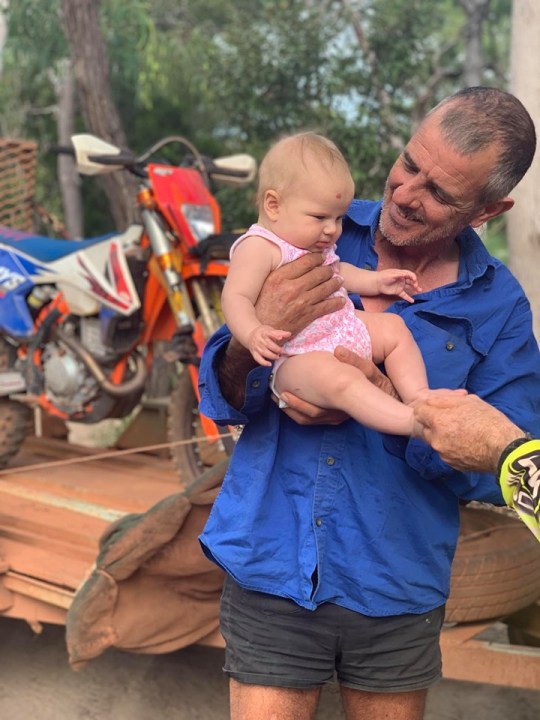
Evie got lots of cuddles while mum and dad packed up the car ....
Before leaving the Jardine River National Park, we made a short stop at Twin Falls where Micky had spent the weekend before his tragic death. Twin Falls is a series of rock pools and cascades that is linked by tracks and boardwalks to nearby Eliot Falls.

Enjoying the crystal clear waters at Twin Falls

A pensive Grandad Ron remembering Mick
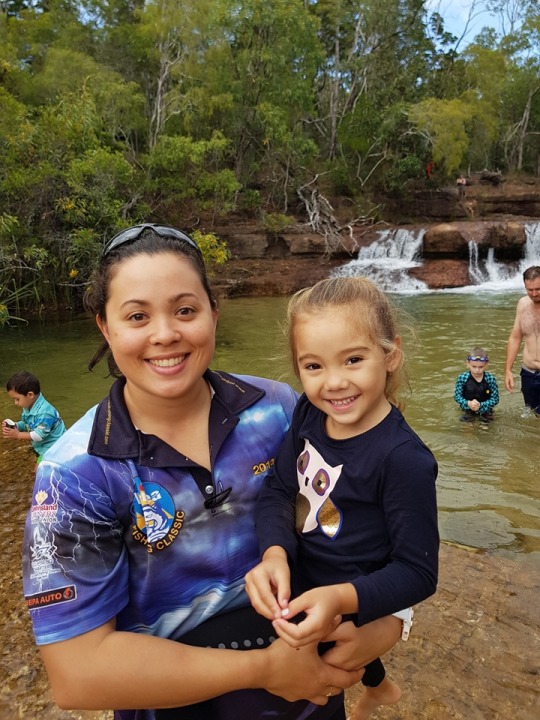
Tillie with Auntie Denica
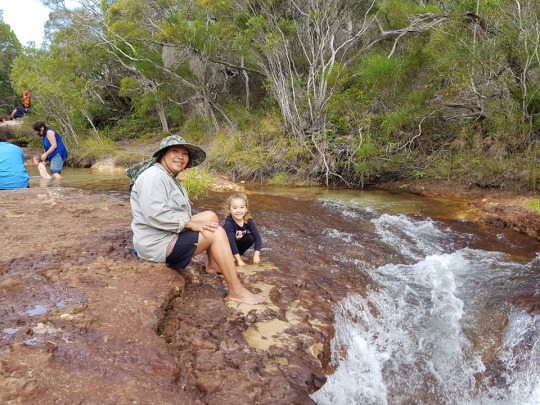
Nana Emma Russ with Tillie
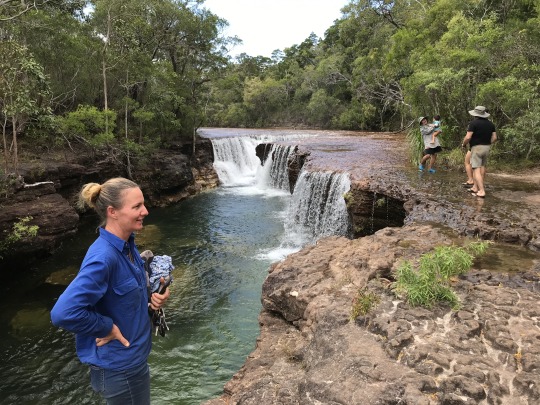
Micky’s mum Rachael enjoying a quiet moment before getting back on the road
Leaving the National Park was another matter! Lucky we spent some time at Twin Falls - the driver at the head of this line of cars had been waiting for 1.5 hours! It was reassuring to have these workmen on hand as we climbed out of this crossing!
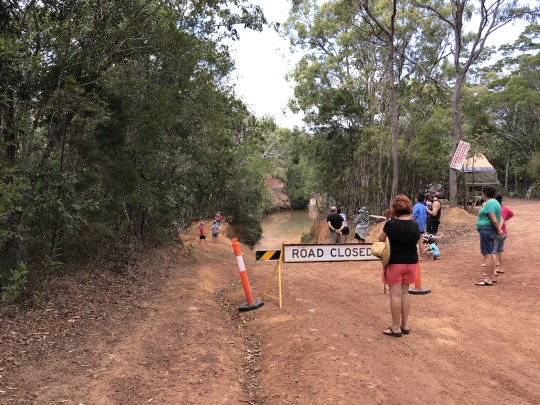
Oh no! This is our only way out!

The little boys enjoyed watching the workmen at work!
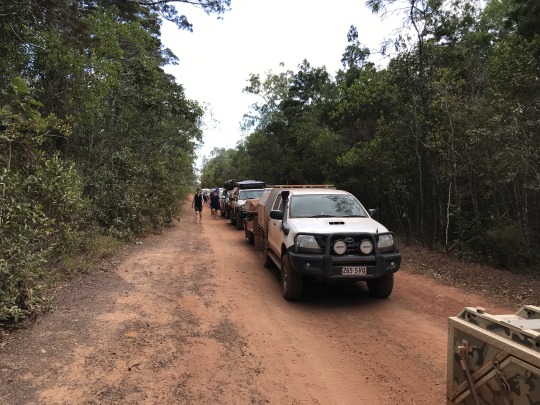
There were more than a dozen cars waiting to cross this creek - some had been waiting over an hour!
The riders on the other hand went in the other direction down the Telegraph Track to tackle even more challenging creek crossings .....
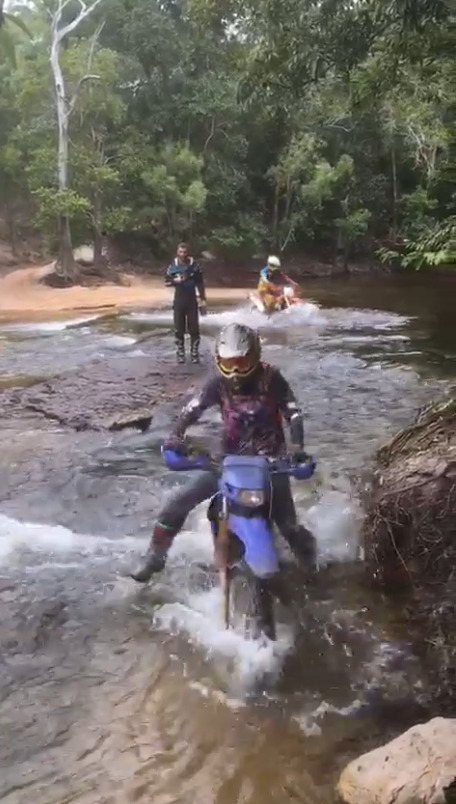
Emily doing it like a pro!

Rob Moore following up behind
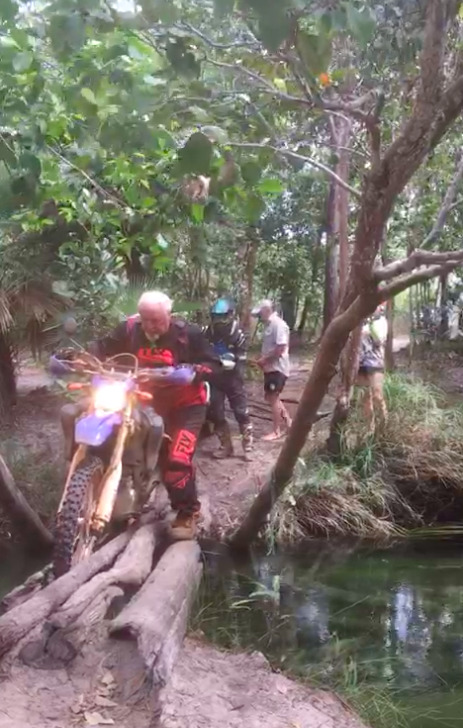
Glen walking Micky’s bike across this tricky crossing!

Crossing the Jardine
Once at the Jardine, anyone who was not registered or licensed had to load their bike up and travel in the cars to Punsand Bay camping ground. Tickets for a single vehicle return is $100, and if you are towing a caravan it is even more.
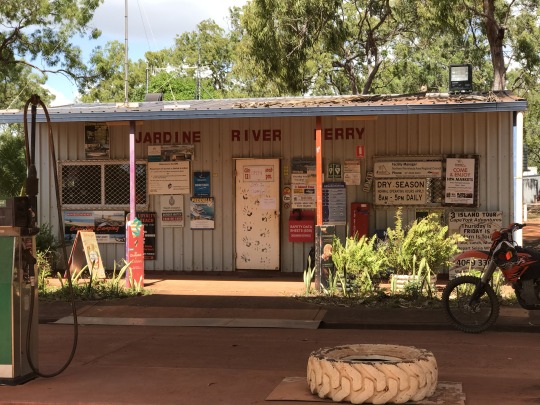
Buy your tickets here, but closed for lunch from 12 to 1.

Loaded ferry
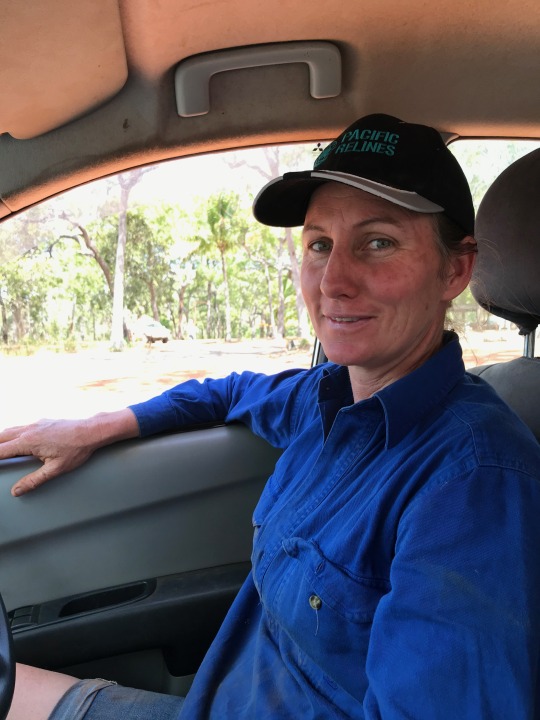
A confident Rachael towing a trailer full of dirt bikes waiting to cross
Crossing the Jardine we enter the Northern Peninsula Area. The NPA Region is made up of five indigenous communities. There are three aboriginal communities: Injinoo, Umagico and new Mapoon, and two Saibai Islander communities: Seisia and Bamaga.
Saibai Islander people were forced to relocate in pursuit of fresh water and land, and they resettled at the site of the old Red Island Wharf in Seisia. The name Seisia is made up from the first letter of each of the brothers Sagaukauz, Elu, Ibuai, Sunai, Isua and Aken, the founding brothers of the community. Seisia wharf provides the region with shipping and ferry services, as well as being a popular local fishing spot, offering beautiful sunsets and views of small islands across the water. Of course many crocodiles, sharks and stingrays inhabit these waters.
We stopped for lunch at Sesia, topped up with fuel and ice before turning north at Bamaga for the final leg to Punsand Bay.
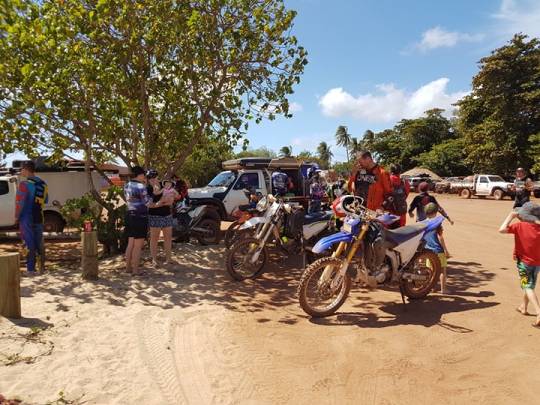
Lunch in the shade at Seisia
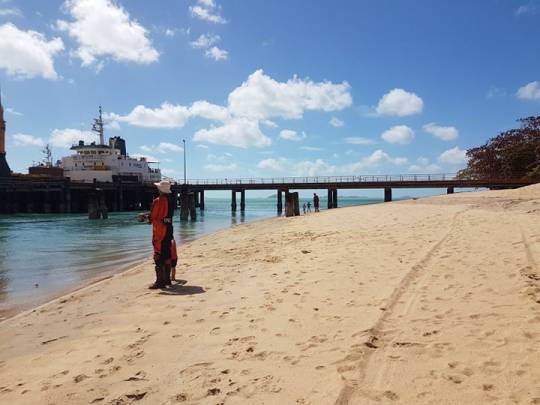
A hopeful Aaron fishing at Seisia - SeaSwift ferry tied up at the wharf

Cape York sign!

Hot showers and cold drinks! YES!!!
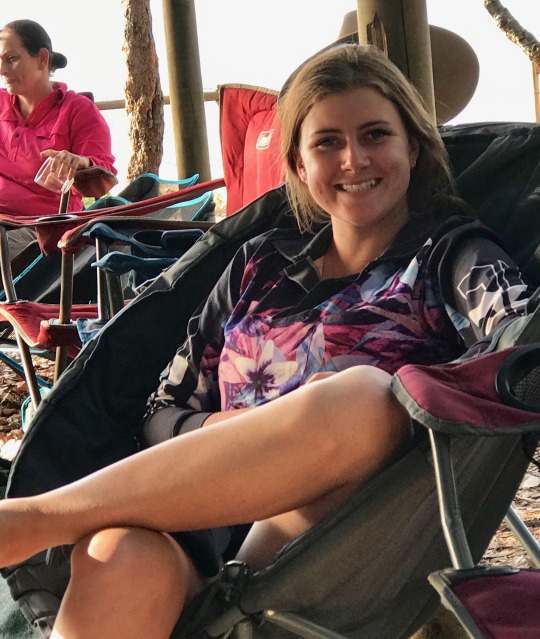
Emily relaxing after a satisfying day
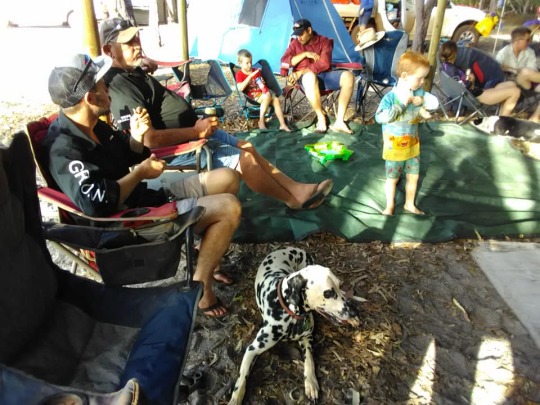
The GROWL camp at the end of Day 2. Mark cooked up a huge pot of prawns which everyone loved. Thanks Mark and Eileen!

My camp site under the trees and view to the sea - one happy camper!
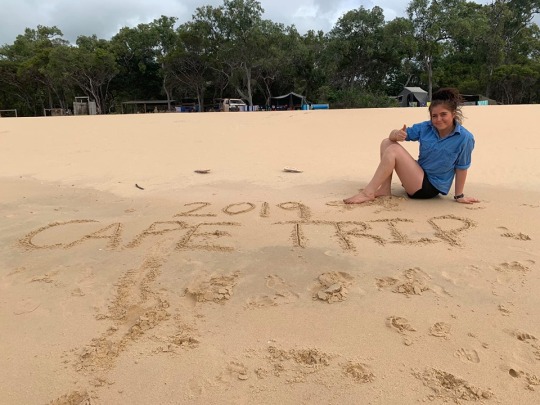
Hayley Bowden at Punsand Bay
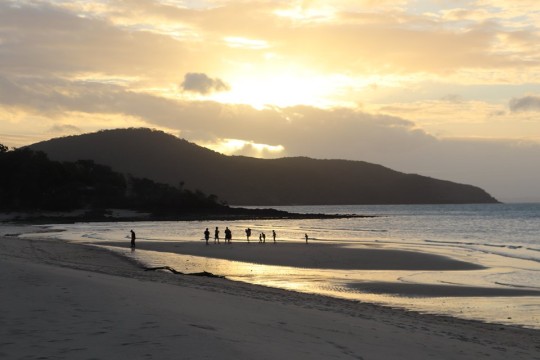
Sunset at Punsand Bay

This is the life!
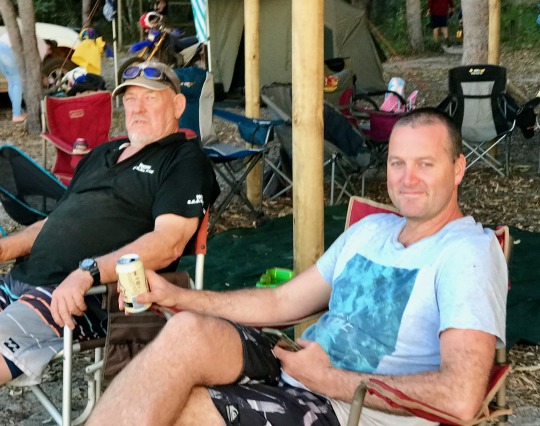
Aaron enjoying sundowners @ Punsand Bay
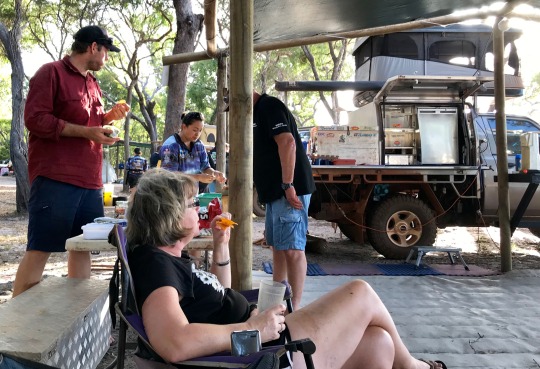
Eileen enjoying the afternoon ambiance
Day 3: Saturday 3rd of August
The Tip of Cape York, Somerset, and the 5 beach trail ride
Today is the culmination of our trip to The Tip with us all donning our Micky Memorial shirts and the boys taking Michael’s bike to the northern most point for a photo with us all.

The cairn of rocks in the middle distance is man-made by the hundreds of walkers who each add a rock to the pile as they go past.
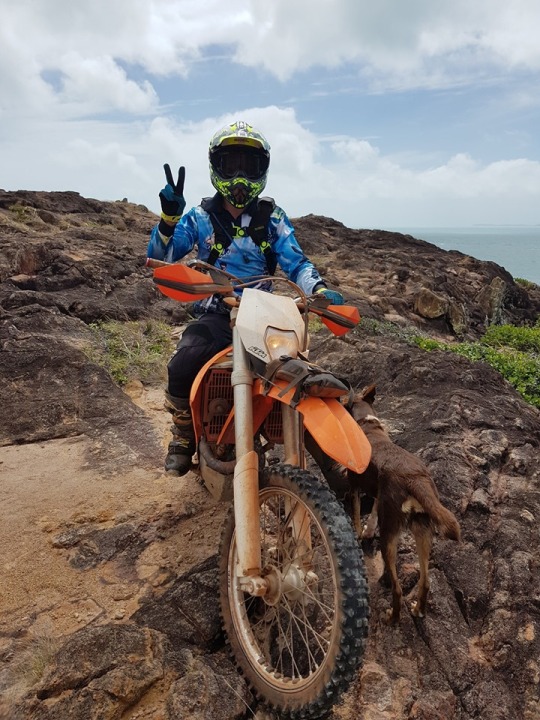
Mark Bowden riding Micky’s bike to The Tip
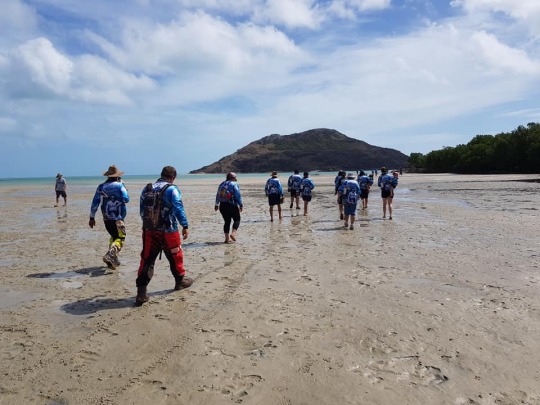
It was low tide so we were able to walk along the beach some of the way
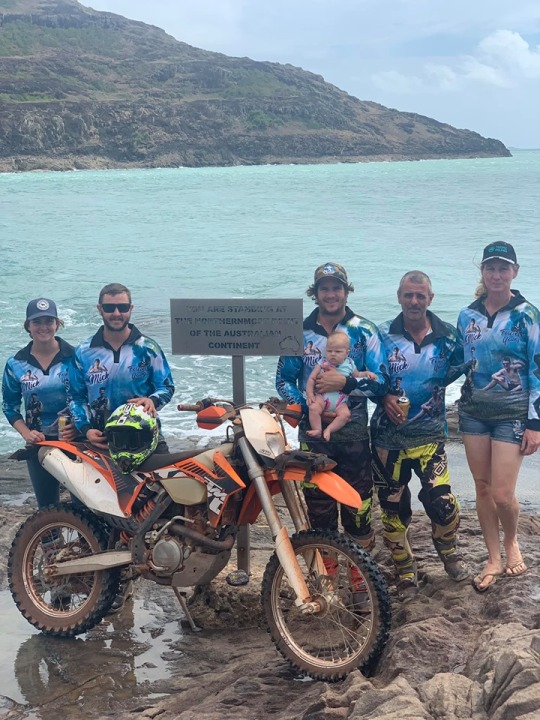
Micky’s immediate family
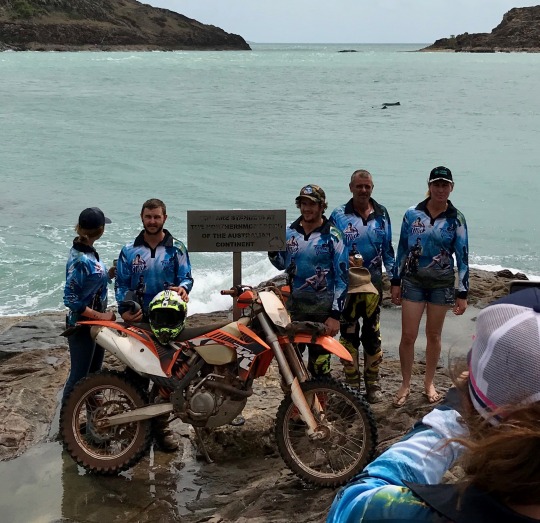
"As everyone in the background were taking the photos, a pod of dolphins swam past.” We decided this was Micky’s way of saying he was with us!
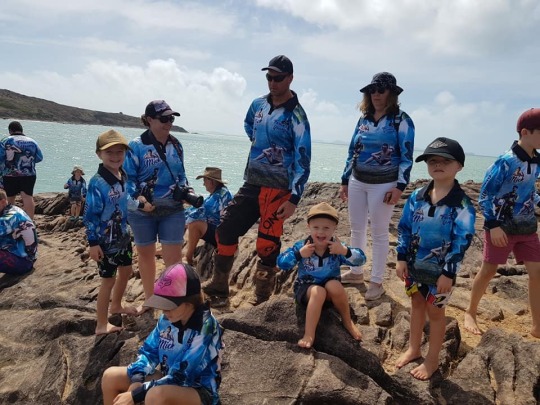
The Schleich crew!

All of us with Micky’s bike and helmet at the northernmost point of the Australian mainland.
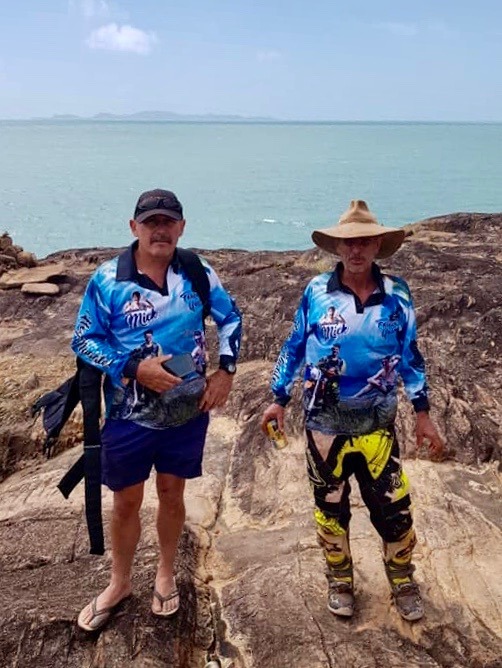
Russ and Scott - Evie’s two “Poppies”!
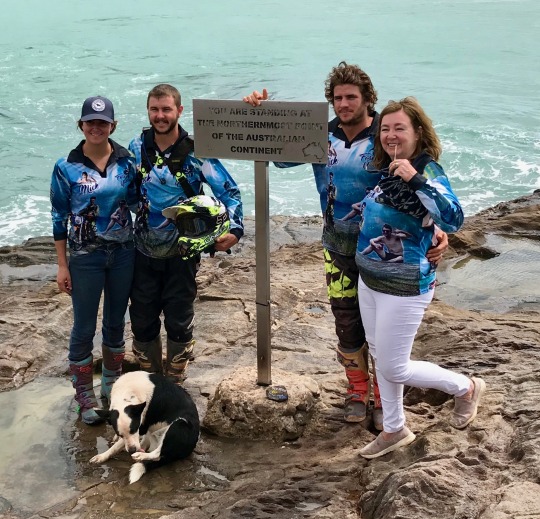
Granny Naj with Emily, Mark and Brad
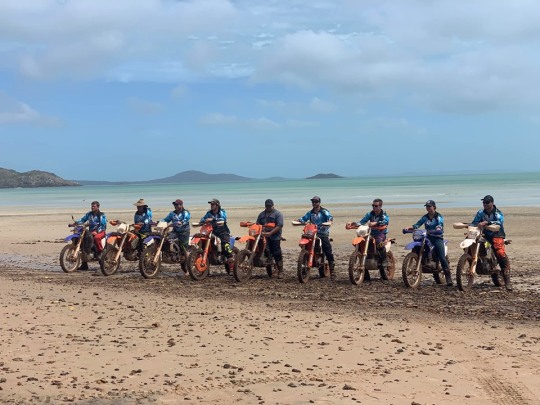
Riders once again lined up in a salute to Mick, before heading off for more adventures
We picnicked at historic Somerset beach on the eastern side of the Tip.
History of Somerset
John Jardine had migrated to New South Wales in 1840, and held a number of government appointments before being made Police Magistrate and Commissioner of Crown Lands at Somerset, at the tip of Cape York Peninsula, in 1864.
In 1865, 22-year-old Frank Jardine, his brother Alexander and eight others drove a mob of cattle overland from Rockhampton to Somerset, a remarkable feat which made them heroes in colonial Queensland.
They started with 42 horses and 250 head of cattle. The trip took 10 months during which time the party was constantly opposed by the area's inhabitants as they forced their way through scrub and swamps and crossed at least six large rivers, including the Jardine River which was subsequently named after him. They reached Somerset on 2 March 1865 with 12 horses and 50 cattle. Jardine's men survived, in poor health; they left a trail of dead Aborigines, dead horses and cattle and all their equipment.
For their pioneering exploratory efforts the Jardine brothers were made Fellows of the Royal Geographical Society and awarded the Society's Murchison Award in 1886.
Frank Jardine became in effect a law unto himself in northern most Queensland and is reputed to have been extremely cruel and barbaric.
The local Indigenous population was dispossessed and there was hostility between them and the Jardine family, both during Frank and Alick Jardine's expedition to Somerset, and during the years of the settlement. Jardine was also suspended for a time from his duties as Police Magistrate whilst being investigated in relation to using his position to obtain a pearl diving licence.
In 1873, Jardine married Sana Solia, the seventeen-year-old niece of the King of Samoa. They had two sons and two daughters, and the marriage endured until Jardine’s death from leprosy in 1919. Their graves can still be seen here at Somerset.
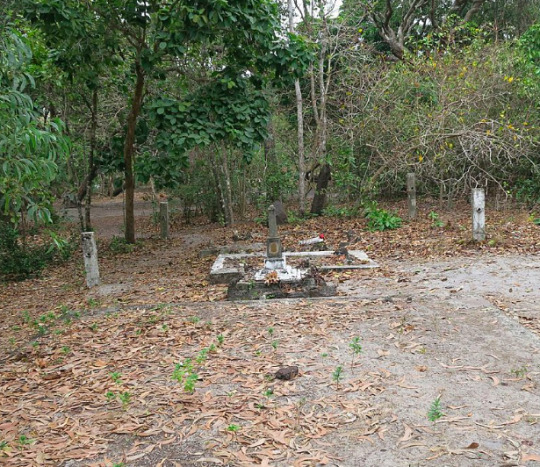
The pearl diving industry was important to the Queensland economy, and came to be dominated by Japanese divers after 1891. Kobori Itchimatsu came from the village of Nishi Mukai in Wakayama prefecture, an area that provided 80 per cent of the 7,000 Japanese who left their country to become pearl divers.

The earliest known burial was that of Cancan, a pearl diver, dating to 1890. Japanese pearl diver Kobori Itchimatsu was also buried there in 1909. Both graves are situated in the north area of the site.
Several Indigenous groups occupied this region prior to European contact. In an 1896 report to the Queensland Government, Archibald Meston estimated that in the 1870s the Indigenous population between Newcastle Bay and Cape York was around 3,000. At the time of writing his report, he believed that the population had fallen to around 300. This rapid decline was caused by a number of factors, including introduced disease, exclusions from traditional hunting grounds and frontier violence. Reverend Frederick Charles Jagg, a missionary at Somerset appointed by the Society for the Propagation of the Gospel, gave an indication of the relationship between European and Indigenous peoples when he reported in 1867 that "The aborigines have been described as the most degraded, treacherous and bloodthirsty beings in existence by the present Police Magistrate, and those whose only idea is to shoot them down whenever they were seen".
Somerset became redundant as a port once a safer shipping route to the Torres Strait was found and a settlement on Thursday Island was built from 1876. Frank Jardine continued to live at Somerset, maintaining the police residence until his death there in March 1919. During this time, Jardine continued to maintain a beef cattle herd; was engaged in the pearling industry; and created a coconut/copra plantation at Somerset.
Due to Somerset's isolated location the Jardine family provided assistance and hospitality to travellers and seafarers, for example, Jardine aided the survivors of the shipwreck of RMS Quetta in 1890.
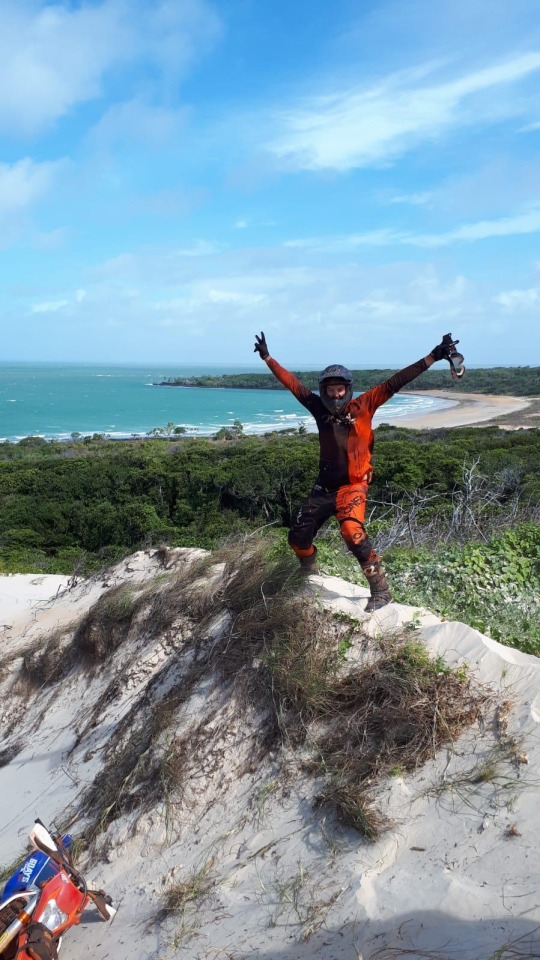
Aaron conquering the five beach trail ride on the eastern side of the Cape overlooking Freshwater Bay.
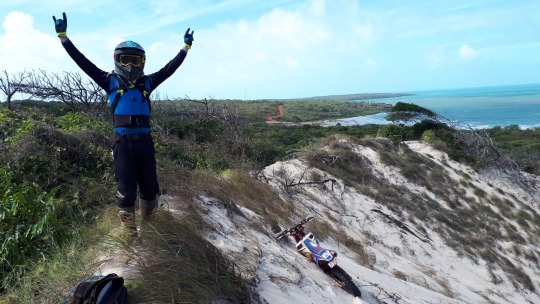
Remote and tricky - one rider did not make it, his bike seizing up in the excessive sand hills.
While the big boys were exploring the dunes, the little ones had fun riding up and down this remote sandy shoreline.
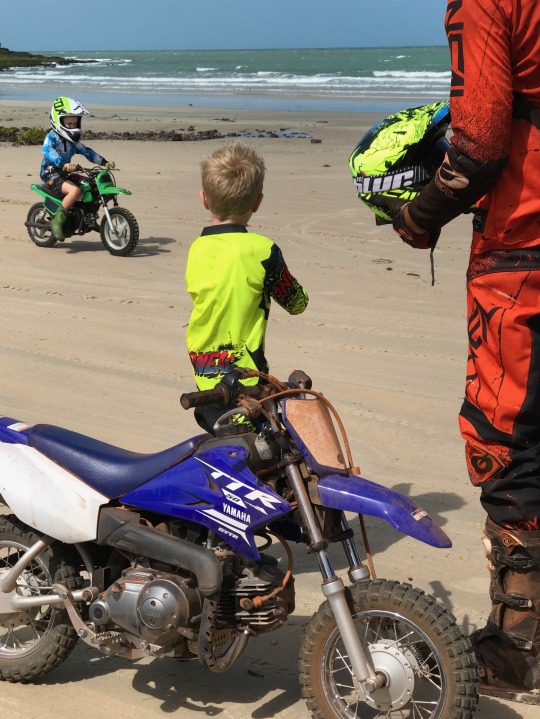
Beau getting ready to ride

Helmet: check; Gloves: check ....
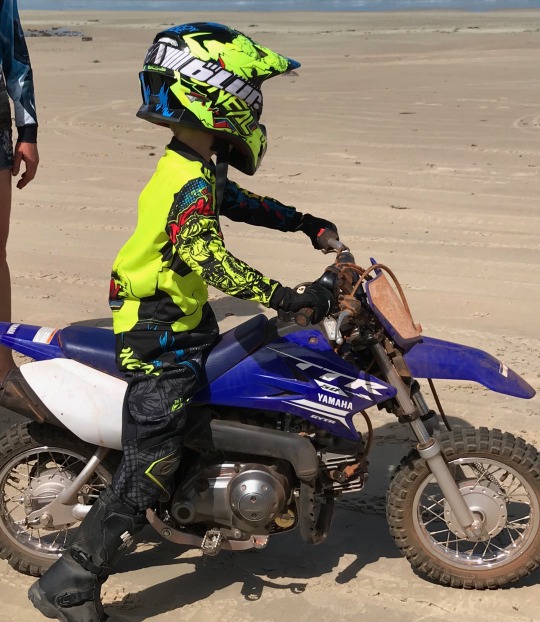
Go Beau!
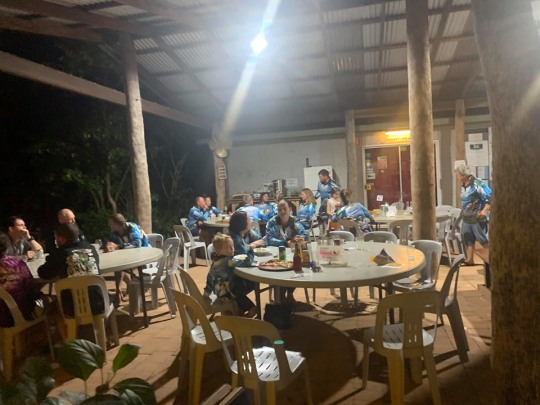
Dinner Saturday night at Punsand Bay with us all wearing out Micky Memorial shirts. Tourists to the area were curious and a few came over for a chat. Day 4: Sunday 4th of August
Punsand Bay to Bramwell Station
We de-camped and got away reasonably early and met up with the riders on the southern side of the Jardine River Ferry, then we drove in convoy to Fruit Bat Falls for our final lunch together. The wind was blowing a gale so jumping in the water was not so inviting. Scott gave a wonderful speech thanking everyone for coming, and proposing that we do it again next year - at a different location though. Everyone thought it was a great idea.
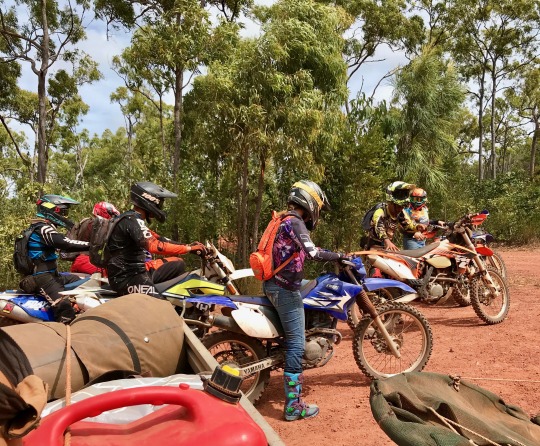
The riders once again tackled the Old Telegraph track, this time including Emily who by now had become an experienced rider, and crazy Josh, who, despite his broken foot, chose to once again ride this treacherous stretch of road .... well, more a track than a road! Mind you he still did not know it was actually broken!
Next stop was the campground at Bramwell Station.

Setting up camp at Bramwell Station

Sunset on Bramwell Station
Normie Rowe and The Bagman were performing the night we were there. The restaurant was booked out but we were able to wander up and enjoy the concert. The young ones thought that Normie was a bit old hat, but Bagman brought the house down with his bush poetry. Tears of laughter!
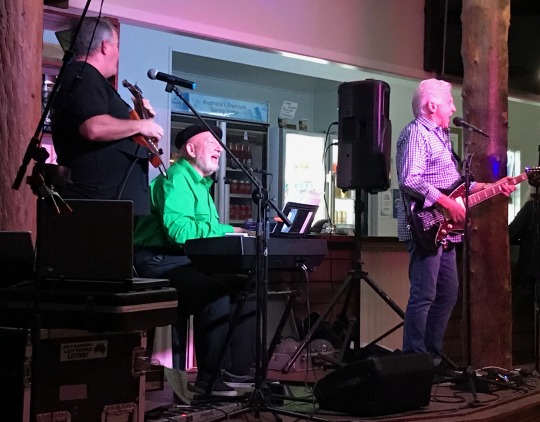
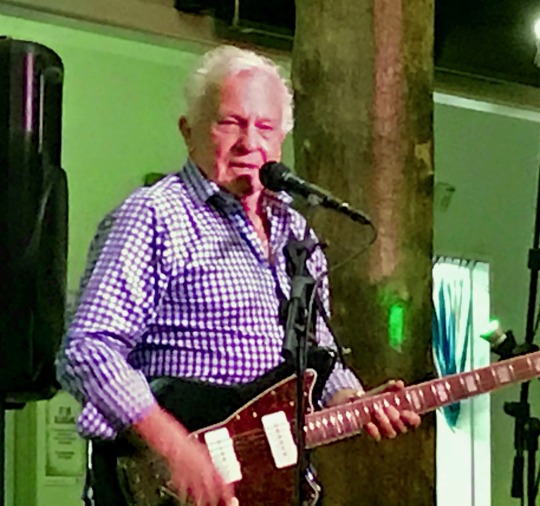
Normie Rowe
Day 5: Monday 5th of August
Bramwell Station to Weipa
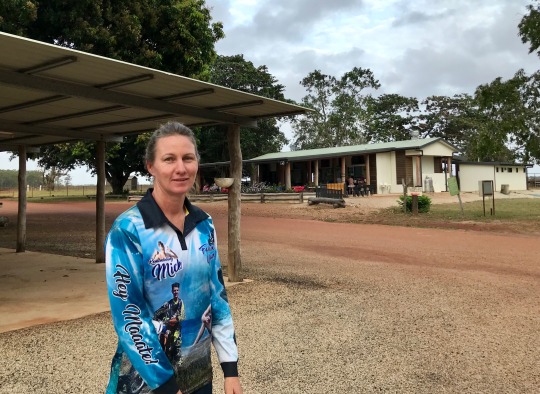
Rachael with the Bramwell Station restaurant and bar in the background
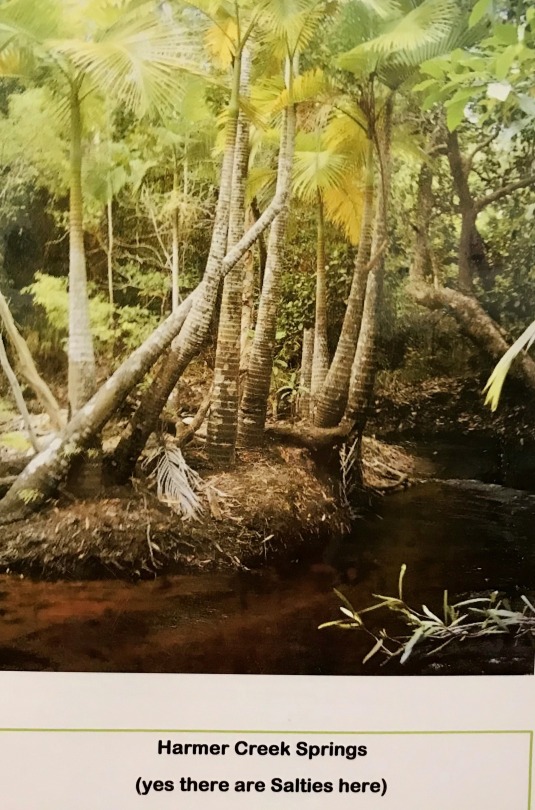
Photos from Bramwell Museum
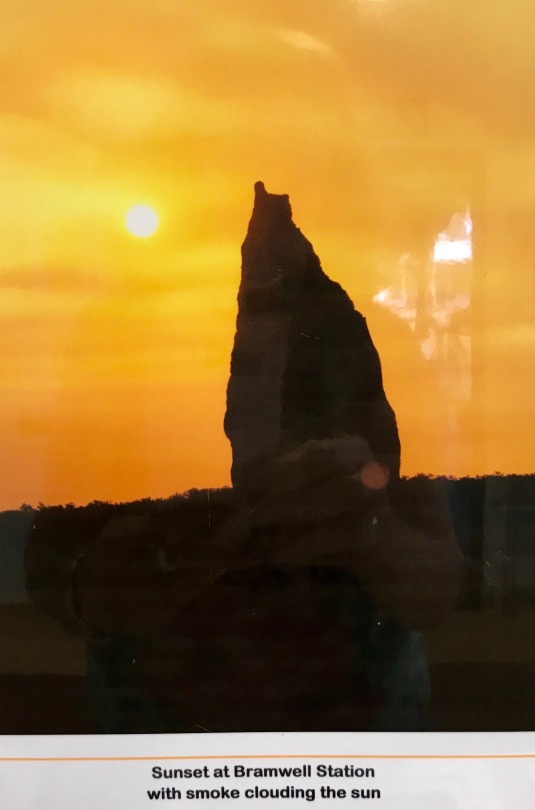
Photos from Bramwell Museum - these huge termite mounds are a typical feature of the Cape York scrub

Photos from Bramwell Museum The Cuscus is a marsupial unique to Cape York.
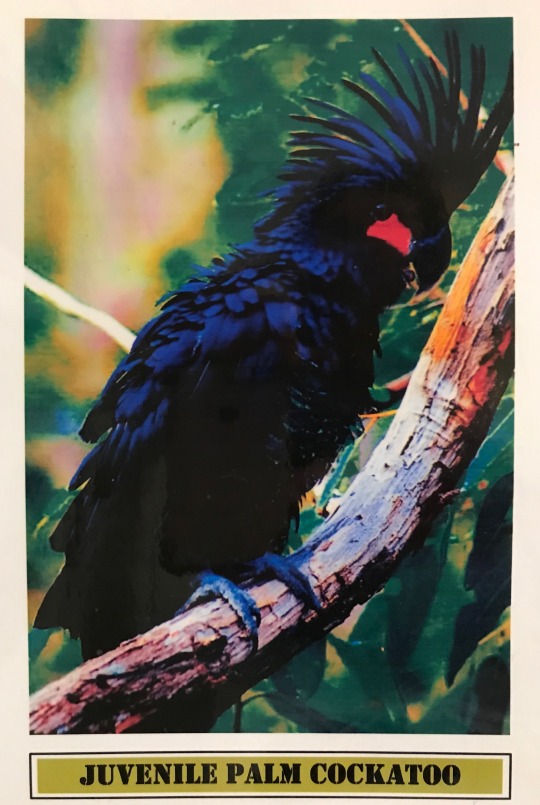
Photos from Bramwell Museum - the largest cockatoo in the world! It is sacred to indigenous tribes.
And here we end this epic saga. Bramwell is just two hours drive from Weipa where the journey ended on Monday lunchtime, time for Emily to pack and board her flight to Brisbane. The Charters Towers mob and Ron and Sue continued driving south rather then returning to Weipa, while Scott & Rachael, Mark (headed for Cairns), Brad, Ash, her dad Russ and baby Evie (headed for Townsville) all departed early Wednesday. But not before Scott had sampled his favourite meal in Weipa - Sizzling Duck at the Thai restaurant on Tuesday night ..... one more time to all be together before heading our separate ways. No pics I am sorry! As Peter Cundel used to say: That’s your blooming lot!
Thanks everyone for making this trip so memorable!
Until next time .......
0 notes
Text
Jenny & Naji’s Road Trip to SYD & CAN Sept 2017
Long time friends, this trip was planned after our earlier Sydney trip last February. Jenny flew into the Gold Coast Thursday evening and we met at dear friend Hilary’s home in Tallebudgera. What a gorgeous catch-up with Hilary’s family over dinner and meeting Hil’s granddaughter Neve!
Back home in Mullum we created an amazing (if I say so myself) avocado dip with sheep’s feta (super yummy) and discussed what to take on this road trip, then we crashed - I was pooped after a previous late night, 8 hours intense bookkeeping work, and a 2 hour drive over the Burringbar Range. Zzzzz
We were up before dawn for a beach walk at Brunz, followed by a coffee date with friends, Inta and Anne. Perfect considering that we would be fairly sedentary for the next two days.

Sunrise Brunswick Heads, Equinox, 22/9/17
We were back home by 8.30am. Jenny then wandered up to the Farmers Market just 2 blocks away to get some more supplies for the journey, while I hastily packed for hot Sydney and freezing Canberra. Luckily we were travelling by road so I could throw in enough to cover all contingencies.
We were on the road by 11am - great start!
Byron Bay to Port Macquarie was a nightmare drive - so much roadwork, trucks, police and mad drivers. It was a relief to arrive at our superb accommodation in Port Macquarie. Highly recommended is Hill Street B&B. Clean, quiet, well provisioned and great location!

Sun setting over Port Macquarie
Once settled we set off on foot to see where we had landed - just a few short blocks from a stunning coastline. What a picturesque town! So many beaches and rocky coves, cliff walks, and a dizzy array restaurants to choose from in the town centre. We choose seafood of course - Thai style. After passing all the oyster beds and signs offering fresh fish coming into town we were ready - two hungry diners!

Flynn’s Beach, Port Macquarie
Saturday’s drive from Port Macquarie to Sydney was a peaceful easy run - the complete opposite to the day before. What a relief. Jenny has christened my navigator “Vivian” - it’s the voice from the phone app Maps. She guided us easily into central Sydney where we were delightfully pleased with our accommodation - the newly refurbished Randwick Lodge. The location could not have been better. This was our home for the next three nights and our base to explore Coogee and Randwick.
Jenny’s friend Steve picked us up at 4pm and drove us to The Old Fitzroy, a boutique pub hidden in the back streets of Woolloomooloo, where we shared stories on a leafy back deck.

The Old Fitzroy
What a fascinating piece of Sydney history right there. It was a short but poignant meeting as Steve has been unwell. At the end of the day it is our connection to each other, our friends, that is most treasured, is it not?
Stepping out into Saturday night Sydney was exciting - a far cry from my quiet retreat in Mullumbimby. We ended up at The Cookhouse (a play on words as there is an impressive statue of Captain James Cook right outside), right across the road, sampling various Tapas. Too easy!

Tapas @ The Cookhouse
Sunday, after a morning walk to Coogee Beach, we headed across to the Northern Beaches to my niece’s home in Freshwater. We enjoyed a great day with Krista and her two little girls aged 3 and 5. So cute. They are in the midst of full-on kitchen renovations with a camp kitchen set up in the living room. The change, once complete, will be stunning.
Sunday night we dined “in" enjoying the remainder of our Farmers Market delicacies in the picnic basket - cheese platter, wine, olives, baby tomatoes, home made grapefruit juice and chocolate brownies.
Monday was a pamper day with a hairdresser’s appointment at funky INCH Salon (www.inchhairdesigns.com/home) followed by a walk to Coogee for lunch and shopping, but unfortunately (or fortunately - depends on which way you look at it) there were very little arty boutique stores in Coogee - clearly the focus of people in Coogee is FOOD, and sun, sand and surf.

Quaint storage solutions @ INCH Salon

“Proud of our Elders” mural in Randwick, showing in the lower left corner Alice Grundy who was a founding member of the Coogee Ladies Pool, now known as the McIver’s Baths.

Unobtrusive sign showing the way to the private McIvers Baths

“Rock lobsters” soaking up the sun at the McIver’s Baths
After another dip in the McIvers Baths (women and children only) we chose a different route home and enjoyed the old buildings and prolific plant life around this hilly suburb.

St Brigids, Coogee
Designed by Albert Bates, the Church was modelled on the design of Westminster Cathedral in London and is a fine example of the Romanesque (or Byzantine period) revival designs of the late nineteenth and early twentieth century. It features polychromatic (light and dark bands) brickwork and a curved vaulted ceiling under a traditional cruciform roof, small arched windows and simple buttresses. The parish priest at the time specified that the interior be vast and spacious. Six main pillars on each side support the roof. Especially significant is the face brickwork which was a bold design statement by the original architect and is unique in Sydney.

North Queensland ‘bushy�� seen strolling the back streets of Coogee!!
Steve had told us about “The Spot” - and on the walk back we discovered it - right near a funky old picture theatre. This must be restaurant central in Randwick - so many cuisines to choose from. The standout for us was The Sweet Spot (18 Perouse Road). OMG - European style cakes and sweets to die for. Of course we had to sample some. It was very difficult deciding which one to choose!!!
Tuesday we headed down to Canberra, via Bowral, where we made a surprise visit to Jenny’s auntie - an amazingly sprightly 90 year old who is passionate about her garden and sculpts and paints in her spare time - and onto Goulburn for a picnic lunch in the park.

Tulips in Central Park, Goulburn

We are dining quite well, as you can see!

Picture perfect location for our picnic lunch

Across the road is the majestic Courthouse
Designed by Colonial Architect, James Barnet, this magnificent Victorian Italianate style building is Goulburn’s fourth court house. It was opened by the then Chief Justice who remarked: “A courtroom which I venture to say, takes rank amongst the best courtrooms in any part of Her Majesty’s dominions.”

The large copper roof dome was designed by the London trained architect, Ramsey, and the carving on the large sandstone gateposts at the entrance to the grounds was the work of David Baldwin of Sydney. Today the Goulburn Court House is still very much in use and holds sessions of the Local Court, District Court and Supreme Court.

Flowering shrubs beside The Q in Queanbeyan - our home for the next four nights.
Canberra:
I received such a warm welcome from the staff at Dr Da Cruz Wholistic Dental practice in Queanbeyan. I used to travel here on a bi-monthly basis doing craniosacral sessions on his patients, but since starting full time work last January I had not been back. Fortunately my clients are very patient and forgiving! I have lined up two days of sessions while I am here, staying right across the road from the surgery, which is only a 15 minute drive from central Canberra. For me it was like coming home. I love visiting this area - so vibrant, and so different to the tropical north coast.
This is Jenny’s first visit to Canberra so we had a short list of places to visit. The first place of interest was the Australian War Memorial. This is a difficult place to visit - Jenny could not believe that this was my third time! It brings up so many emotions, mostly grief and sadness. It is a memorial to the futility of war and man’s inhumanity to man.

Electric machine used for the treatment of nervous disorders
“Shell Shock, or “war neurosis”, became increasingly evident during the war. A hitherto almost unknown form of mental collapse among soldiers, shell shock was caused by the strain and trauma of industrialised warfare. Symptoms included any of a variety of afflictions, such as muteness, paralysis, amnesia, convulsions, hysteria and insanity. Attempts to understand and “cure” the condition led to widespread use of controversial treatments such as hypnosis and electric shock. However, it was many years before a full psychological understanding of the condition developed.”

View from Mt Ainslie
After leaving the War Memorial we ascended the mountain behind it called Mt Ainslie. Here we stand on the ley line that runs through the city - the dome of the War Memorial is in the foreground, then the broad tree-lined Anzac Avenue directs the eye across Lake Burley Griffin to old Parliament House (the white building in the middle distance), behind which you can make out the spire that sits atop the new Parliament House.
Before heading home I drove by the National Gallery of Australia (NGA), Questacon (the Science Museum) and the National Library to give Jenny an idea of where to spend her spare day while I was seeing clients in Queanbeyan the following day. I once again managed to get lost amongst the many circular ring roads that always messes with my sense of direction.

Entry to the National Gallery of Australia

Risking a parking infringement I quickly showed Jenny the entrance to James Turrell’s Skyspace permanent exhibit in the grounds of the NGA. Inside is a large square-based pyramid with soft red ochre interior walls. A stupa made of Victorian basalt rises at the centre, highlighted by turquoise water. The stupa contains the viewing chamber—a simple domed space, open to the sky. A moonstone, set into the centre of the floor, echoes the oculus above. It is loved for its technical mastery and physical beauty. Jenny was so glad the next day - she said she would have missed it if I had not shown her. I recently read that it has become a popular place for lovers to meet. One is especially recommended to view it at dawn and dusk. It is open 24 hours. If you find yourself in Canberra, don’t miss it!
Spring in Canberra means Floriade - the annual Flower Festival. And what a feast for the senses! It was on for that whole week, down on the shores of Lake Burley Griffin. Acres of colourful tulips and pansies planted in all sorts of ways. Truly a feast for the senses.

Jenny framed in an acre of tulips at Floriade

An island of tulips - you can forget you are in the middle of a capital city!

Yours truly soaking up the flower power!

A barrow load of tulips

Now here is a great idea for recycling those old wooden pallets!

Just love the colours in this specimen!
The next “Must See” was the National Museum which had a special exhibition just opened called Songlines. Situated on the banks of Lake Burley Griffin, this stunning modern building contains a dizzying array of artefacts Australia’s history. Well worth the visit at any time.

Entry to the National Museum
Check out Chris, the sheep’s world's heaviest fleece on display. It was shorn after he was discovered roaming Mulligans Flat near Canberra wearing about six years' worth of fleece. He could barely walk when he was rescued by the RSPCA and underwent an emergency shearing by national champion Ian Elkins. (www.abc.net.au/news/2015-09-03/wool-world-record-set-after-42kg-fleece-shorn-off-canberra-sheep/6746200) National Museum of Australia director Mathew Trinca said the fleece is an important icon for animal welfare in Australia.

Chris, the sheep at Mulligans Flat near Canberra
Songlines: Tracking the Seven Sisters - a journey into the heart of Australia
This is the first exhibition of its kind, attempting to tell, in an exhibition space, an Indigenous founding narrative sharing an ancient way of holding culture and telling stories written in the land.
Visitors to the exhibition experience a multi-sensory journey, from an explosion of colour and movement on entering an immersive desert experience, to extraordinary art, sculpture, interactive screens, ceramics and story telling.
This exhibition is a direct response to an Anangu request to help preserve and communicate the knowledge of the Ancestors. Originally, stories were performed by custodians on country, enacting the activities of the Ancestors in the places where they happened. As access to many of these places became difficult, and knowledge held by fewer and older people, new ways of passing on knowledge have become necessary.

National Museum of Australia Exhibition: Songlines: Tracking the Seven Sisters
Songlines, or Dreaming tracks, map the routes and activities of Ancestral beings as they travelled across Australia. There are major longlines that cross the continent and more localised tracks connecting only a few sites. Songlines are a sophisticated knowledge system with ancient origins. It has many layers of knowledge, and many degrees of access, from its public version to the secret / sacred levels available only to the most senior custodians.
Like the epic poems of the great oral traditions, songlines are a way of holding and passing on knowledge. They contain protocols of behaviour and information for survival in an unpredictable and volatile environment - where water and food can be found, where there is potential risk, and how to act to minimise that risk. “It is these mythic stories that are Australia’s Book of Genesis.” (Noel Patterson, A Rightful Place, 2014)
The Seven Sisters Dreaming is an epic saga of the ancestral Seven Sisters’ journey across Australia’s Central and Western deserts - a story of intrigue, desire, drama, passion and beauty.

Sculptural depiction of the Seven Sisters at the entrance to the exhibition
As part of the exhibition there is a state-of-the-art six-metre digital dome where visitors are invited to lie down and experience what it is like standing beneath the rock art at the site of Walinynga (Cave Hill) - the only known rock art depicting the Seven Sisters. The dome also features time-lapse vision of Orion and Pleiades, with animated art and “sisters” flying across the night sky. It is an experience like no other.

Seven Sisters Songline 1994 by Josephine Mick, Ninuku Arts - acrylic on particle board -
Josephine visualises the endless journeys of the Seven Sisters from the west near Roebourne to the east, in the creation of the Australian continent. She acknowledges the existence of the Seven Sisters story on other peoples’ country with large black circles surrounded by tiny dots, including major cities and the lands of the Kamilaroi and the Bundjalung peoples. The central node shows her homeland in the APY Lands south of the tri-state border. The work is now incomplete, as the map of Tasmania went missing following an international exhibition.

Baskets 2008-09 by Ngamaru Bidu, Kanu Nancy Taylor and Mantararr Rosie Williams, Martumili Artists - plant fibre (minari grass) and yarn -

Parnngurr Rock Hole 2015 by Bugai Whyoulter, Martumili Artists - acrylic on linen -
“I saw white fellas first here in Parnngurr. We were climbing up the hills (behind the rock hole).” Bugai Whyoulter, 2008
The Seven Sisters flew past the Parnngurr rock hole up to Nyinanyinanja where they sat on the hill and watched for Yurla. At a camp nearby, Yurla sent part of his body underground to surprise them while they slept. They fled and flew to Kalypa (Well 23). Parnngurr is where artist Bugai and her family, forced by drought, gathered 50 years ago to be taken to Jigalong mission. As they prepared to drive to the mission, it was announced on the radio that the American president John F Kennedy had been shot.


Parnngurr songline

Yarrkalpa (Hunting Ground) 2013
The painting Yarrkalpa is encyclopaedic, containing a nuanced knowledge of plants and animals, of seasons and fire, of permanent water and ephemeral soaks. It is also a topographic replica of the landscape around Parnngurr: ranges and sand-hills, creeks and rock holes. The Minyipuru flit across the western side of the painting, pursued by Yurla. Their presence in the painting is incidental, just one strand in the fabric of Martu daily life.

This (and below close-ups) is a breakdown of all the parts of Yarrkalpa (Hunting Ground) showing its encyclopaedic nature





Intricate detail of Yarrkalpa (Hunting Ground) 2013

Tjitji Kutjara 2011 by Alison Mukti Riley, Tjala Arts - acrylic on linen -
People inherit Tjukurpa from both sides of the family and have access to multiple, intersecting Dreamings. Time and circumstance can sometimes obscure memories and meanings. This work was initially documented as a painting of the Seven Sisters Tjukurpa, but when the artist resisted it she insisted that it was the story of Tjitji Kutjara, two boys who meet Mamu (a harmful spirit).

Snake sculptures 1982-92
by Ikula, Niningka Lewis, Mildred Nyunkiya Lyons, Nora, Jean Inyalanka Burke, Billy Cooley, Pulya Taylor, Nellie Nungarrayi Patterson, Tiger and Kanginy, Maruku Arts wood.
“I started making panu (wooden objects) in 1972 … I saw people making snakes from flat pieces of wood. I thought I make them real with the head standing up … I used to look for the roots within the creek-bed and in the tree branches. Oh, I can see a good snake right there. I cut the root of the branch and work out a tail here and a head at this end.” Billy Cooley, 2017
The Seven Sisters story is largely associated with danger, fear and passion. Wait Nyiru and the sisters also represents the different but complimentary roles men and women play in daily life and ceremony.
In the ancient songs of the APY Lands we hear an inflection in Wati Nyiru’s voice that we don’t encounter in other places. ‘Why don’t they like me? Why do they run away from me?’ he wonders. He checks his footprint, which reveals seven toes, then five, then three. He rejects it - such a deformed, unstable thing surely can’t be part of him. But the proof is in his footprint, and he realises, ‘Oh no, there is something wrong with me. I’m a sorcerer. That’s why they run away from me.’
Like other flawed and narcissistic characters who inhabit the great epics of all cultures, Wati Nyiru suffers conflict between reason and passion, good and evil.

Seven Sisters, 2016 by Yaritji Young, Tjala Arts - acrylic on linen -
“I hold my father’s story, I hold my mother’s story … [it] doesn’t come out of paper or out of a book. It’s coming out of the ground here. [My way] is different … it comes from the inside out.” Tjunkara Ken, Yaritji Young’s sister, 2015
Yaritji has rights to many songlines, inherited from both sides of her family. From her father she inherits rights to both the Tjala (Honey Ant) and Kungkarangkalpa (Seven Sisters) Tjukurpa. The power and proliferation of these intersecting songlines radiate from this energetic painting.

Kungkarangkalpa Atila (Seven Sisters at Atila) 2013 by Derek Jungarrayi Thompson, Ernabella Arts - glazed porcelaneous stoneware with underglaze -
“I had been looking every day at Chinese pots - at the museum and gallery in Shanghai … [to draw] my father’s country.” Derek Jungarrayi Thompson, 2014
Derek references his father’s country around Atila in this artwork, which tells the story of the sisters being spied on by Wati Nyiru and their journey along the underground waterways. That a Chinese-influenced ceramic work by a young male artist can be drawn into the orbit of the Seven Sisters indicates the flexibility of the Tjukurpa to contemporary interpretation and experimentation.

Kungkarangkalpa - Seven Sisters, 2015 by Tjungkara Ken, YaritjiYoung, Maringka Tunkin, Freda Brady and Sandra Ken, Tjala Arts - acrylic on canvas -
One night in 2014, Tjungkara Ken, the youngest of five sisters, dreamed about painting on a round canvas. This circular painting by Tjungkara and her sisters is the result. It tracks the journey of th Kungkarangkalpa across 600 kilometres from parka in the Northern Territory through South Australia to Kuru Ala in Western Australia. It is an encyclopaedic map conveying knowledge, carried in the songlines, about bush medicine, bush food and water sources.
Such a stunning exhibition. If you ever get the chance .......
Before leaving Canberra we were invited for dinner with fellow craniosacral practitioner and friend Simon Nash and his wife Daniella and beautiful daughter Sophia. It was so nice to see them again, and Daniella’s mum, Lillian, who I had stayed with last year for Simon’s 40th birthday celebration. We really “bonded”!!!
Lillian recently started a vegan catering business which has been a great success - check out Lily’s Vegan Kitchen at:
www.lilysvegankitchen.com.au
Here is Lillian’s brilliant recipe for Cashew “Cheese” Dip (a special just for you dear readers):
Ingredients:
1 cup raw cashews (soaked)
1/4 cup filtered water
1/4 cup nutritional yeast
1 tablespoon lemon juice
2 cloves garlic
2 tablespoons white wine or 1 Tbs. raw apple cider vinegar
1-2 teaspoons Dijon mustard
sea salt and pepper to taste
Directions:
Add all ingredients to a high-speed blender and blend until thick and creamy.
It will be the consistency of thawed or stirred cream cheese.
This will further harden after it’s been chilled.
Store in the refrigerator for up to 5-7 days.

Lillian with granddaughter Sophia
So now it was time to head back home, but I could not let Jenny leave Canberra without visiting the seat of Government: Parliament House! We lucked out with a guided tour before we began our journey home.
Parliament House was designed to encourage public access and involvement while responding to the Australian climate, landscape, vegetation, and even the quality of the light. It was designed to be both a functional building and a major national symbol.

Forecourt and Great Verandah of Parliament House
The forecourt reflects Australia’s ancient beginnings. Aboriginal artist Michael Nelson Jagamara designed the 196-square-metre mosaic. The artist described the work and its importance at Parliament House:
“it…stands for this place where all people come and meet together…These Dreamings are part of this country that we live in…We've been trying to explain what the land means to us for the sake of all Australians.”

View from the entrance of Parliament House back towards Mt Ainslie, Jenny strolling in the foreground
Entering the Great Hall, this is an extract from Cook’s Journal on display:
“From what I have said of the Natives of New Holland they may appear to some to be the most wretched people upon Earth, but in reality they are far happier than we Europeans being wholly unacquainted not only with the superfluous but the necessary conveniences so much sought after in Europe, they are happy in not knowing the use of them. They live in Tranquility which is not disturb’d by the Inequality of Condition: The Earth and sea of their own accord furnishes them with all things necessary for life, they covet not Magnificent Houses, Household-stuff etc, they live in a warm and fine climate and enjoy a very wholesome Air, so that they have very little need for Clothing and this they seem to be fully sensible of, for many to whom we gave Cloth etc to, left it carelessly upon the Sea beach and in the woods as a thing they had no manner of use for. In short they seem’d to set no Value upon any thing we gave them, nor would they ever part with any thing of their own for any one article we could offer them; this in my opinion argues that they think themselves provided with all the necessarys of Life and that they have no superfluities.”
James Cook, as recorded in J C Beaglehole ed., The Journal of Captain James Cook on his Voyage of Discovery. Vol. 1. The Voyage of the Endeavour 1768-1771 (Cambridge, UK 1955) p 399.

View of one of the inner courtyards of Parliament House
The Great Hall is dominated by the Great Hall Tapestry, designed by renowned Australian artist Arthur Boyd in collaboration with the Victorian Tapestry Workshop. Woven in four separate pieces, it took fourteen full-time weavers more than two years to complete.

Design for Great Hall Tapestry, 1984 Arthur Boyd - oil on canvas -
Arthur Boyd is one of Australia’s best-known artists. His paintings of the Australian landscape portray the character of the environment and convey to viewers the essential beauty of our country. This is clearly in the untitled design for the Great Hall Tapestry. This picture celebrates our coastal forests, the artist’s deep affection for his subject and his ability to transfer that affection onto the canvas.

The roof
From the roof, you can see how Parliament House is successfully integrated into Walter Burley Griffin's original design for Canberra. It is placed on the land axis from Mount Ainslie, which runs directly through the centre of Capital Hill. The architects crossed this axis with the legislative axis, which features both Houses of Parliament linked by the Members’ Hall.
Looking north from the roof, you can see Australian War Memorial, Lake Burley Griffin and Museum of Australian Democracy at Old Parliament House. The building was designed to harmonise with the architectural features of Old Parliament House and to allow the older building to retain its unique identity.
So now we turned our sights towards home, heading north towards the Hunter Valley, bypassing Sydney as best we could. Happy I was that “Vivian” was able to guide me through the maze of unfamiliar roads. We stayed at a motel in Singleton, amidst rain and the footy Grand Final! Not our cup of tea, but the accommodation was fine. The next day’s travel we wanted to do the foodie tour, breakfasting at one town, lunch at another, craft at another. It was a fun journey and we were very thankful to friend Anne for her suggestions of the Plains Pantry at Willow Tree on the New England Highway. Highly recommended. I picked up some local dessert wine and some goats cheese for a special birthday treat.

We also stopped at Uralla for a picnic lunch and very much enjoyed visiting the Barking Dog Gallery which showcased local ceramics, glass & wood products. (www.barkingdoggallery.com.au). It is situated right next to the famous wool store - supplier of wool and superb knitwear. Bring your pocket book! The area is famous for its superfine wool production through the breeding of Merino sheep.
That night we stopped at historic Tenterfield, known as The Birthplace of Our Nation. This is where Sir Henry Parkes presented his famous Federation Speech in 1889, which led to the federation of all the Australian states into the Commonwealth of Australia in 1901. It is also where well known poet Banjo Paterson got married. The area around is famous for being he hide out of Captain Thunderbolt, the bushranger. Situated on the northern part of the New England Tablelands at an altitude of 850 metres (2,790 ft) above sea level, the weather is often brisk, with temperatures below freezing in winter.
We cozied up in our little motel room and planned for an early start to reach Brisbane by late morning.
We were on the road early, and just up the road we chanced upon the Celtic Stone Circle in Glen Innes! Fantastic!

Jenny’s family is from Scotland so the Scottish story behind Glen Innes was appreciated
Symbolism of the Stones
The complex comprises thirty-eight stones.
The three stones in the centre represent Australia (Australis Stone), Scotland Ireland and the Isle of Man (The Gaelic Stone), and Wales, Cornwall and Brittany (The Brythonic Stone).
Seven stones mark where the rising and setting sun shows the summer solstice and the winter solstice.
Four extra stones mark the four directions. Together with the Summer solstice sunrise stone, they mirror The Southern Cross, the welcoming constellation in the Australian sky which symbolises the old world meeting the new.
The circle of stones plus the four directions stones also form the Celtic Cross, a symbol of the early Christian church, still used by the Catholic Church.
Surrounding it all is a circle of 24 stones representing the hours of the day.


Jenny next to one of the standing stones
Pretty soon we were crossing the border and was in central Brisbane in no time. I dropped Jenny off at her Aunt’s place and continued south to meet up with my family for a birthday lunch on the Gold Coast. It was all over way to soon!

Thanks Jenny for your warm friendship and for being an easy travel companion. We banked lots of memories this trip! Till next time. xxx

0 notes
Text
A Traveller’s Tale
The Ancestral Bridge: A Sacred Water Wisdom Dowsing Journey - Australia 31st March to 13th April 2017
Invocation
“To the ancestors who walked with Wisdom and courage to keep the dream of peace alive;
To all who honour the circle;
To our family, to our friends who walk the trail together;
To the Spirit of the Stone and its carvers and its keepers;
To the Song of the Stone in the hope and the truth that we may learn to hear the music of the land;
To our journey and to the many trails that we will share together.”
(This dedication is a quote by Barry Brailsford, a New Zealand dowser and author of “Song of Waitaha”.)
This journey is the culmination of my two year collaboration with the Sacred Evolutionary Dowsing Consortium led by Shelley Darling, founder of Golden Light Dowsing.

As an international collective we have been working with sacred sites around the world, educating each other, and doing collective remote dowsing on places that have been crying out for help (such as an unsafe corner of a state highway where there had been a number of fatalities, clearing EMF radiation around schools in the US, performing co-ordinated simultaneous land ceremony on Earth ley lines, setting up Hearts Across the World Facebook group bringing people together, and working on individual projects as a collective. It’s been amazing.
Shelley Darling is an Evolutionary Dowser, a Feng Shui consultant, GOOD of the WHOLE Founding Steward, a grandmother, a community connector and a Soul Resonance mentor for individuals and couples. Shelley’s passion and commitment is to support individuals and communities in the direct experience of the intelligence of the Unified “Heart” Field, as it magnificently awakens our collective consciousness, births new solutions, heals relationships, cultivates joy and restores Earth.
Julie Armstrong is a Steiner teacher and an amazing felt artist, and now a fierce Water Protector, being a founding member of Loving Waters, and has been consciously working with a small group of people around Canberra healing the land and promoting awareness of our precious rivers for many years. She is a founding member of ACT for Bees raising awareness of the plight of the bees, both here and worldwide.
Both these inspirational women walk their talk and it has been an honour to walk with them on this Ancestral Bridge journey, where we will walk ancient songlines and visit sacred sites.
Dowsing is a fascinating art with a long history. It has many applications in agriculture, in clearing geopathic stress from homes and schools, or simply to locate a lost object. Dr Patrick MacManaway, a renowned dowser, author and teacher, has produced some of the first scientific evidence of the effects of quantum physics in modern agriculture with yield increases in potatoes of 4%, 16%, 18%, 42% and 47% on five different varieties. He regularly comes to Australia to work with farmers helping increase yields. It is fantastic to have this work quantified by these results.

Because the itinerary for “The Ancestral Bridge: A Sacred Water Wisdom Dowsing Journey” can be found at www.lovingwaters.life/australian-itinerary, I won’t repeat all that is there. Rather this is my personal story of this whole experience. I hope you enjoy this armchair journey!
Shelley, Julie and I started planning this trip back in December 2016, over many emails and Zoom calls. (Zoom is a platform similar to Skype, and is a way of having group calls where we can see everyone.) Shelley was committed to travelling half the next year in New Zealand and Australia and we wanted her travels in Australia to be as impacting as possible – teaching workshops, giving sessions, perhaps offering a retreat. The idea of the Ancestral Bridge Tour was something that came to Shelley in 2010: “This journey will be an awakening and bridge that connects our personal lineage with our Ancestral Spirit and the Ancient ways. This pilgrimage is a sacred journey that holds within it the keys for self-expression, contribution and magic... “ I loved this and together we built on this idea to create an itinerary that would embrace all that these words inspire.
Unfortunately we did not allow sufficient lead-in time to make this journey truly viable with the numbers we would have liked, but we were committed. And so, with our brave solo guest Margie, from Byron Bay, the adventure began! We decided to make the first leg of the journey at “Bangalla” on Sydney’s Scotland Island, a weekend Dowsing Retreat which was complete in itself. For this we had five guests who had great fun exploring their new skills in this idyllic location on Sydney’s Pittwater, adjacent to the Ku-Ring-Gai Chase National Park. But, I am getting ahead of myself . . .
In mid February, Shelley left the USA for the first leg of her journey - touring with The Grandmothers in NZ, and spent some time with Barry Brailsford, one of her dowsing mentors. But that is another story which only she can tell!
16 March 2017
Shelley arrives in Sydney and is greeted at the airport by Julie who has driven up from Canberra to meet our teacher and friend. An introductory evening for the Golden Light Dowsing Retreat at “Bangalla” on 1-2 April was held at the home of Julie Regalado in Sydney’s Northern Beaches the next evening, which was not without incident (;-)) then Shelley & Julie drove to Canberra for a week of rest before embarking on the BIG one. Or so they thought . . .
22 March 2017
Following a call from Christopher Dean of Our Earth, Shelley & Julie decide to come to Byron Shire (where I live) to help Christopher anchor his ambitious vision for Starseed Gardens, a magical property on the outskirts of Byron Bay. He loved the synchronicity of Shelley’s arrival at this key moment of the unfolding of what he called “an earth repair portal”. He shared with us an amazing dowsing experience he had had some years earlier and was keen to meet Shelley. (Read more about Chris’ vision at www.OurEarth.online.) Also that weekend coincided with World Water Day and we were offered a stall for Loving Waters at a community event sponsored by the Byron Shire Council in Byron Bay on Saturday. So, we ended up offering a Free Introductory evening on the Friday night prior to presenting a Golden Light Dowsing Workshop on Sunday at Starseed Gardens.
I picked up the girls from the Gold Coast airport and drove them to my home in Mullumbimby – finally together with no computer screen between us!!! First up – a dawn walk on Brunswick Heads beach and a dip into the Pacific Ocean.

First light, Brunswick Heads
24 March 2017
On Friday evening Shelley presented a free Introductory talk at Temple Byron, an amazing venue set on three acres of lush tropical vegetation, amid landscaped gardens and crystal lined walkways. We wanted to peak people’s interest in coming to the dowsing workshop on Sunday. It was well attended and was followed by a lively question and answer session.

Julie and Shelley

The Community Hall where the event was held
Having a stall at the Byron Bay Wetlands Open Day event was a synchronous fluke that allowed us to promote Loving Waters and network with other water Protectors both near and far.

The most exciting activity for me was the scientific verification of the work of Dr Masumo Emoto. (Dr Emoto gained worldwide acclaim through his groundbreaking research and discovery that water is deeply connected to our individual and collective consciousness. He is the author of “ Messages from Water” and “The True Power of Water”. He is a long-time advocate for peace in relation to water.)
At the event there was an interactive display of water taken from various catchment areas in the Byron Shire. One specimen was selected, tested for Ph and alkalinity and a small group of us (including eminent Biologist Dr Mary Gardiner) proceeded to do a water ceremony whereby we gave thanks to the water and repeated the words: “Water We Love You, Water We Respect You, Water We Thank You.” The water was in a beaker on the ground and was not touched or interfered with in any way. After this ceremony the water was returned and again tested, and it was found that the Ph had moved from 6 to 6.5 (become less acidic) and the alkalinity had gone from 30 to 60.

Before and after Water Blessing test results
I was very excited by this, and so was Julie who had been doing these water blessings around the Canberra area for some years but had never tested the veracity of Dr Emoto’s work for herself. If this is what seven people can do simply by intention, imagine what can be done if we all sent loving energy to the waters of the world! And this is what Loving Waters is all about – co-ordinating full moon water blessings around the world. You too can help repair this planet simply with your intention. Go here to find out how: www.lovingwaters.life

Happy Water Blessers!
Sunday’s event was held at Starseed Gardens – a four-hour Introduction to the Art of Dowsing. The property itself is very special being located at the base of the southern most spur that was part of the caldera of Wollumbin (Mt Warning) at the eastern most part of the Australian mainland. Why we were called here at the beginning of this Ancestral Bridge journey is a mystery, but it felt absolutely timely and fitting. Also, it felt essential to have this work done as the very foundation of the OurEarth vision. Thank you Christoper for your intuitive wisdom and support for our own journey. We are all Earth Guardians after all.

Starseed Dowsing Workshop
All the workshop attendees were very excited to feel the dowsing rods in their hands and I believe it open up doorways to possibilities never before imagined. Interestingly, at one point during the presentation, Shelley experienced difficulty with her thought and speech and realized that she was standing in an area of strong geopathic stress. One step to the left or right and she was ok. Later, using the dowsing rods, we were able to locate where the stress line originated and where it went. Along that line the participants who were sitting in that field found it difficult to concentrate and felt extreme tiredness. Later that day Shelley realized it was actually a broken Songline, something she had only experienced once before.

Shelley demonstrating in the field

Individual practice
The next few days in Byron Shelley and Julie were involved in a few different dowsing jobs while I went off to work (what a treat for me to come home to a lovingly prepared meal and gorgeous friends).

Julie at Clarks Beach, Byron Bay

Byron Bay Sunset
On Wednesday the 29th March we were interviewed by Tyhson Banighen, the founder of The Extraordinary Healing Arts Academy which hosts The Wellness Show where we were able to share our hopes and vision for the forthcoming Ancestral Bridge Journey. Listen to it here: https://itunes.apple.com/au/podcast/tws-episode-126-shelley-darling-najma-ahern-julie-armstrong/id1063885563?i=1000383270297&mt=2 (double-click the highlighted podcast)
Later that day Julie flew home to Canberra so that she could drive to Sydney to meet us at the airport on Friday for the beginning of the Scotland Island Dowsing Retreat. Just as well she did, as Cyclone Debbie was moving down the east coast of Australia from Bowen in the tropical Far North, wreaking havoc to communities from there through to the mid north coast of New South Wales, 1,500 km away. That was one big storm!
Thursday it rained and rained and rained – over 360mm of rain fell in the 24 hour period, very soon producing low level flooding, then high level flooding! Our only guest on this tour lived in Byron Bay and I decided it would be best for her to join us on Thursday night to ensure we actually made it to the airport early Friday morning.

31 March 2017
Little did we know that the flood to end all floods was just about to hit us - the highest flood experienced in Mullumbimby’s history – 1 metre above the mythical 100 year flood level on which most of the town is built. Despite my best efforts to lift everything above the expected flood height, no one could have predicted what was to occur – my riverside property was inundated, my downstairs tenant lost everything and roads became impassable.

View from my balcony of receding flood waters. Normally the river is hidden behind the trees that line the riverbank.
Of course I did not sleep all night! I had to move our cars to higher ground twice as the flood waters kept rising and an impromptu bed was made on the floor of the dining room for my tenant whose home was now under water. Shelley was blissfully asleep in the guest room and had no idea what was happening outside. Margie was on the couch in the living room and of course could not sleep through all the activity around her. Trying to change our flights in the early hours of the morning was quite a stressful ordeal (using a chat site texting with someone called “Angel” in the Phillipines – how I hate those corporate out-sourced help lines), but we managed to secure later flights. Margie was such an amazing support for me during that night. God bless her!
The flood peaked around 5am so Margie and I then went to bed. It’s funny now, but at the time I was in a daze when Shelley came to wake me some 20 minutes later. At first she thought it was me asleep on the floor in the dining room, and my tenant had to say to her: “I am not Najma!” Shelley could not understand why no-one was up – she was still thinking that we were flying out at 7.30am. We were trying to tell her we were not going because everything was flooded, but she would not hear of it! Eventually she understood. While the girls made tea and toast I hosed the pathway to the car so that we could get the suitcases in without getting covered in mud.

Water over the road
By 9am the flood waters had receded enough to attempt the normally one hour drive to the airport, and 3.5 hours later I pulled up outside the Gold Coast airport to drop off Shelley and our guest for the beginning of the Ancestral Bridge Journey, after which I turned around to return home.

View west from McAuley’s lane overlooking flooded Mullumbimby
Alas, that was not to be – the highway was now closed and I was stranded for the next 36 hours, along with thousands of others.
It was a miracle really that 1) the airport was open and 2) that we managed to get through the flood waters and 3) that their flight had been delayed. Local knowledge was our saving grace.

Inching through floodwaters near Kingscliff, just south of the Tweed River which borders Queensland and New South Wales.
Interesting that a Sacred Water Journey began with the mother of all floods! The significance was not lost on us.

Charlie’s Grid Map surrounding us with Crystalline Collective and within a Vesica Pisces of Balance/Harmony and Galactic rings
From afar, SED Member, Charlie Riverman, activates a grid connecting Scotland Island to me in Mullumbimby and Uluru so that I can be with the group in another dimension of myself. He wishes that the Spirits of the Land welcome us as the Ancient Travelers that we are and guide us safely. He holds us all in love and light and stands with us as a Pillar of Protection. We have all appreciated Charlie’s remote presence during every phase of this journey. A Pillar of Protection, indeed. Love you Charlie!
Fortunately Julie was in Sydney and was able to do the necessary preparations for the weekend retreat for the 8 participants. My story cannot relate to you much of that weekend as I was not there. However I can share some pictures that were shared with me at the time.
It seems that the venue, “Bangalla”, was magnificent, but badly in need of dowsing. Crossing to the island the ferry captain asked the girls where was their booze! Obviously it was known as a party house and with the energetics that were there it is no wonder. Perhaps after the dowsing weekend the AirBnB hosts will attract a different caliber of tenant!!! Nevertheless, it was a good learning situation. However so much more responsibility fell onto Julie’s shoulders because I was not there – she was assistant and cook and driver and everything else in between. Thank you Julie for the grace and ease with which you met every challenging situation.
Shelley’s jaw dropped when she saw the number of steps that had to be climbed from the ferry. Nothing in the description of the place stated that it was perched on a cliff! They had to carry in all their food, travel cases and dowsing tools up the many sandstone steps – needless to say that dinner was very late that first night! What a journey they had had to just get there!

Shelley teaching at “Bangalla”, Scotland Island.
Note that Shelley is standing in a Vesica Pisces, that middle space created when two rings overlap each other. The rings themselves are made out of coiled copper, and are a specific number of cubits – 111, 222, 444 & 888. I think these ones are the 888’s. (For more information about the Vesica Pisces go here: www.halexandria.org/dward097.htm). (For more information about these tools go to here: https://twistedsage.com).
I have to share with you this picture, as the significance of the lizard became a recurring theme throughout the journey. This sculpture was in the grounds of “Bangalla”, and again, it was a complete surprise as it never featured in any of the advertising.

Tuning into lizard energy
Through myth and legend Lizard is associated with the Dreamtime. It helps us stay connected to one’s intuition, and builds confidence into trusting one’s own instincts. How perfect for a dowsing weekend!!! Lizard reveals one’s weaknesses, one’s strengths and prompts the energy of change. (Read more about lizard totem here: www.sacred-texts.com/aus/ntca/ntca06.htm)


New Golden Light Dowsers heading out into the world!
3 April 2017
Stage 2 of the Ancestral Bridge Sacred Journey involved a drive from Sydney southwards following the coast, stopping at Gerroa, Mystery Bay then heading inland to Canberra. But first, a visit to Ku-Ring-Gai Chase National Park to visit the Old Ones – ancient Aboriginal Rock Art and a secret birthing site.

Tree hugging in Ku-Ring-Gai Chase is mandatory!!
Another totem appeared this day - the Superb Lyrebird. The Ancestors are calling!!!
Through its ability to remember the forest sounds of over 200 years ago, lyrebird supports the concept of genetic memory. Flawlessly mimicking repetitious sound, the older birds pass on to the young birds the sounds they were taught by their parents, thus literally handing on sacred lineal knowledge to the next generation.

The strikingly beautiful superb Lyrebird – it has the most beautiful birdsong in the world, according to David Attenborough!
Awareness of genetic memory is often confused with that gleaned from past lives. Many speak of recalling their past lives, but lyrebird invites us to ponder the thought that might they not be the memories of our Ancestors? Experiences passed on genetically for us to access and to learn from in our current lifetime?
Within every individual cell that collectively makes us whole, reside the keys to the unlocking of the memory of past experiences passed from one generation to the next. Such memory is inherited and genetic in nature. Genetic memory represents all that we have ever experienced, encountered and understood. It could be said that our body remembers the memories of everything ever witnessed by us since the beginning of time.
Lyrebird crossing your path means you are being primed for a time of great remembering. The Ancestors are calling to you from the Void to remember a connection shared or a lifetime had in a period long ago. Such effort will provide deeper understanding of relationships and responsibilities you have right now, enabling you to put them into context, creating greater clarity and personal direction. – Animal Dreaming Oracle Cards Guidebook.
By afternoon the girls, Julie, Shelley and Margie, were on the road to Gerroa, a small magical town with only a post office and a general store. Facing Seven Mile Beach and nestled beside a gentle river that winds its way out towards the ocean they stopped here for the night. This spot is a favourite place for Shelley and she yearned to revisit the amazing eclectic café right by the bridge that offers organic coffee and gluten free gourmet meals. More recently she did a Full Moon Water Blessing here and is enjoying long secluded walks along the Seven Mile Beach headland.

Shelley sipping chai at Gerroa
Next day the group visited Kinesiologist Bernie Carson, an 85 year old miracle worker who lives in Nowra on the south Coast. He has various dowsing tools created by Slim Sperling. I know of one that Julie has, called the Acu-Vac Coil, that she has used to treat illnesses in her family. Check out this website if you would like to know more: www.slimspurling.com/category/light-life-tools/

Margie deep listening with Bernie Carson

Shelley with Peter Carson
Such an interesting afternoon, but the girls had another 200 km drive to reach their next stop, Mystery Bay, on the far South Coast. From here the girls would walk the sacred walk up Mt Gulaga, the sacred mountain of the Yuin people. This is one part of the journey I so wanted to do as I had hiked up this mountain in 1998 after teaching a Craniosacral training in Tilba Tilba (that is not a typo – that is the correct name of the gorgeous little town nestled beneath magestic Gulaga). The huge stones (tors) near the summit really talked to me!

Gulaga seen from near Cobargo
At its highest point, Gulaga measures 806 meters. The mountain is a site of great spiritual significance to the local Yuin. It symbolises the spiritual mother – a place that demands both fear and respect. Gulaga provides a basis for Aboriginal spiritual identity, for Aboriginal women and men. Aboriginal people describe it as the place of ancestral origin for all Yuin people, while Gulaga itself is the place where all things begin, where knowledge is gained and healing found.
“When we walk onto Gulaga Mountain we walk into sacredness. Every time I go there it gives me a spiritual uplifting and I learn more about how our people were created. I realize how important it is that I show Gulaga to as many different people as I can and explain our Creation Story so our heritage is not ignored. I never tire of going to Gulaga.” Uncle Max Harrison, Yuin Elder
“Gulaga Mountain is where the Creation Story begins for the people of the Yuin Nation. Gulaga gives us our stories of Creation. Gulaga gives us our stories of connectedness with the other clan groups that are scattered within the Yuin Nation. Up on Gulaga there are many rocks or tors that form a straight line and each one tells part of the story of all things. Each tor is a chapter in our Creation Story.” Yuan Elder

The hike from Tilba Tilba to the summit is approximately 11 kilometres and takes about half a day to complete. I heard that the journey was a difficult one for these tired sacred journeywomen especially because they did not start the climb until the afternoon. But they did find the tors – they are only there for the ones meant to see them – great silent sentinals. When I walked this mountain 19 years ago, at this place I felt I was in direct connection with Uluru and the rest of the planet. It was an unforgettable experience. And because of that experience I want to share with you some pictures of those tors that form a straight line, “each one tells part of the story of all things”. Here they are – powerful majestic beings!










How lucky are you dear reader to even glimpse these mighty stone amplifiers. I hope that one day you will also be able to tread the sacred pathway to this private place of learning.
Mystery Bay provided a wonderful respite for all the travellers. It’s a small town on the far south coast of New South Wales, named after the unexplained disappearance of five men after an abandoned wreck was discovered in mysterious circumstances in 1880. The boat was carrying a government geologist inspecting new goldfields, his assistant and three local men. None of the five men were ever seen again.

Margie & Julie - Mystery Bay Cottages

Lorikeets at Mystery Bay
Mystery Bay holds many different types of beaches that front the Tasman Sea. Some are surfing beaches, others are swimming beaches, and a lot of these beaches contain spectacular large rocks and at low tide, these rocks become rock pools. Julie particularly enjoyed her morning walks along this stretch of coast and felt the land renew her energy body. The girls also did a Water Blessing here sharing the sacred waters that Shelley had collected from her travels around the world with the pristine coastal waters here.

Performing a Water Blessing at Mystery Bay

Julie communing with our ancient Ancestors
7 April 2017
Turning westward, the road takes these intrepid travellers from the heart centre to the political centre of this nation, Canberra, a city envisioned and designed with the understanding of Geomancy and Sacred Geometry! Walter Burley Griffin’s design for the city strongly references the vesica pisces, out of which is created the circle, triangle, and square representing wisdom, strength and beauty.
This is Julie’s home town so she enjoyed reconnecting with her family, but unfortunately she did not get a much needed rest as there were guests visiting and a dinner party to prepare. Margie and Shelley stayed at the historic Brassey Hotel in Barton, the parliamentary precinct – one of the first hotels in Canberra. For all the girls it was a time to just settle after all the travelling, although for Margie it was her first time in Canberra and she had been looking forward to exploring this quiet gem of a city. If only I had been there, alas!

The double ring surrounding Parliament House and its parliamentary triangle has cosmological connections to the double ring of Stonehenge
9 April 2017
Stage 3 of the Ancestral Bridge Sacred Journey: this is where I re-enter the story! At last – has it only been 10 days? To get on that plane and head to Sydney was THE best thing after the huge flood clean-up. So much excitement when we were once again reunited at Sydney airport for the last leg of the tour – Uluru. We took this photo for posterity!

Woohoo – the Sacred Journey continues . . .
At Ayers Rock Airport we were greeted by the word “Palya” – in the local PitJantjatjara language that means ‘Welcome/Hello/Goodbye/Thank you’. The Anangu, the traditional owners of Uluru and Kata Tjuta and the land that surrounds them, belong to the oldest culture known to man dating back 60,000 years.
We pay our respects to Anangu Elders past and present and we recognize the strength, resilience and capacity of the people of this land.
Situated about 450 kilometres by road from Alice Springs, in central Australia, Uluru - Kata Tjuta National Park covers approximately 1,325 square kilometres of striking landscape. It is administered by the Australian Nature Conservation Agency on behalf of the traditional Pitjantjatjara and Yankuntjatjara owners, collectively called Anangu, some of who live in the small Mutitjulu community at the base of Uluru.
Nothing prepares you for the physical impact of this vast monolith. It is immense. Uluru is some 9 kilometres in circumference and it rises approximately 400 metres above the surrounding plain.

Shelley and Julie, first Uluru sunset from Imalung Lookout, Yulara

Desert contrasts
Uluru itself is incredible. Everyone should go there at least once in their lives. It carries great spiritual and cultural significance for the local Anangu people with over 40 sacred aboriginal sites and eleven Tjurkurpa or Dreaming trails present in the area.
Anangu believe that their culture has always existed in Central Australia and that this landscape was created at the beginning of time by the travels of great ancestral beings. Uluru and Kata Tjuta are said to provide physical evidence of these ancient events and have been used for traditional ceremonies and rites of passage for over 10,000 years.
An insight into Uluru
For Anangu, Uluru is a living place. The ancestral Creation Beings that travelled across this landscape, shaped it as they went. Some ancestors travelled thousands of kilometres across the country and their trails link sites of many different Aboriginal peoples across the country. Others stayed in one place and brought their special effect to that area alone. These beings have left their marks everywhere, and their stories are alive in this living cultural landscape. The caves and rock formations along the walk around the rock relate to the activities of Minyma Kuniya (woma python woman) and Wato Liru (poisonous snake man) during the Tjukurpa (creation time).

Rare Woma Python at Uluru
The Kuniya and Liru story explains many of the marks on the rocks near Mutitjulu - it goes like this:
Tjukuritja
Minyma Kuniya, the woma python, came from far away in the east to hatch her children at Uluru. She created inma (ceremony) and carried her eggs strung arround her neck like a necklace and brought them to rest at Kuniya Piti at Uluru's north-east corner. There she left the eggs on the ground. Kuniya camped at Taputji and hunted in the nearby sandhills.
Meanwhile, Kuniya’s nephew, Kuka Kuka, arrived on the other side of Uluru. He was being chased by a war party of Liru (poisonous snake) men from out near Kata Tjuta. He had broken the law in their land by hunting in the area of the Liru, and they were sent to punish him.
They saw him resting at the base of Uluru and rushed upon him, hurling their spears. One pierced his thigh and many spears hit the rock face with such a force that they pierced it, leaving a series of round holes which are still evident. One Liru warrior, Wati Liru, was left to care for the injured python man. But he did not do his duty and left the injured man on his own.
Minyma Kuniya realized that her nephew had been injured and was not being cared for properly. She raced to Mutitjulu Waterhole and saw Wati Liru high up on the cliff. She called out to him about her nephew, but he only laughed.
Minyma Kuniya placed her Wana (digging stick) upright in the ground in front of her. She picked up handfuls of sand and threw it over her body, singing and making herself stronger. She was dancing akuta, a dance of immense power and magic, to help her confront Wati Liru.
She took up her Wana and struck the head of the Liru hard enough to draw blood in a 'sorrow cut', the kind that Anangu still use in times of mourning and grief. He fell down but got back up. She hit him a second time and he fell dead, dropping his shield near the so called hunter's cave. Signs of this terrible conflict are still on the rock around Mutijulu waterhole. The blows she struck are two deep cracks on the western wall and the Liru's shield lies where it fell, now a large boulder.
Kuniya then went and found her injured nephew. She picked him up, dusted him off and carried him to Mutitjulu Waterhole. She created inma and combined their two spirits into one. They became Wanampi, the rainbow serpent, who lives in and protects the waterhole today.
Mutitjulu is the most reliable kapi (water) around the base of Uluru. In traditional times Anangu would sing out “kuka kuka” and Wanampi would release the kapi and let it flow into the waterhole. Here you can see the evidence of that story in the rock today:

Kuniya Piti – “Kuniya carried her eggs to Uluru in a ring around her neck and placed them at Kuniya Piti.”

“Many spears hit the rock face with such a force that they pierced it, leaving a series of round holes”

Kuniya serpent in the rock

“She took up her Wana and struck the head of the Liru hard enough to draw blood in a 'sorrow cut’.”
For the Aboriginal people, this sacred site is a means to educate non-Aboriginal people about their ways, their spiritual beliefs, their history and their struggles. For us we are also here to experience the bountiful essence of this Solar Plexus chakra power centre, which is part of the Female Great Dragon Ley Line that connects Lake Titicaca and Uluru. (Ref: The Chakras of the Earth and Ley Lines by Tanaaz for more information: www.foreverconscious.com/chakras-earth-ley-lines)

Kapi Mutitjulu, the home of Wanampi (the rainbow serpent) – a most sacred site
We were booked into the Outback Pioneer Hotel, part of the Ayers Rock Resort situated in the township of Yulara. We enjoyed a really great experience there – the staff were excellent, it was clean and spacious and I appreciated that it was just a short walk away from the busy Town Square which comprised a Meeting Place, shops and cafes, the up-market Sails in the Desert, the Emu Walk Apartments and the beautifully landscaped Desert Gardens Hotel.
The Outback Pioneer had quite a range of dining options – cook your own in a well appointed camp kitchen, a bistro, restaurant and café. Meals in the remote outback can be quite expensive so to have a range of eating options was great. That said, we did enjoy a few meals over in the ‘posh’ part of town. Highly recommended is the Ilkari Restaurant located at Sails in the Desert – signature dishes enlivened by indigenous flavours, gorgeous setting and great staff. Actually all the tourist accommodation is situated in a circle serviced by a free shuttle bus every 15 minutes or so - very user-friendly. The weather was perfect for the whole of our stay which we had timed to coincide with the Full Moon.
On Monday Martin Samson, dowser extraordinaire, Christian priest and student of philosophy, joined us. His knowledge of Aboriginal Star Lore is second to none. He has studied Pagan, Druid, WICCA, Christian, Anthroposophical, Theosophical, Rosicrucian, Buddhist, Islamic, Shamanic, Indigenous, Atheistic, Secular, Humanist and Scientific philosophy. A man with a big heart, he was our personal tour guide for the next three days – adding an unforgettable and unique perspective to our Uluru experience.
He wasted no time in getting us into the park itself for our first up-close visit to the rock, on the way explaining elements of the desert landscape. When we think of desert we think of vast tracts of sand dunes, at least I did, but here I was surprised at the diversity of landscape and flora.

We are here! Shelley, Naj & Margie on sacred ground
On the drive out to the park, Martin identified the distinctive trees seen scattered across the spinifex grasslands as being Desert Oaks (Allocasuarina decaisneana) and Buloke (I thought he was saying Bull Oak!!!) (Allocasuarina luehmannii).
Desert Oaks are narrow with a straight trunk with numerous twig-like branches. Close to the ground the juvenile trees are a spiky tangle, resisting grazing. In the first few years, the slow growing tree develops a fast growing tap-root that can reach a depth of over 10 metres and reach any sub-surface water. When it strikes ground water, the side branches wither, the crown finally develops to form a large spreading canopy and deeply furrowed corky bark which protects the trees from fire.
The timber is hard and heavy and was used by the desert peoples for tools and weapons.

Mature Desert Oak

Immature Desert Oak: Allocasuarina decaisneana
Instead of leaves the tree has long segmented branchlets known as cladodes, that resemble pine needles. To preserve moisture, the leaves are reduced to minute scales encircling each joint. As the clalodes are shed from the tree they form a dense mat around the base preventing other plants from becoming established and competing for moisture and nutrients. The trees also feature small spiny "cones", which are the woody fruit.

Foliage of Allocasuarina luehmannii (Casuarina Buloke)
After driving for a while around the rock, we stopped at an area where we could access the rock quite close to where we parked. The place Martin chose was the exact place that my eye had been drawn to as we were driving – it felt like it was calling me.
We had our dowsing rods out and Martin and I had our pendulums, and Martin suggested we slowly walk to the place that felt like the threshold of the rock’s energy body. Interestingly we all stopped at the same spot, and there in front of us, on a rock to the left of the walking track, was a small lizard – Martin described him as the Guardian of the South – a good omen! And there, on the other side of the track, hidden in the grass, was another lizard. It felt like they were sentinels guarding this secret entrance to Uluru.

Locating the Threshold

Lizard on the rock – The Guardian of the South
Silently we asked permission to enter, and proceeded to approach the rock – first contact. Martin suggested I put my back to the rock and feel the energy. Well, I couldn’t say what I actually felt feeling-wise, but my eyes spontaneously filled with tears and I immediately felt Gulaga and Wollumbin, the mountain where I live. Was it my imagination? I certainly was not thinking of those places before I approached the rock. Whatever, it was a moment that was beyond words.

First contact – a huge boulder at the base of Uluru
The sun was getting low in the sky, and we wanted to be at a particular place to watch the moonrise and the changing rock face in the fading light, so we were squeezed for time. We chose to do the relatively short Mala Walk that follows the north-west side of Uluru and leads to the edge of the Kantju Gorge, a place of awe inspiring beauty. The walk passes overhangs and cave-like rock formations that offered shelter to the Mala (hare-wallaby) people, ancestors to the Anangu. Here there are many fine examples of Anangu rock art along this walk, and you can experience the sheer vertical walls and profound peacefulness of Kantju Gorge.

Rock art in the first cave along the Mala walk.
On entering the Mala walk there were signs describing the Dreamtime creation story of this place: Tjinderi-tjinderiba (willy-wagtail woman) and her children, the Yulanya. Kulpunya (the spirit dingo) destroyed most of the Mala men and their families, and Lunba (kingfisher woman), tried to protect them. In this story the Mala people were chased southward, and Martin explained the significance of the Kingfisher Woman’s connection to Wilpena Pound in the Flinders Ranges, South Australia, where the Adnyamathanha people there are also custodians of a Kingfisher Dreaming story.

Our personal Uluru guide - Martin Samson
Martin said: “So it is that these stories tell us about the leyline that goes from Uluru to Wilpena Pound and beyond. We could just measure this with our dowsing rods, but the Aboriginal people can actually track this through the story. The story of the dog chasing the Mala people south and the kingfisher observing this is a very interesting story about consciousness and the embryonic development of the human being.”
A little way on we were greeted by a cheeky Willy Wagtail that danced around us moving from tree to tree as we walked. Martin explained that the Willy Wagtail is always the one who lets us know that the Ancestors are here. They herald the dead. (Listen to its call here: https://www.youtube.com/watch?v=iLH6NSvkUE8)
The Mala Walk is rich in traditional cultural sites, including a select few areas where no photography is permitted. The reason for this is that rock details and features are equivalent to a sacred scripture describing culturally important information, and as such they must be viewed only in their original location. It is inappropriate for their images to be viewed anywhere else other than at that site.
During this walk with the group, I had in my hand a small relatively inconspicuous rose quartz pendulum. I let it swing in front of me as I walked, and I was fascinated that every 20 to 30 steps it would start swinging in large arcs –really large arcs – wider than my palm. I have never experienced it doing this before. I was not asking anything, rather just curious what it would pick up. Once I noticed this happening a few times, I decided to count my steps between the overt swinging that was taking place. It seemed to be every 20 to 30 steps, nothing regular. It would swing for perhaps 5-6 steps, then return back to a forward backward motion in time with my walking. I wondered if there were rays of energy emanating from the rock. This WAS a sacred walk and there HAD been ceremony performed here for tens of thousands of years. I do know that land does hold memory. I do know that doing ceremony at sacred sites does charge up the energy field of that site. And that energy field can be measured. I cannot explain, but I did observe. And now I share that with you, dear reader. We are on a Sacred Evolutionary Dowsing journey and these observations are relevant.

Full Moon rising over Uluru 10.04.17
This is my favourite photo of the whole trip – and the reason for standing on this sacred ground on this Libran Full Moon, also called the Christ Full Moon (honouring the Christ within us all and within all Creation), also it’s a Grand Cross Full Moon (Jupiter / Moon, Uranus Saturn, Vesta & Pluto / Juno), calling us to move from out heads to our hearts. How perfect to be standing here right now on this Ancestral Bridge Journey, at the Solar Plexus Chakra of the world, feeling deep into our ancestors, and the keepers of the stories handed down to us throughout the ages, from father to son, in an unbroken line from antiquity to now. Here we stand, in gratitude for the amazing diversity of life on this planet and honour the unity of all creation in balance and harmony. We are all One. United we can change the world for the better.
(“Pluto will be calling you deep into the recesses of your shadow to discover where this story of lack/unlucky in love / poverty / jealousy / limitation is coming from and JUNO won’t let you ease up until the full story has been uncovered. And URANUS & JUPITER will be meddling in this process with a tug-of-war battle… taking you deep into your karmic / ancestral / familial traits…… As you follow your HEART choose to do so from a place of LOVE, COMPASSION & KINDNESS which will help transmute the trauma and keep you grounded in the face of fear.” http://www.universallifetools.com/2017/04/full-moon-energy-libra-april-10-11-2017/ )
Martin was fabulous! He knew all the stories and shared his extensive knowledge with us, eager listeners. While waiting for the moon to appear above the rock, the stars were starting to appear in the fading light, and he related the whole story of the journey of the zodiac in the night sky, starting with the Great Abyss and then the great journey – reminiscent of the Egyptian journey through the underworld. The zodiac constellations follow the same path across the sky as the Moon, planets and Sun called the ecliptic — moving from east to west. In the early evening you can see Taurus on the western horizon; Gemini, Cancer, Leo, and Virgo on the eastern horizon.




Martin is very expressive when he speaks!
Outback Australia is unforgettable for the sheer majesty of the southern hemisphere night sky ablaze with countless stars. With zero light pollution and the low humidity of the Red Centre the sky stretches as far as the eye can see, and the view is outstanding and awe inspiring.

Sirius, the brightest star in the night sky. In the southern hemisphere it sits above and to the right of Orion. (Supplied: ESA/Akira Fujii)
It's hard to miss Sirius, being the brightest star in the night sky. Sometimes called the Dog Star because it sits in the constellation of Canis major, Sirius is also the ultimate twinkling star, due to turbulence in the Earth's atmosphere breaking up the star's light into different colours of the spectrum.
Below and to the left of Sirius is Orion — the hunter in Western star lore — one of the most famous constellations. In the southern hemisphere, though, Orion is upside down. So his belt and sword become what we Australians call the “Saucepan”. In the handle of the saucepan lies one of the most spectacular deep sky objects — the Orion Nebula. Under dark skies the middle star looks like a fuzzy patch, but through binoculars you can make out several stars embedded in a pearly haze.

Pre-dawn moon-set Uluru
The next morning we rose before dawn for our first Uluru dawn – a chance to view the changing colours of the rock at first light.
The iron oxide contained in the composition of Uluru, gives it an orange tint. However, it can change its color during the day – at dawn, silhouette of the rock becomes lighter, getting a dark purple hue; when the sun rises, Uluru flares with purple-red colors, and then illuminates by pink shade, and by noon it becomes golden; the rock also gains lilac-blue tone during the rain.
The car park at the Dawn Viewing Platform was quite full when we arrived – there was a separate parking area for the buses! Yes, there were many tourists, many languages being spoken, and surprisingly not that many Aussies. I expect the majority of Australians have not ventured into the Red Centre. Indeed, this is my first visit to the Central Desert after six decades of living on the east coast. We all want to go “one day”, but the distance one has to travel is quite daunting. For our overseas visitors, they have travelled so far already to get here, so perhaps it is not so unusual that they would schedule this incredible place into their travel itinerary.

Dawn Uluru - You can just make out Kata Tjuta in the distance
“Thousands of people every day from around Australia and across the world come to observe sunrise and sunset at Uluru. What seems remarkable is the quiet. In the presence of Uluru, at the heart of the oldest continent on earth, people become quiet. Beyond culture or tradition, Uluru is an invitation to stand within an expanded universe and be drawn inward. Whether this sacredness is created simply by a marvel of nature, or by the resounding presence of thousands of generations of voices chanting their sacred songs, retelling stories of Creation, dancing in rhythm with the earth and lighting their ceremonial fires with intention, Uluru is a spiritual place, perhaps as ancient and as profound as any on earth.”
Meme McDonald (in consultation with Yankunyjatjarra elder Bob Randall) (www.mememcdonald.com)

First light - Spinifex grasses framing Uluru

I was fascinated by various features of Uluru – this to me looked like a sage old face glancing out at us – two massive eyes and a third eye indentation, a long cone shaped head – I called this the Spirit of the Rock.
After the dawn viewing, we drove around to the northeast face of Uluru and I was so drawn by this “etching” in the rock. It looked like a face in profile with a brain (I am craniosacrally trained after all), but then it could be the outline of a creature with a backbone. I wonder what the Aboriginal story is of this feature of Uluru. I can find no stories about this landmark and I will leave it to your imagination.

The northeastern face of Uluru
The northeastern face of Uluru used to be the dawn viewing spot, but the new viewing platform is situated on the southeastern face – a decision not altogether favored by many. The project was devised in close consultation with Uluru’s traditional owners as a way to manage the huge number of tourists that come to visit. The new platform was strategically placed to offer a good vantage point without breaching traditional law, which forbids photographs of the northeast face as it reveals sensitive sites.
After breakfast we visited the beautifully designed park museum called Anangu Cultural Centre to learn about the aboriginal Anangu lore surrounding Uluru.

Built from locally-made mud bricks, the free-form structure is an award-winning architectural masterpiece. Inspired by the Kuniya and Liru story (two snakes) the building celebrates the spirit of the Anangu culture through its animated relationship with its powerful site, extensive use of sustainable materials, low energy consumption and sympathetic responsiveness to people and the environment.

Aerial view

Organic shape of the roof using copper roof shingles
The centre contains stunning displays and artwork, as well as an interesting audio-visual presentation. There was also a “Sorry Book” on display. It was a fascinating read. It's bad luck to take anything from Uluru, and the book was filled with letters from folks returning pieces of stolen rocks and their tales of woe that befell them whilst the rocks were in their possession.
Tuesday was the actual Full Moon, and, as Julie and Shelley have been doing on every full moon for the last year, it was our intention to perform a Full Moon Water Blessing at Uluru - and what better place than at Mutitjulu, the place of water.
Of course we had to be very careful about this because we were on sacred Anungu land, and while they are very welcoming, one is not allowed to stray far from the walking track, and performing ceremony without permission would not be welcome. However we did check in with our spirit guides and the spirit of the land, asking permission in a much more subtle and respectful way. Please know we meant no disrespect to the Aboriginal Elders.

Rock art on the Kuniya Walk. The whirly circles represent water holes. This cave is located near the Mutitjulu waterhole with walls that funnel animals in and make them easy to trap. Boys would watch from the cave to learn how to hunt.
Waiting for a moment when there were no tourists about, we slipped into the bush a little way east of Mututjulu to a quiet, protected place beside the rock to perform the blessing. Shelley had with her some Pounamu stone that was gifted to her from a New Zealand Maori elder. The significance of this stone can be related back to the invocation at the beginning of this story. The spiritual significance of greenstone has long been recognised by the Waitaha people of New Zealand. The Waitaha were a peaceful nation over 2,500 years ago. Shelley also had with her a small bottle of blessed water that had been gathered from water sources all around the world. This was poured on the earth at the base of Uluru as a gift to the land.

A quiet place for the Water Blessing

Water and crystals for the ceremony
The intention of the Water Guardians is “to celebrate our One Water as the Source of All Life upon our beloved Mother Earth, and to globally encourage the simple act of giving gratitude to our Water, through various ceremonies and blessings, as a significant pathway to healing and reconciliation for the planet.” Ref: www.lovingwaters.life
Upon hearing the Water’s call, our hearts rise to answer.
Together, moved by a deep remembering and willingness to stand for her, we discover the urge to gather for our ONE Water, not as a commodity, not as a resource, but as the veritable Essence of All Life… within and without.
~ Shelley Darling ~
By gathering together and sending Love and Gratitude to the Water, we are consciously enhancing the vibration of the Water in the lake or river, in our bodies and also the surrounding landscape.
Love is a powerful healer!
~ Julie Armstrong

Shelley and Julie after the Water Blessing

Can you see Martin’s blue aura?
Shelley sang The Water Blessing Song and we all joined in.
Uchu no mugen no chikara ga kori kotte
Makoto no daiwa no miyo ga nari nata
We pray for the healing blessings of the Water
We pray for the healing blessings of the sea
We pray for the healing blessings of the rivers
That they may shine in crystal purity
Words cannot describe the feeling of being here in this quiet space. These are what come when I try: exquisite, sublime, humbling, holy, touching, peaceful, radiant, essence.

Heart shaped indentation in the rock
When we arrived back at the carpark we found this little guy! He’s Ngiyari, a Thorny Devil, also known as a dragon lizard. This lizard looks frightening but the spines, though sharp, are harmless.

Thorny Devil Lizard
Back at our hotel Martin and I cooked up a huge fried rice in the camp kitchen while the girls went out to watch the moon rise in the park. On their return we all shared the meal sitting in a private dining room all to ourselves.

Full Moon Uluru 11.04.17
So good to share this meal together, rather than eating out! There was something homey and intimate sharing this simple meal after the profound day we had shared together. Weary and tired we all crawled into bed early. Martin had to return to Adelaide the following morning, and we were off to explore Kata Tjuta.
12 April 2017
Today Martin has to leave us as he has Easter duties to perform back in Adelaide. Before leaving however we asked him to share his wisdom in relation to this Easter Holy Week and the celebration of the death and resurrection of Jesus Christ. He explained that Christ’s death and resurrection was an historical public event that seeded the spiritual path of the individual personality. Each person grows wisdom through transforming their suffering into the spiritual sun wisdom within them. Listen to the full interview here: www.youtube.com/watch?v=wU2UgL8XwkI

L-R: Najma, Julie, Margie, Martin & Shelley at Yulara, Northern Territory, Australia
Thank you Martin for your gracious presence, for sharing your wisdom and knowledge so generously, and for jumping on a plane and returning to Uluru at such short notice! Your expert knowledge of this place added such a unique dimension to our journey here.
So now we packed a picnic for our last day in the Uluru National Park – this time heading westwards towards the haunting rock formation we could see rising above the flat plain of the Central Desert. There are no cafes or structures of any sort out there.
Kata Tjuta is a Pitjantjatjara word meaning ‘many heads’. The 36 steep-sided domes of Kata Tjuta are believed to be about 500 million years old. They are situated about a half hour drive west of Uluru. These ochre-coloured sandstone rock formations, called bornhardts, are an intriguing and mesmerising sight.
There are many Pitjantjatjara legends associated with Kata Tjuta. One tells the story of the great snake king Wanambi who is said to live on the summit of Mount Olga and only comes down during the dry season. Kata Tjuta is a sacred site for men in the Anangu culture and many of the legends surrounding the site are kept secret.

Kata Tjuṯa
We were all quite tired so we chose to do the shorter Walpa Gorge walk which takes about an hour to walk to the end of the Gorge and back. The track gently rises as you go giving a good view of the surrounding country to the west.

Shelley and Julie walking Walpa Gorge

The end of the track

Me at Walpa Gorge

Here we are, little specks, dwarfed by the sheer rockface of Walpa Gorge

Kata Tjuta domes
For our final evening of this incredible journey we enjoyed a beautiful farewell dinner together at the strikingly landscaped Desert Gardens Hotel, before boarding the bus that took us to see Bruce Munro’s solar powered “Field of Light” installation. This art work comprises 50,000 individually handcrafted delicate ‘light stems’ crowned with frosted glass spheres and covers an area of over 49,000 sq metres – equal to seven football fields. It was inspired by the desert landscape around Uluru. The installation comes to life under the night sky brilliant with stars and pathways draws the many viewers to lose themselves within it, creating a sense of connection and shared experience. This connection is all the more poignant here, a place sculpted by landscape and culture and shared memory.





I would like to finish this Traveller’s Tale with a sharing of Martin’s beautiful meditation: Circle of Light. This is the “take home” piece now that you have reached the end of this tale. May you help spread more light and love and peace around the world. You have already read above about the scientific validation of the power of intention. Now it is time to practice this new skill, and share it far and wide. Love and blessings to you all.
Each morning in the rising Sun you take a moment to feel part of a united community, without philosophical borders, and then in whichever form works for you feel the energy of a better humanity imprint itself into the life-light energy of the Sun. It will shine and inspire all upon whom the Sun light shines! If you can't do it at dawn, please attend to this at any point of time. If you want you can also create community events where we can produce these forms exponentially together.
We can generate an unceasing prayer for the betterment of humanity. (Replace prayer with whatever form fits your framework)
As a united humanity we can generate the energy as a circle of light that moves with the light of the Sun, with the light of the new dawn each day, to change the world.
The inner work of each individual will be to let go of our inner voices that cause separation and antagonism They are the thought energy forms that create the outer manifestation of destruction in the world. We can take responsibility for our inner bigotry and prejudices, our cynicism and fear, and place them on hold. Remove them from our field of consciousness and open our minds and hearts to creating the feelings and thoughts that will make the possibility of us being Human more probable. I feel we have become a little less than human all too soon. It is time to raise each other in mutual love - to ascend to our full humanity together.
In mystical and esoteric traditions we practice what is called distance healing. We can as a collective intensify our sense of well being in our astral/soul bodies (especially in our feeling body) and then send, via the guidance of Angels, Archangels, Christ, the Holy Sophia, and any deity or collective energy form that you work with, this energy as healing medicine to the folk souls and angels of all people in the world, or any place or incidence in the world.
The third condition for esoteric training in Knowledge of the Higher Worlds (Rudolf Steiner) is that we must realize that our thoughts and feelings are as important for the world as our actions are. This is taught in many traditions that I know too.
This is the true form of prayer
In that sense we can also take stock of our fears and bigotry and stop all speculation and opinion sharing. "Opinions are frightfully thin things in the human soul. They don't have much impact on reality. They are just bubbles in the reality of this world (Rudolf Steiner 16/09/24)
The best effective help is to, free of the negative emotions and focused on service of humanity, collectively send well-being, peace, love and compassion to all concerned in these areas.
1 note
·
View note
Text
Letterboxes of Ravenshoe - A Country Postal Run
On my last day on the Tablelands I accompanied Rachael on her morning postal run - from Ravenshoe, through Toumoulin, Kaban, Evelyn, Evelyn Central, Chilverton, Sluice Creek, Windy Hill back to Ravenshoe. What fun!

The humble microwave oven is a favourite choice of recycled mail box!
Even though I lived in this area for over 15 years, I discovered new back roads and bi-ways surrounding the town, found rich volcanic soils supporting a myriad of crops, highland country grazing horses and cows, beautiful tall timber forests and hidden away orchards. Knowing which letter goes into which box is an art, and this mail run can be a life line for elderly people living alone. That’s a whole other story. There are not many mail runs like this left any more - the result of modern economic rationalisation.
However, in this travel saga I want to share with you the eclectic array of bush letterboxes I found - ingenious and unique!

This ingenious work of art-cum-mailbox I think is supposed to be a dragon. It’s as tall as Rachael and fortunately does not breathe fire!

Here we have a re-purposed outboard motor!!!

On an old tree stump we find a variation of the microwave theme - double-ups!

This one is cute being decorated with native animals

I was a bit dubious about this one - we were always warned about sticking our hand inside hollow logs in case it gets bitten. This one had a sealed plastic container inside in which to place the mail.

J is for Johnson - very clever chain mail box outside an immaculate farm.

Sturdy and functional!

The old milk tin has had a makeover for this mail box.

There is a more conventional mail box outside this impressive entrance.

This not so pretty mail box is situated in one of the wettest parts of Australia. Efficient in so far as a simple glance will inform the owner if the mail has been delivered.

A more conventional farm mailbox.

Here’s another microwave oven repurposed with a COW theme . . .

but inside is a cheerful message: “Have a good day!!!”

But THIS is the pièce de résistance - lets call it The Phoenix. Brilliant, eye catching, practical - a great sentry to have by the gate I say!
And now for something a bit different - a few country road signs!

Rachael calls this the Cow-Eat-Car sign!

Yes, we have TREE kangaroos too!

Elsewhere is THAT way!

And the occasional cassowary has been sighted up here on the Tablelands, although they are more common on the coast.

And the other side of Windy Hill with its wind turbines is the town of Ravenshoe - thanks Rachael, that was fun!
So, that’s the end of this travel saga for now. On Saturday we headed south by road for the 5 hour drive through Silkwood, Tully and Cardwell to Townsville to visit granddaughter Emily. On Sunday I caught up with an old school friend while the family headed west to Charters Towers to visit family, and Monday we drove back via Cairns to drop me off at the airport for my flight home. Two weeks seems to have flown by, but what a great adventure. Thank you all for making it such a memorable visit!
0 notes
Text
The Bloomfield Track & Chilverton Farm, via Ravenshoe

Panorama of Cape Tribulation
Finally it was time to leave Bloomfield Beach Camp, as I travelled with Scott and Rachael to their farm located on the Evelyn Tablelands, an area known as Chilverton. How lucky I have been to experience this scenic, pristine, world heritage wilderness. Having driven here via the inland route, we decided to take the 4WD coastal route back south - known as The Bloomfield Track. The partly sealed road is steep in places, and has many creek crossings, winding through lush rainforest, past beautiful secluded beaches and over pebbly creek crossings traversing the oldest rainforest in the world, the Daintree Rainforest.

Sign at a bend in the road, just in case you are unsure which way to go!

New bridge over Woobadda Creek - said to have “broken” the Douglas Shire! Mmmm - nice rock work. $430,000 was the budget allocated and so far it has cost more than twice that amount.

One of the many creek crossings on the Bloomfield Track

Emmagen Creek is one of the nicer places to stop for a picnic - watch out for crocs though!

Coming over the Donovan Range we get our first glimpse of Cape Tribulation
The Eastern Kuku Yalanji Aboriginal people are the traditional owners of Kulki (pronounced “gool-gee”) - the Aboriginal name for Cape Tribulation.
The Daintree is considered one of the most significant living records of the evolution of Australia’s plants and animals. In the past, as the climate changed, much of Australia’s rainforest retreated to refuges within deep valleys and on cloudy mountain tops. Many of these ancient species survive, as living relics, throughout the Daintree National Park today. In fact the rainforest of the Daintree represents one of the world’s oldest living rainforests.
The forest is rich in plants of course but also wildlife. Often seen are Lace Monitors (Varanus Varius), commonly known as goannas. They are the largest lizards in the Wet Tropics. They have strong claws and powerful legs.
Also common are the Orange-Footed Scrubfowl (Megapolis reinwardt) scratching around leaf litter for food - fruit, seeds, insects & snails - or building their very large nests - the largest nesting mounds of all Australian birds.

Orange-Footed Scrubfowl
Using their strong, orange legs these ground dwelling birds rake decaying matter into huge mounds. Eggs are laid and the heat of the rotting vegetation incubates the eggs. Scrub fowl carefully monitor the temperature adding or removing material to maintain a 30-35 C degree temperature.
Not so common are the Southern Cassowaries. Scientists believe only 1200 - 1500 cassowaries survive in the wild in Australia - this is comparable with the number of Giant Pandas in China.

The Southern Cassowary is the world’s third largest bird. It is one of Australia’s largest land animals and plays a unique role in the ecology of the World Heritage listed rainforests of tropical Australia. An adult cassowary can stand up to 1.8 metres (6’) tall.
Cassowaries are ratites, flightless birds closely related to the emu, ostrich, kiwi and some extinct species. An endangered species, it is found in the wet tropical rainforest coastal strip between Townsville and Cooktown.
Cassowaries are a keystone species which means they are vital for seed dispersal in the rainforest. Over 150 rainforest plants rely on them, especially for dispersing the seeds of large-fruit species.
A number of factors affect cassowary survival. The major threats include the loss, fragmentation and modification of habitat, vehicle strikes, dog attacks, human interactions, pigs, disease and natural catastrophic events.
Cassowary habitat, particularly on the coastal lowlands, has been seriously reduced by land clearing for farming, urban settlement and other development. Urban development continues to threaten the populations that occur outside protected areas. In recent years, cyclones have damaged large areas of cassowary habitat, causing temporary food shortages. This may have placed further stresses on local populations already under threat from habitat fragmentation, dogs and vehicle strikes.

Irukandji (marine stingers) are prevalent in tropical waters from October to April. They are highly venomous and hard to see. Even portions of the tentacles can give a nasty sting. Vinegar is located at all beaches to pour on the stings with instructions to seek urgent medical assistance.

Beach walk at Thornton Beach - this is where the rainforest meets the Great Barrier Reef. Magic.
Between the crocodiles, cassowaries, irukandji (marine stingers), biting insects, venomous snakes, goannas and the burning sun you must wonder why anyone would choose to live here!

Daintree River ferry crossing. All vehicular traffic has to cross here.
From the Daintree we drove through the town of Mossman, turned inland up the Rex Range, driving through Mareeba and Atherton to finally reach my home for the next week, Chilverton Farm. Situated on the Evelyn Tableland, it’s the highest habitable area of Queensland, approximately 1,000 metres above sea level. A picturesque, quiet, highland rural landscape - a patchwork of farmed land and remnant forest dotted with spring fed dams, cows and horses.

Chilverton Farmhouse
The mosaic of vegetation on the Tablelands supports a wide variety of different animals—many found nowhere else in the world. From tree-kangaroos and amethystine pythons (Australia’s largest snake) to unique native fish, more than 370 species of birds and a myriad of insects and spiders, the Tablelands offers a range of wildlife viewing opportunities.

View from the house yard to the spring fed dams below
This small but unique area of highland tropical rainforest in far north Queensland’s Wet Tropics World Heritage Bioregion, is located within the traditional lands of the Jirrbal Aboriginal people on the Evelyn Tableland. They have a spiritual link with the land and their culture is recognised as a unique and irreplaceable part of the tablelands’ heritage.

View eastwards across rolling hills. The bank of clouds are rising above the 1,000 metres high ridge line of the Tablelands.
The Tablelands have a rich colonial history, dating back to the mid 1800s. Many towns were established as gold and tin mining centres or as camps for loggers and timber getters. Others were established as railway and trackside towns. Today, farming is still the major industry on the rich volcanic soils of the Tablelands. Sugar cane, potatoes, peanuts, maize, strawberries, coffee, beef and dairy cattle, macadamia nuts, avocados and flowers are all farmed here. Tourism is a newer, but flourishing, industry.
Ravenshoe
Elevated 920 metres above sea level makes Ravenshoe the highest town in Queensland. Located on the Atherton Tablelands two hours south west of Cairns, Ravenshoe’s main produce is dairy farming and it also has Queensland’s largest windfarm generating clean energy for the surrounding areas. There are many waterfalls in the area, including Australia’s widest, the Millstream Falls which spills over an old basalt lava flow.

Queensland’s largest wind farm
Windy Hill Wind Farm is Queensland's largest wind farm with 20 windmills, each 46 metres high, with blades 22 metres long. As you drive over the rolling hills, it is a spectacular sight to behold and has become a popular tourist attraction. The windmills were built to provide the district with an alternate, environmentally friendly power supply. The site is located on (of course) Windy Hill, and in fact, the huge amount of power generated by the 'wind farm' not only supplies local residents, but the excess is sold to electricty companies to earn income for the town. Trivia buffs among you may be interested to know that on a particularly windy day, the blades can spin at almost 100 metres per second at the tips.
It produces enough power for 3500 homes. It is located about three kilometres from Ravenshoe on privately owned dairy farmland. It is capable of a generating capacity of 12 megawatts. It was the first wind farm to be constructed in Queensland and remains the state's largest.
In the 1980s Ravenshoe was the site of a number of major battles between environmentalists and timber workers. A rather battered sign on the way into town proudly announces: 'The Timber Town of Ravenshoe'. This is a town with a past history of timber working and a present which is about a radically different set of values.

0 notes
Text
Roaring Meg Falls, via the CREB Track
Easter Sunday!
After a leisurely breakfast, all 8 of us, we went our separate ways - the boys to go fishing, and us to venture inland up the CREB track.

Idyllic location at Bloomfield Cabins, you will have to agree!

Chookie tending the fire - bacon & eggs of course!

Easter table, complete with hot cross buns and Easter Eggs
We drove south through Ayton and followed the Bloomfield River inland and took the CREB track turnoff just before Wujal Wujal, climbing an impossibly steep ridgeline. This is an old maintenance track previously used by the Cairns Regional Electricity Board. Described as “Adventure 4WD” it is very steep and becomes extremely difficult when wet. The track traverses spectacular country between the Daintree River to Wujal Wujal. It is closed down the Daintree end, and is no longer a through road.
Sacred land indeed!

This is Kuku Yalanji Country : “Kija Jalbu Yalanji-warra Bubu Nyujakuramun” (Moon Dreaming Place for Yalanji Women)
This is a sacred women’s place of the Jabalbina Yalanji Aboriginal Corporation and permission is needed to travel here. After 4-wheel driving through the forest negotiating eroded bush tracks and fording creeks - the diversity of vegetation was magnificent - coastal rainforest, open timber forest, dry arid country, swamps - everything! It was a surprise to see that so many people knew of this place. It was the Easter weekend - there were a number of cars there before us and we were challenged to find a spot for our picnic. What a wonderful place to camp all Easter - fresh water, sandy beach, large safe swimming hole. But we did find a spot and very soon had the whole place to ourselves.
I just loved sitting on a huge boulder in the centre of the stream sending love and thanks to the water. It was National Water Day - very appropriate that we should be at these headwaters at the time of the Equinox. Sharing that place with Rachael and Chookie was pretty special too.

View of Roaring Meg Falls (white spec in the distance) from Madsen Hill

My intrepid companions!

Sign at car parking spot - from here on foot!

The 1km walk through the forest was wild and magical - I can see why it is a women’s spot.

Huge boulders, like sentries, guided us in . . .

This is the top of the falls just before it cascades down the rock face - there is a roar!

Rachael recording the moment - my guess would be that this creek at this point is flowing northwards

That is quite a drop!

I told Scott he was lucky he had come here with two women - we would protect him!
Tomorrow we are leaving Bloomfield. I will spend the rest of the week with my daughter at their farm in Ravenshoe. We will take the coastal route back via Cape Tribulation and Mossman and head inland up the Rex Range through Mareeba, then Atherton and finally Chilverton on the Evelyn Tableland - the highest habitable land in Queensland - rich farming country, the headwaters of many rivers.
Here are some more of the Bloomfield locals:
The White-Lipped Tree Frog (Litoria infrafrenata), also known as the giant tree frog, is the world's largest tree frog. This species is native to the rainforests of Northern Queensland. Here it is on Jenny’s picture frame:


Green Tree Snake - Dendrelaphis puntulata - eating White-lipped Tree Frog near Cooktown, Queensland
0 notes
Text
Cooktown - The Queen of the North

View of Cooktown from Grassy Hill Lookout
Saturday I was touring with my daughter Rachael and son-in-law Scott - they had driven down from Ravenshoe to spend Easter with me in Bloomfield. Jenny’s son Ion also came down with some mates for the long weekend and they stayed in the self contained cottage adjacent to the main house. We shared meals at the outside picnic table, the boys taking turns cooking on the open fire. The evening temperatures were still quite warm and very pleasant. If it got too hot we could just jump in the private pool. Hard to take!
I have already written a little about Cooktown in a previous blog post, but would like to add to that here. Saturday morning there was a market along the Endeavour River foreshore - nothing to rave about but good if you wanted to purchase some fresh tropical fruit. However the local patisserie WAS open so we hightailed there for our morning coffee. The array of pies on offer was impressive - even by Australian standards! The usual curried steak and steak & peas were there, but also the following:
Chicken White Sauce
Chicken & Macadamia
Mackerel & Leek in White Sauce
Chicken Mignon
Kangaroo Steak
Prawn & Scallops
We opted for a coffee and shared a gluten free Orange & Almond cake. Yumm!!

Mother and daughter enjoying some catch-up time on the waterfront
You can’t escape history here in Cook’s Town - the evidence is everywhere - from the old colonial buildings that line Charlotte Street, to the statues along the foreshore. After Captain James Cook ran aground on some reefs off the coast, he sailed into this river which he later named after his ship, The Endeavour, to make the necessary repairs. It was the first known European contact with the Indigenous people of the region. 48 days later he sailed away leaving the Aboriginal inhabitants in peace.

Section of the Milbi Wall
The Milbi Wall is a reconciliation artwork which explains the significance of this first contact from an Aboriginal perspective. The vibrant wall tells the story in hand painted tiles.
The next European to arrive was John Jardine in 1865 who sailed up the river 35 km and did some exploring. But finally the peace of the area was broken with the arrival of James Venture Mulligan who discovered gold on the Palmer River, 120 km inland, in 1873. One year later there were 15,000 miners on the field, of which 10,000 were Chinese, most of them arriving through the port of Cooktown.
By 1900 the town’s population was over 35,000 and a melting pot of nationalities cashing in on the boom years of the gold rush. It attracted a special kind of lifestyle that attracted adventurers and pioneering people. Australia’s Wild North reputation started here! With a pub literally on every corner, a very large transient population and only shipping as transport out, the town had a very colourful early life. Stores, banks, gambling and opium dens were all features of the early township. The town did not have road communication until the 1930’s.
The Lions Den Hotel
On the way home we called in at the famous Lions Den Hotel for a cool ale. Being Easter the place was packed, gearing up for a big night.

Check out the signage on this Pest Control truck parked outside the pub!!! Hilarious!!!

For the non-Aussie readers, here is a translation: ‘Cockies' are Cockroaches, ‘Ferals’ are hippy looking people, maybe dirty or unattractive, but in Australian slang perhaps anyone who looks “different” could be called a feral. Ticks are horrible creatures that can kill dogs and horses; pest control people usually treat for termites which eat timber; I think the rest are self explanatory - except perhaps red-headed step sons . . .

Little has changed in 100 years at the Lions Den Hotel, taking you back in time to the wild and rowdy days of the gold rush period. Today tin miners, fossickers, cattlemen, grey nomads and hippies all gather here, definitely the best place in the Far North to hear a pub yarn. The signatures that adorn every square inch of walls and ceiling stem from an early tradition when some miners began leaving their pay packets at the public house, writing how much money they had spent, or still had, up on the wall.

The walls and ceiling covered in history and signatures!
This visit there was an exhibit of live snakes!

This little fellow was enjoying having this colourful tree snake up close and personal! Below, an actual snake skin (as opposed to a shedded skin) on a roof beam.


Outback Jack penned this verse in ‘97 - which century I wonder

Nearly home, we stopped off to cool our feet in Gap Creek - the sweetest spot!

Around the campfire - happy days!
0 notes
Text
Cooktown

Wednesday: Jenny & I headed off early to have breakfast in Cooktown, down by the waterfront, at a little cafe called 1770.

Cooktown foreshore is a pleasant informative stroll between the town and the boat harbour, complete with hand made tiles depicting the history of the place.

Statue of Captain James Cook from where the town gets is name.

View from our cafe table. Can you see the horizontal rainbow at shore line in the distance? It was like an optical illusion - it lasted for about three minutes. Jenny and I agreed it was a good sign! Today IS the equinox and Full Moon!
The most obvious thing to do in this town, when you first arrive, is climb Grassy Hill. After all, Captain Cook did it - on several occasions, to view the surrounding reefs enabling him to navigate a safe passage out after repairing his ship.
From this 360 degree vantage point you have breathtaking views of Cooktown, the Endeavour River and the Coral Sea.

Grassy Hill Lighthouse
Fortunately the community joined together in uproar and managed to save the minute lighthouse on the crest of this point from demolition, and have gone on to enhance a really lovely historic and scenic spot.

Cooktown Lookout

Panorama
After this, a trip to the renowned Cooktown Museum, then a run around the supermarket before returning to Ayton. I will be back again on Saturday when I play tourist with Rachael and Scott who are arriving on Friday for the Easter weekend.
The James Cook Museum:

This lovely old building was originally built in 1889 as a convent school, back in the days when roads did not exist. All the building materials were shipped in from Brisbane.
It was scheduled for demolition, but once again the community rallied and managed to save and restore this beauty that is full of so much history from the very foundations.
Highlights include displays of the original H.M.Bark Endeavour anchor and cannon, Cook’s diary extracts, also the story of Cook’s landing told from the Aboriginal perspective, and stories from local Aboriginal elders, the Palmer River Gold Rush, everyday life in Cook’s Town and the Chinese who flocked to this area.
I liked the reference to the school girls that inhabited these halls - took me back to my own convent school upbringing. Check out these stairs! The girls had to use these narrow and steep stairs while the nuns used the wide timber stairs!!!

Old iron staircase used by the girls to access their dormitory.

This wide and spacious staircase was used by the nuns and other dignitaries!!!

The description of Cook’s arrival from the Aboriginal perspective was also very good. It was interesting to correlate each story.

Deadly Cone Shells
When I first travelled to the Far North as a school girl cone shells were the only thing we were warned about. Now you hardly see or hear about them. Now we have Marine Stingers and Crocs that keep us out of the water!

Old dental chair with foot pedal drill - no thanks!

Map of Cook’s journey from where his ship, The Endeavour, was holed on the Great Barrier Reef, to where it found safe anchorage at the mouth of the Endeavour River (the only river in Australia that Cook named) to make repairs. To float the vessel off the reef they had to off-load 50 tonnes of stores on a growing tide and then rock the vessel free. There was a lot of luck involved in Cook’s safe passage out of here - it was one of the few safe harbours he had seen his whole way up the coast, as well the local Aboriginals were very respectful of the newcomers. He ended up staying here for 48 days, tending sick, making repairs and taking on fresh supplies.
0 notes
Text
Stunning diversity of vegetation in Bloomfield
I am blown away by the diversity and uniqueness of the flora of the Wet Tropics. I am going to share some of it with you, starting with where I am staying - a picturesque coastal property near the Bloomfield River called Haley’s Cabins and Camping - 10 acres of landscaped parkland dotted with cabins and safari tents.
Red Beech (Golden Guinea Tree) Dillenia alata is immediately recognisable by its copper-pink turning maroon flaking bark.

This little fairy grotto was created by this curving branch of the Red Beech tree.
I found it again at Cape Tribulation - a magnificent tree right where you walk onto the beach - brilliant isn’t it!

Striking Red Beech @ Cape Tribulation
There are many varieties of Palm Trees on the property, including Alexandrias, Fan Palms (native to this area), the Northern Cabbage Tree Palm (Livistonia mueller), Walking Stick Palms (Linospedix monostachya), and Fox Tail Palms (Wodyetia bifurgata).

Northern Cabbage Tree Palm

Northern Cabbage Tree Palm - detail

Avenue of flowering Aleaxandrias

The Fan Palm (Licuala ramsayii) is endemic to the Far North, needing humid, sheltered, shaded conditions to grow well. The spectacular fronds are almost circular in outline and always remind me of the Daintree - land we have been fighting to save since the 1980′s. Legendary stuff.

The Black Palm (Normanbya normanbyi) is a striking and rare palm with fishtail like leaflets and hard black timber taken from the outside of the trunks. Found only between Iron Range and Mossman, the aboriginal people used the wood for spears and clap sticks.

This one has no name - I am just taken by this zig zag leaf distribution on this vine. No-one else seemed to find it as amazing as I do. What do you think?

I am calling this an Oil Palm - but can not find verification of this.

Walking stick palms outside the restaurant area

Staghorns
OK, enough of the botanical lesson - you really want to see some interesting stuff I am sure - well, this last week has just blown my sub-tropical mind - here in the steamy tropics life is so much more intense - raw even.
Meeting some of the locals has put a human face on this special place.

Willie is a retired teacher, a gentle interesting soul. He arrived at coffee time, lucky for him! He has the most magnificent beard down to his waist.
I also met Willie’s friend Alessandro - Willie had told him that Jenny’s friend from Mullumbimby was visiting and he came to check me out. He invited us for dinner on the Equinox full moon night which was very much a Bloomfield experience. He regaled us with tall stories about his time in the French Foreign Legion - dinner was very low key - baked fish on an open fire and we supplied the salads. We sat under the stars sipping wine and listening to the resident curlew.
On Thursday we visited Roger (pronounced with a French accent) who is giving Jenny computer lessons. He is a talkative musician / composer. His beautiful home has so many buddhas and gods and goddesses in every nook and cranny - very nice. We sat on his verandah sipping coffee as he regaled us with many stories of Bloomfield in the early days.

View towards Bloomfield river mouth from Roger’s verandah
I very much enjoyed meeting Barry and Anne who looked after Haley’s when Jenny travelled to Cairns to pick me up. Retired now with many grandchildren and even a few great grandchildren they love the quiet life they have here in Bloomfield. It is not for the feint hearted though. To live here means lots of hard work, requires resourcefulness, and a taste of independence. You make your own fun here and Barry loves to fish and grow fruit trees and Anne is an artist.
And my story would not be complete without mentioning the wonderful Steph (Jenny’s early morning walking buddy) who dropped by most days. Steph originally came from France but has lived in Bloomfield for a very long long time - she wore the same red dress every day I saw her!!! She did try living outside Ravenshoe for a short time but returned here saying she did not like the cold!
On Wednesday we set off early for a trip to nearby Cooktown for breakfast and a browse of the museum before stocking up with Easter supplies. But I think I will make that a separate blog entry - there was just so much to take in.
To finish, here are some more pics of the diverse landscape around here - I really have to come back here again - maybe stay for 8 weeks rather than 8 days!

Mysterious Black Mountain - no vegetation - scientists cannot agree about the origin of these rocks so it remains a mystery. It is impossible to walk over these rocks - if you were to slip or fall you would never be found. You can read more about it here:
https://en.wikipedia.org/wiki/Black_Mountain_%28Kalkajaka%29_National_Park

The Little Annan River

Bloomfield’s blooming Hibiscus - bloomin’ gorgeous!
1 note
·
View note
Text
Bloomfield, Far North Queensland

Sunrise over Weary Bay, Bloomfield
March, 2016
The prospect of a holiday in the Far North was eagerly awaited! I arrived in Cairns on Saturday and was met at the airport by my long time friend Jenny, who many of you will remember from my 2013 blog entries. Now it was my turn to visit her where she is working - caretaking Haley’s Camping & Cabins in Bloomfield.

At the lookout at the top of Byerstown Range - pointing out the Pitcher Plant - a carnivorous plant found between here and southern China.
We set off northwards early on Sunday for the five hour road trip, heading up the Rex Range near Port Douglas and passing through picturesque Julatten, before turning onto the Mulligan Highway at Mt Malloy. Once over the ranges the lush tropical rainforest is replaced by more open tropical savannah as we passed through Palmer River before stopping at Lakeland Downs for a “real coffee”! Lakeland was named after William Lakeland who prospected for gold with Christie Palmer of Palmer River Gold Rush fame in 1873. Lakeland is now the centre of a thriving agricultural community producing pawpaw, sunflower, sandalwood, watermelon, African mahogany, passionfruit, pineapples, pongamia, coffee, chia seeds and some of Australia’s highest quality bananas, as well there are numerous working cattle properties in the area - saw lots of Brahman cattle.

Gap Creek swimming hole
From here we followed the Peninsula Development Road passing the Annan Gorge and mysterious Black Mountain before turning onto Shiptons Flat Road - the northern end of the famous Bloomfield Track. We did not stop at the famous (infamous?) Lions Den Hotel, but continued our drive through the small rainforest community of Rossville, past numerous secret swimming spots, most famous of which is Gap Creek, to finally arrive at my home for the next week, Bloomfield Beach Camp (previously known as Haley’s Cabins).

My home for the next week!

Anyone home?

Average temperature is around 30 degrees with 97% humidity - the pool is a welcome addition to one’s comfort here in the wet tropics.
Next morning we set off before dawn for a walk to Weary Bay just 10 minutes walk down the road - crocodile warning signs everywhere. No swimming here!

Weary Bay is an open 9km long bay at the mouth of the Bloomfield River. It was named by Captain Cook due to the weary oarsmen who had to row in and out sounding the sand bar for access.

View north to Rattlesnake Point - also named by Cook after HMS Rattlesnake.

180 degree panorama of Weary Bay at dawn.

Hello soft silent waters of the Coral Sea - so nice to be with you again.
Walking home I was introduced to the Noni Tree - Morinda citrifolia - used in making Noni juice, now sold as a health tonic. Sometimes called the stinky cheese fruit (when ripe it smells like rancid cheese), it was a staple food in Fiji and was used to make batik dyes in Indonesia. Australian aboriginals used it to treat colds and heal sores.

The Noni tree

Stinky noni fruit
Back home for a fruity breakfast and the start of a busy work day for Jenny, mostly mowing the park’s 10 acres in preparation for guests over Easter. Hayley’s Cabins adjoins Daintree, Cape Tribulation, Cedar Bay and Black Mountain National Parks, the Great Barrier Reef Marine Park and Hope Island, and the Bloomfield River = wilderness, World Heritage and Wet Tropics, quiet wilderness beaches, fishing, snorkelling, crystal creek swimming holes, scenic walks.
Tuesday morning we set off from home in darkness to get the best of the day, but by the time we reached the beach there were soft pastel hues lighting the sky.

Dawn light
This time we started walking south towards the mouth of the Bloomfield river, under the canopy, past mangroves, as the sun slowly rose in the sky.

Sunrise from behind the dunes
I just love the biodiversity! Here are some golden orchids,

and some Epiphytes growing on an old tree trunk,

and this is a sunbird’s nest.

The yellow bellied sunbird is a sweet little bird about 10-12 centimetres, with the male having a purplish-blue breastplate.

Another warm day ahead!

Mangroves are plants that are able to survive and thrive in areas bordering the sea where they have adapted to the saline environment. The huge value of the mangrove habitat as a source of food and nutrients for fish and other marine species is now widely recognised.

Mangrove mud is incredibly rich in micro-organisms, yet despite this knowledge this habitat is coming under increasing pressure by residential and industrial development along the coast. In Queensland mangroves are protected - but try telling that to politicians who plan to dredge the Great Barrier Reef for mining interests!
Check out these websites to know more about these issues:
http://www.mackayconservationgroup.org.au/abbot_point_a_disaster_in_the_making
http://www.greenpeace.org/australia/en/news/climate/Abbot-Point-Dredging--Whos-really-to-blame/

The road finally ends at the river mouth - beach on one side, mangroves on the other. I kept my eyes peeled for crocs but did not see any!

View upstream, with the early morning mist lifting off the river

View downstream - the river mouth

Bloomfield River mouth

Tidal rainforest debris

Panorama of the mouth of the Bloomfield River and Weary Bay

Dawn shadows in the sand!

Maisie loves digging in the sand!

Sunrise at Bloomfield River mouth

Can you see the bilby outline in this piece of driftwood? (For non-Australians reading this, a bilby is a long-eared Australian bandicoot.)

Someone’s letterbox! That was one mighty big tree!
The rest of the day was spent preparing the park for guests over the forthcoming Easter weekend, but we did fit in an afternoon drive through nearby Ayton (named after the seaside village Captain Cook grew up in), to the “dry” aboriginal community of Wujal Wujal and the spectacular Bloomfield Falls. Unfortunately the Bana Yirriji Cultural Centre was closed, but I hope I will get there before I leave.
Tomorrow we are off to historic Cooktown, about a 45 minute drive to the north. But I will end this blog with a few pics from the day.
Cheers!

Road sign

Bloomfield Falls - sometimes called Wujal Wujal Falls
0 notes
Text
2015 update
So, a whole year has passed since returning from Europe. It has been a year of re-settling, consolidating and WORKing hard to clear my debts. I would like to continue my travels, but I also know first things first!
However, there was a little bit of travel during the year so I thought a blog update was called for, particularly as I intend to continue my travels in 2016.
I started work from Living Yoga Sanga (www.livingyogasanga.org/about/) in Mullumbimby in late November 2014, fulfilling my goal of working collaboratively with other practitioners. 2016 should see some interesting and informative workshops being held there.

Our vision…
We have a vision for a community thriving together by exchanging skills, learning and evolving, respecting that we each have a unique contribution to make. From ancient wisdom; the timeless creative principles of the universe, we evolve and weave our way into the new paradigm. Establishing Living Yoga Sanga as an affiliate of Living Sanga Project creates a private, non-corporate, philanthropic environment for our progressive collective. Engaged in activities that nourish the heart strengthens the body and accelerates our awakening consciousness.
Also on the work front, I initiated monthly craniosacral visits to Brisbane, working from the Acupuncture Emporium and Natural Therapies Centre in West End (www.acupuncturemporium.com) since last September, and as well I have continued my bi-monthly visits to Canberra working from Dr Da Cruz’s Wholistic Dental practice in Queanbeyan (www.wholisticdentistry.com.au) which I enjoy greatly for the learning and warm welcome I receive each time I am there.

Beautiful autumn leaves in the park in Queanbeyan
On the family front, baby Eli arrived in December 2014, little brother to Beau,

Janine, Beau and me holding Eli

Proud dad!
Meanwhile, in Cape Town, baby Noah made a safe arrival in January 2015.

Sleeping baby Noah

Hello world - I am here!!! Welcome baby Noah!
What a delight to see these two little ones interacting during our recent family holiday on Stradbroke Island - more on that later!
In June it was time to reconnect with family living in the Far North. A trip to the tropics in winter is always a welcome respite from the colder weather down south, and Beau’s second birthday was just the excuse I needed! First stop Ravenshoe, on the Atherton Tablelands, where my daughter Rachael lives.

Rachael breaking in one of her charges!

This was my last morning in Ravenshoe - Micky was pretending it was not cold! He has just shot up and is now taller than his mum - I suspect he is enjoying showing off his new physique in this skimpy singlet! As I write this, it is his 18th birthday. Finished school, and working - all in a year! Well done Michael!!!
Ravenshoe is 1,000 metres above sea level so even though it is in the tropics you can still get frosts in the mornings.
Weipa for Beau’s 2nd birthday!
And now onto Weipa where the weather is a pleasant 32 degrees in the middle of winter!

Happy birthday Beau!

Beau is being coached in the art of fishing!

Weipa Sunset

Farewell dinner in Weipa with Aaron and Beau
All the family then flew down to the Gold Coast in July to farewell favourite Uncle Klaus who recently lost his battle with cancer. It was wonderful to have the support of all my kids who travelled so far to honour his memory. Krista is just two years younger than my twins and all the kids are very close.

Paddle out for Uncle Klaus, Main Beach, Gold Coast. Krista (Klaus’ daughter) and Mike (with Klaus’ ashes tied in a sarong on his back) and Aaron draped in a traditional Hawaiian Lei. It was a beautiful send-off for a great man. Vale Uncle Klaus.
Brunswick Heads
Dawn walks down on Brunswick Beach have been a highlight of the spring and summer. Often followed by a coffee at my favourite cafe. Saturday morning Brunz Market is often the place to find some unusual plant, get some fresh baked bread, a gift perhaps. It is fun simply people watching, and our diverse community provides a rich canvas!

Brunswick Heads Market music man - reminded me of that photo taken on the waterfront in Cadaqués at the beginning of Spring a few years back.
In November I spent an enjoyable weekend visiting friends in Palmwoods on the Sunshine Coast. Long time friend Michael, who has always been an art lover, has now launched himself as an artist. I was a guest at North Coast TAFE Art graduating class’s exhibition - and I am also the proud owner of an original ceramic salad bowl by Michael O’Brien!

Ceramic artist, Michael O’Brien, at the North Coast TAFE Art exhibition in November
Stradbroke Island - 23 Dec 2015 to 3 Jan 2016
Finally, Christmas!!! New babies, a get-together had been arranged. They came from Weipa by road and by air, from the Atherton Tablelands by road, from Cape Town SA, from Onslow, near Port Headland WA, from Mission Beach in FNQ, Perth WA, Cairns FNQ, Mullumbimby, Vancouver and Byron Bay - yes, from all those places, to . . . Stradbroke Island. What a stroke of genius! Well done everyone for getting us all together in one place at the same time! Woohoo!!!
We had three houses close to each other at Point Lookout. I was in the “Baby House” of course. So much fun. I think there were 25 of us in total.

Family and extended family on Xmas Day

Cylinders Beach, Stradbroke - crystal clear water

Straddie street sign - this is for my Spanish friends!

Resident Stradbroke Island Koala - these guys were right across the road from where we were staying!

My family - all 18 of us - one for the album!

Peter and Naji with the grandkids

Little munchkins - favourite photo!!! Beau, Eli and Noah

Morning walks at dawn on Brunswick Beach has resulted a myriad of pics reflecting the beauty of this place I call home - how to choose just one???

Dawn light at high tide on Brunswick Heads beach

Hot air balloon rising over Mullumbimby
This is the road to Mullumbimby - the peak of Mt Chincogan a welcome sight for us locals.
So here ends my short precise of 2015. I hope you enjoyed the journey with me!!!
0 notes